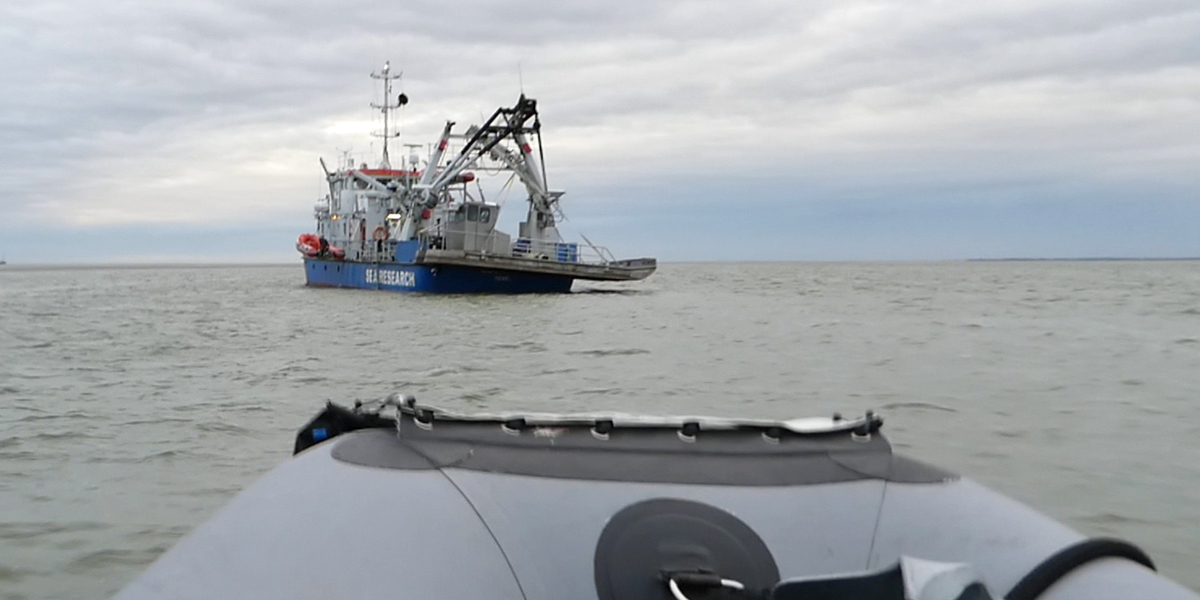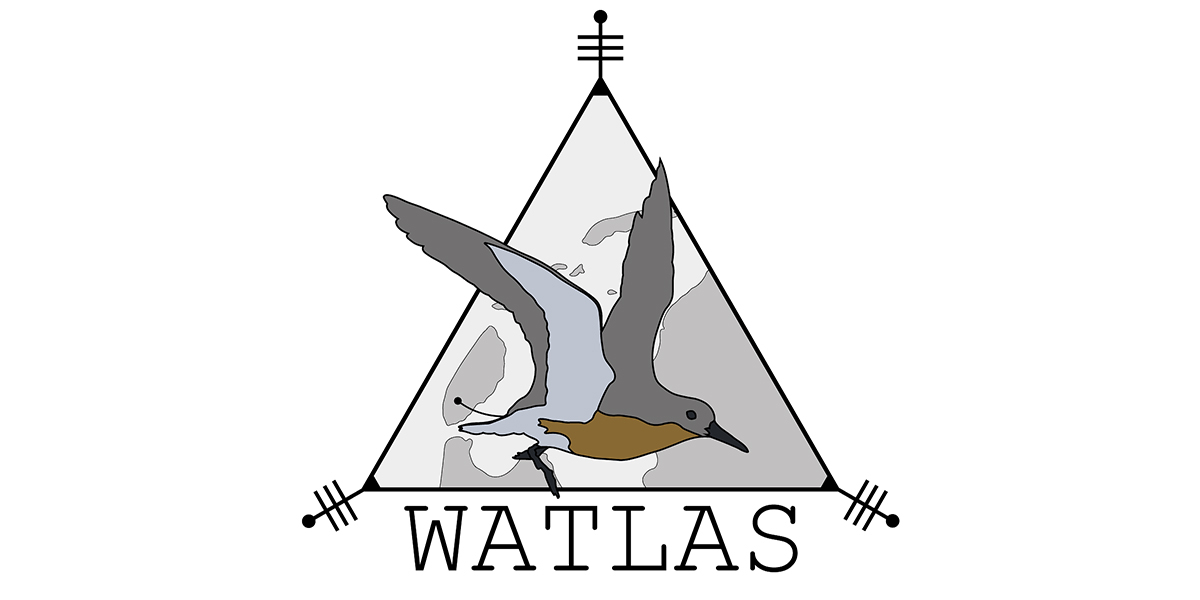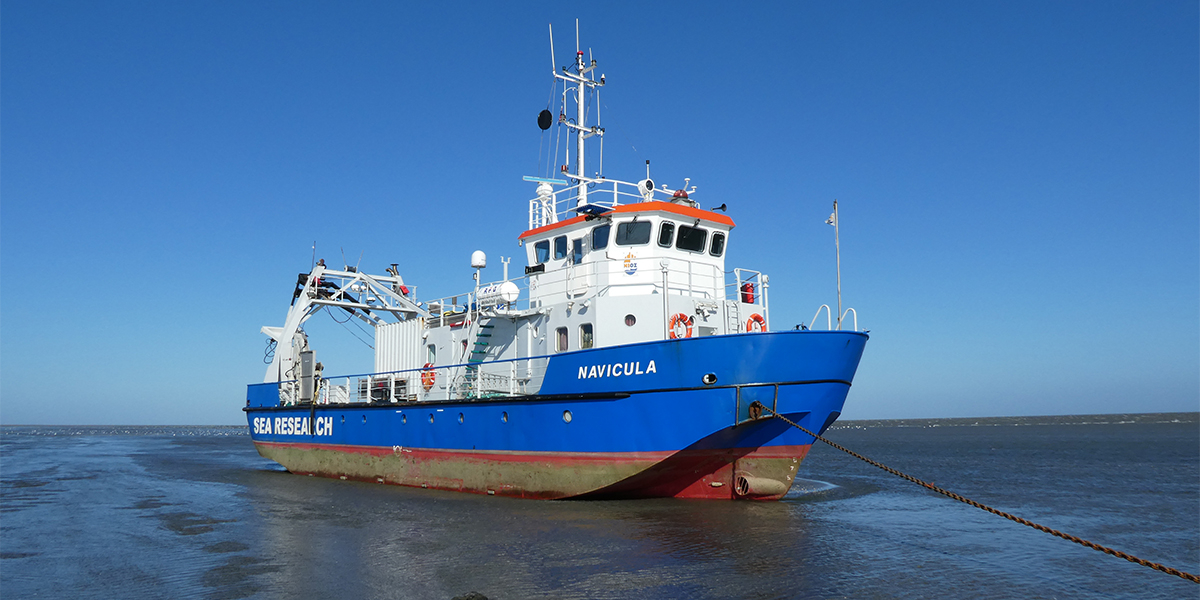WATLAS uses a novel tracking method that allows for smaller and cheaper tags. These tags are temporarily attached to the birds’ backs and transmit a signal every 6 seconds. Positions of the birds are then calculated from the differences in signal arrival-times at receiver stations. In 2017, we started WATLAS with a pilot study and 5 receivers. Now, in 2020, we have 26 receivers that allow tracking shorebirds in a large part of the western Dutch Wadden Sea in real-time. An important aspect of the WATLAS fieldwork is constructing the temporary receivers on the mudflats. With this blog, the WATLAS team will share their experiences and show what field work they do.
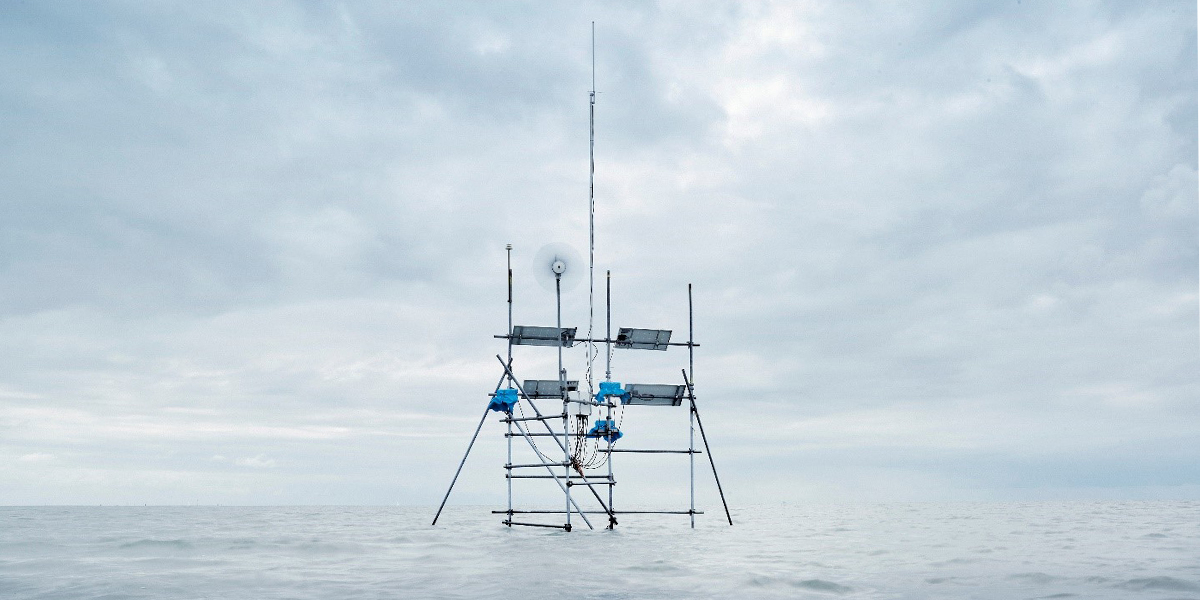
Monday 2 to Friday 13 November | Ending the fieldwork season
Before ending the fieldwork season, there were still a couple of important things to do. Firstly, resampling the resource landscape. Remember the SIBES sampling expedition that took place back in July? Basically, we want to see how much and what type of prey the red knots have eaten away 4 months later.
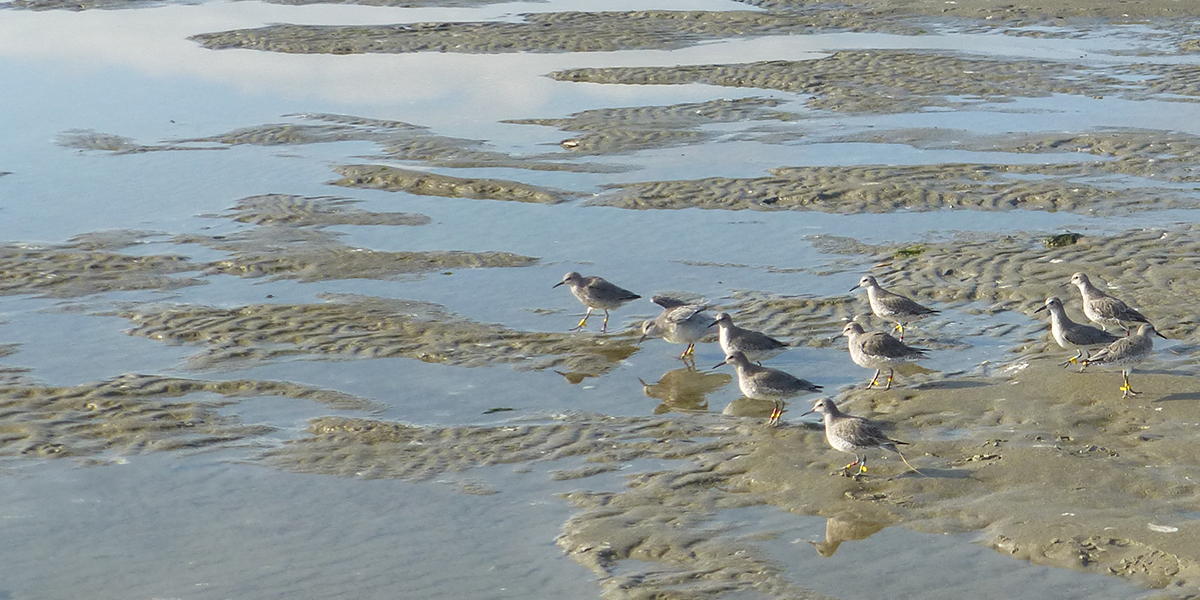
Secondly, removing the temporary receivers on the mudflat. Why do we do this and not simply leave them there all year round? Well, because in case of ice (which however is unlikely with the current climate crisis), the scaffolding tubes could break, and we would lose all the equipment. So, every year at the beginning of the season we need to build the receivers that we disassemble before winter comes. On Monday 2 November, Anne, Job, Maureen, and Jasper sailed to Griend with the RV Navicula to accomplish these tasks. Midway the expedition, Martin came on board to replace Jasper who went back to the NIOZ lab to analyze the approximately 300 benthic samples that they collected. Eventually, after a little more than a week, 11 receivers were taken down, and they all went back to Texel.
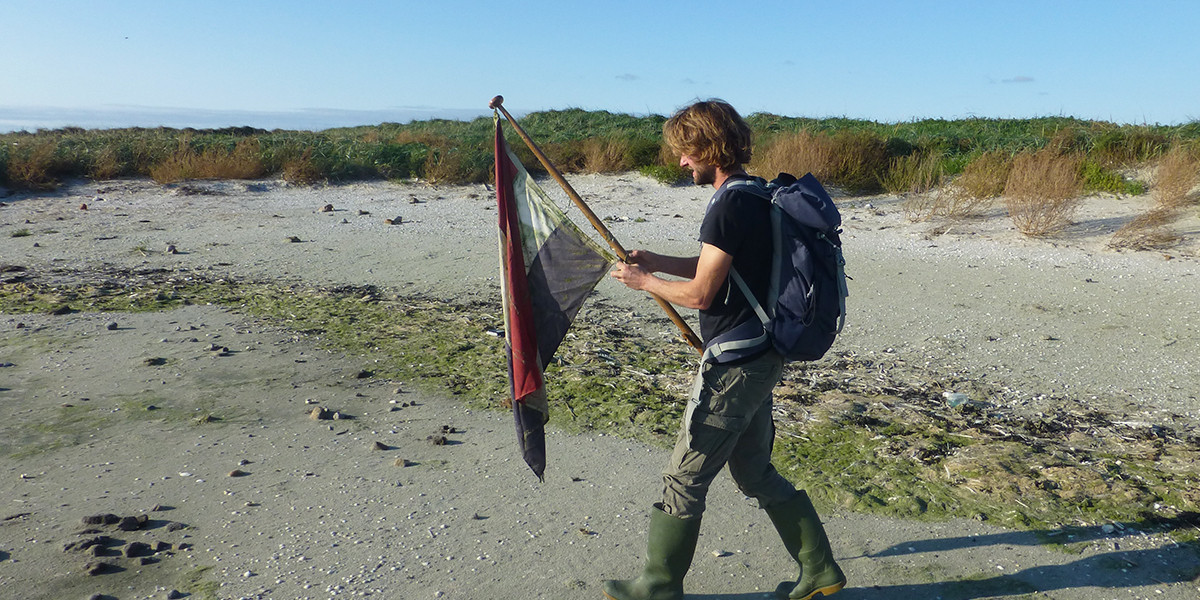
With these last successful expeditions, the 2020 field season comes to an end. We are all curious to discover new insights about the knots by analyzing the many data collected this year, which was possible thanks to the effort of many researchers, assistants, and students, even with delay and restrictions due to COVID-19. Stay tuned and, in the meantime, enjoy this video about the WATLAS fieldwork, made by MSc student Aileen Roncoroni.
Friday 16 to Friday 23 October | A surprisingly number of knots
To resume what happened, Allert, Luc, Kelly and Hans arrived on Griend on the 16th of October, and that same night they caught 19 knots. The following day, Luc and Allert took care of the processing of these birds, while Kelly and Hans conducted the behavioural measurements. At the end of the day, all the individuals got tested and were released with coloured rings and tags. Then, on the second night, they caught a surprisingly high number of knots: 80! Out of them, only a few got tested because of time constraints. Still, all of them were given coloured rings, and half of them got tagged as well.
On the third and last catching night, another 47 knots were captured, and very interestingly, four starfish were also found hanging in the nets. These starfish were probably regurgitated by a Herring gull that had flown in the net and escaped. The fourth day was also busy with many captive birds to process and test; moreover, Anne arrived to replace Allert. The next four days were frigid, with extreme winds (up to Beaufort force 10) that hindered doing the behavioural assays. However, Kelly and Hans managed to efficiently test about 15 birds every day. After a week on Griend, all the work was completed successfully and they all headed back to Texel on the 23rd of October.
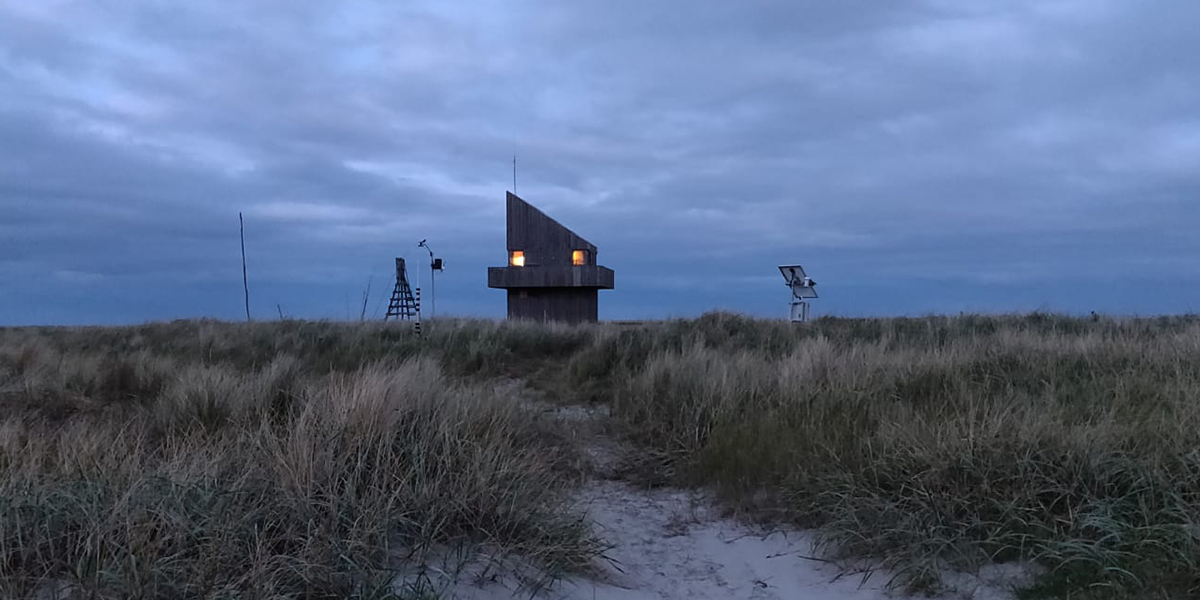
Thursday 24 to Monday 28 September | Till next month
Having birds in captivity, our working days have been long with minimal time for writing blogs. Therefore, we decided to combine the last days of this successful catching expedition into a single blog post.
Aileen and Selin have conducted an amazing total of 112 behavioural assays in five days. In each assay that lasts about 15 minutes, the exploratory behaviour of the captured Knots was measured. How do these trials work?
First, we catch an individual from the holding tents; we measure its mass and hold them separately for one hour to habituate. All birds get the same treatment to standardise the behavioural measurements. When it is time, we start recording with the two cameras installed inside the experimental unit and gently put the bird on one of the four patches in the experimental unit. Then, we close the door and take note of the starting time as well as the temperature (there is a small thermometer inside). 15 minutes later, the trial ends, we turn the cameras off and switch off the lights. Next, we go into the unit to catch the bird. To catch the birds in the darkness, we use a red headlight. The tested bird is then ringed with a unique colour combination on its legs. We also attached a tag on its back, to be able to follow its journey after the release. Once enough birds have gone through the whole process, with low tide we go to the beach and release the Knots in groups. Back at NIOZ, Selin will run the videos through a video processing algorithm to automatically extract movement and asses the birds’ exploratory personality. The following video summarises the procedure explained above.
Everything went quite smoothly except for a couple of mishaps. For instance, we had to repeat the trial in case the bird jumped into the water to preen and bath. That happened only a few times, fortunately. Moreover, at some point, the water started to leak out from the experimental unit, so we had to repair the hole and then go to the sea to fill five 20L jerry cans with saltwater, to replace it. At least, the weather has been better than predicted, and only one day was characterised by strong winds and heavy rain.
Monday was our last day on Griend: we packed everything and cleaned the hut. Wim-Jan picked us up with the RV Stern and took us back to Texel. We can absolutely consider this fieldwork expedition successfully concluded and looking forward to the last WATLAS catching expedition next month.
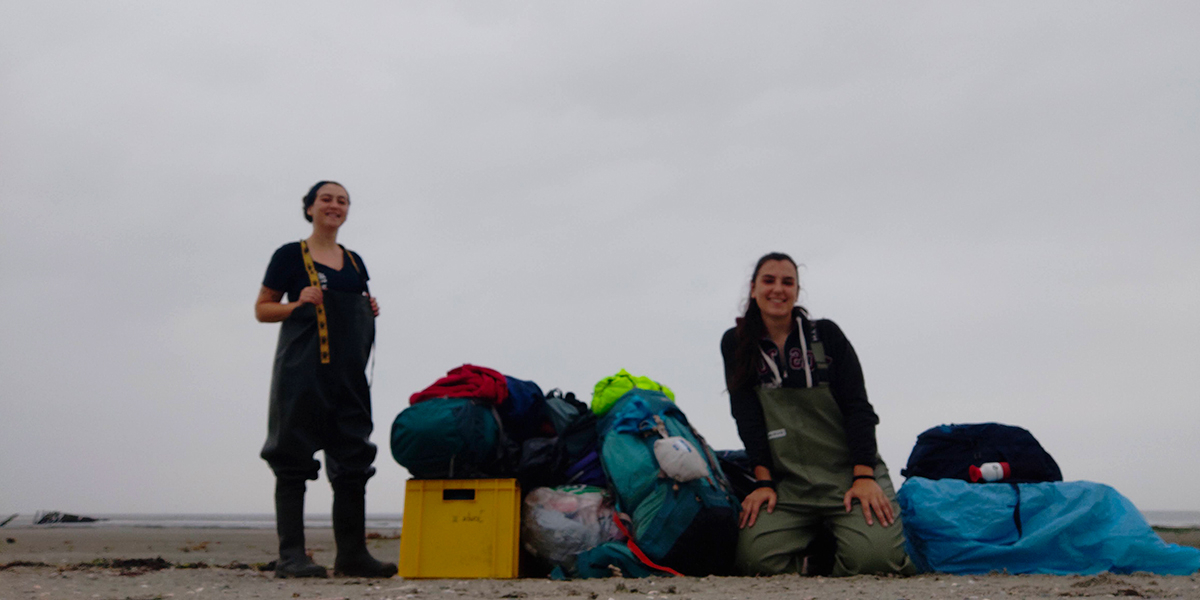
Wednesday 23 September | Final days (for most)
Everyone was feeling tired this morning because in the last three days we have only slept for a few hours every night. But at the same time, we are delighted about this fieldwork session, as we caught a total of 116 Red Knots!
Like yesterday, Selin and Aileen were occupied with the behavioural assays while Allert, Job and Anne were processing the birds that we captured a few hours before.

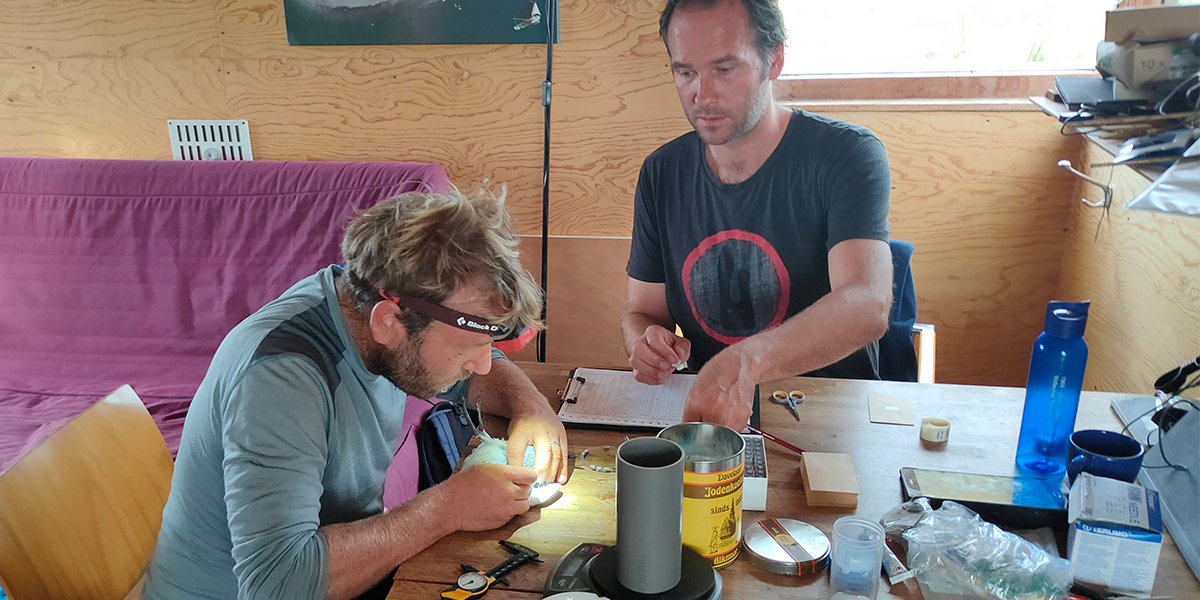
In the afternoon, Anne, Job and Allert took the nets down because we concluded the catching for this month. Later, they also packed their things because this was their last day on Griend. Selin and Aileen will remain on the island for some more days to complete the behavioural assays, and release all the remaining birds with colour rings and tags.
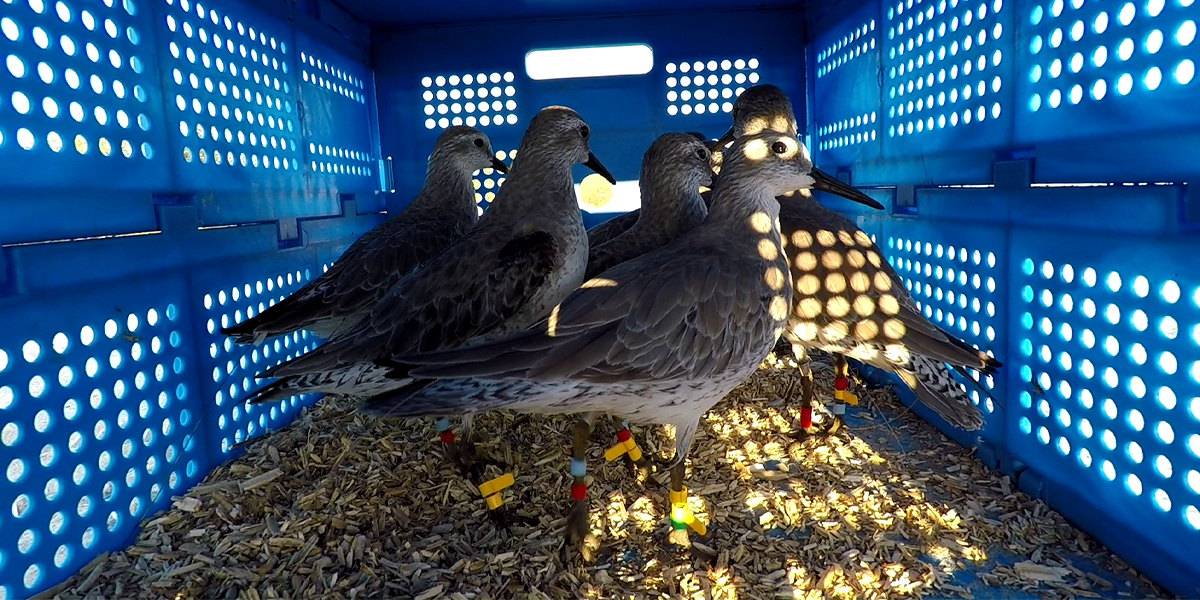
In the evening, we could finally take a shower after a full week: the quantity of water on the island is restricted, so we need to limit its usage as much as possible. We went to sleep early because we really needed to recharge the batteries. The coming days might be tough as well because a storm is expected from tomorrow on, so wish us luck!
Tuesday 22 September | Why do birds differ so much?
It was another extremely busy day on Griend: we had to process the newly captured Knots, and it was also time to start testing the exploratory behaviour of the birds caught Sunday night. On top of that, the film crew was still on the island to film our research.
To work more efficiently, we divided the tasks once again, and the day ran smoothly. Allert, Job and Anne took charge of processing the new birds. Excitingly, two of them have already been captured in the past, and we could compare the various measures.
In the meantime, Selin and Aileen prepared the experimental unit to conduct the behavioural assay.

They observed incredible differences between individuals. Most birds are inert during the whole trials, but others instead are highly active and continuously move from a patch to the other, like the one in the video below.
Why do birds differ so much? Previously, we had found that exploratory birds are smaller, have larger flight muscles, and prefer to eat high quality prey. Now, by tagging them before their release, we would like to investigate whether exploratory birds are also exploratory in the Wadden Sea.
At the end of the afternoon, we tagged and released seven tested birds. It is extraordinary to watch them leave freely, and we are thrilled to know where they are going to fly now. We cannot wait to follow their journey on WATLAS!
At 22:45 we left the hut for the third night of catching in a row. As we were waiting before checking the nets, the sky gave us a stunning show of shooting stars. Later, while we walked on the mudflats with the upcoming tide, we enjoyed the magic of the water sparkling again. We can consider tonight's catching fulfilled too, as we caught 29 more Knots.
Monday 21 September | Hectic and magical
After only five hours of sleep, we woke up knowing that a hectic day was laying ahead of us. After breakfast, we arranged an efficient "assembly line" to process the 49 Knots that we caught the previous night. Selin and Job were in charge of ringing, weighing, taking biometric measures and blood samples; while Aileen and Anne were doing ultrasounds to measure the pectoral muscle and the gizzard.

In the meantime, Allert was guiding an international film crew from ARTE around the island to show them our work. They will make a documentary about bird migration, and how these birds connect different people from different countries all around the world.

Thanks to the excellent coordination of the team, all the birds were processed after only two hours. Aileen, Selin and Allert set up five tents to host the birds for a couple of days until their personality assay (behavioural measurements). Each holding tent contains 10-12 birds, two fresh water trays and a plate of delicious mealworms.
Timelapse of building holding tents for the birds
In the evening, we had some time to rest and prepare ourselves for another night of catching. It was foggy and cold but not windy at all. The calmness of this night was such a contrast to the stormy weather that we had only a few days ago. On our way to the nets, wading through the water, we saw a lot of “sea sparkle” (zeevonk) – an algae that lights up when you disturb it. The combination of the calm weather, fog and sea sparkle made it a magical experience. At the end of the night (4 am), we looked back at another successful catch with 38 Red Knots!
Sunday 20 September | A quiet night, finally
Today it was a peaceful and quiet Sunday on Griend, looking forward to a (hopefully) successful night of catching. In fact, we spent most of the day in the hut doing computer work.
After an early dinner, we went for a walk on the mudflats south of the island, and we brought our scopes with us in the hope of observing some Red Knots. Unfortunately, we did not spot any; however, we enjoyed an incredible sunset over the Wadden sea.

Back at the hut, we checked the weather forecast one more time, and it finally looked good for catching! After dressing in warm clothes, we left the hut around 22:00, and we walked, in the total darkness, towards the nets that we set up a few days before. Once we opened the nets, it was only a matter of waiting.
We laid down to hide in the dunes next to the beach. Being surrounded by the complete dark and only the sound of birds, under a sky full of stars, is a surreal experience! One hour later, it was time to inspect the nets for the first time: we caught about 10 Red Knots. After waiting for another hour, and getting quite cold, it was time for another and final check. This time, we found even more birds in the nets reaching a total of 49 Red Knots captured!
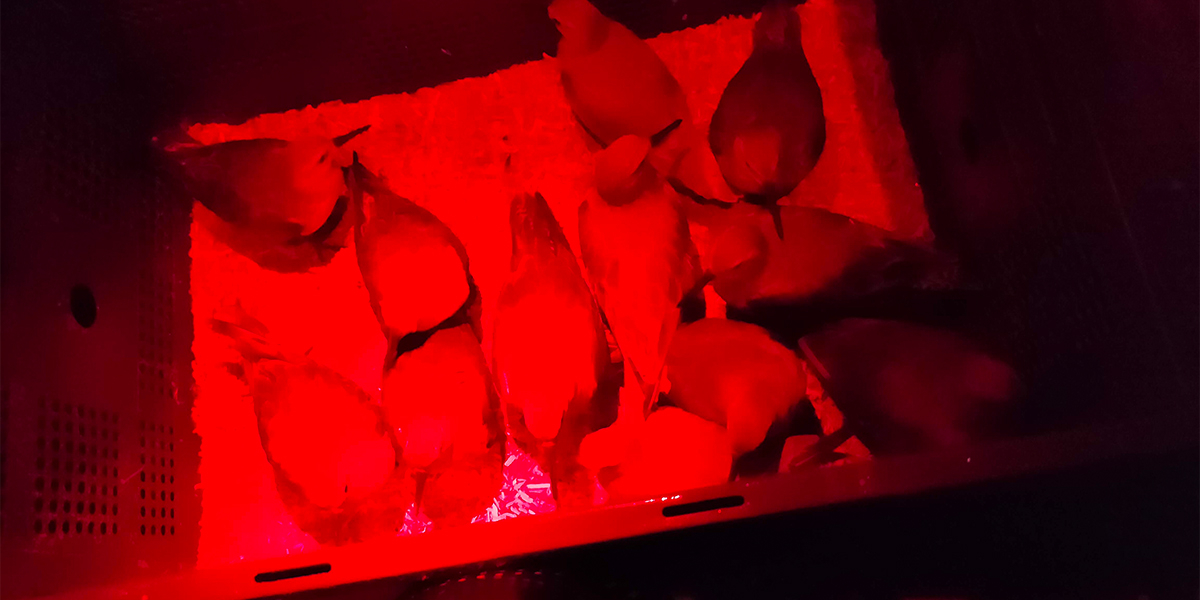
After the successful catching, we went to bed at around 3:00 in the morning, tired but extremely pleased.
Saturday 19 September | More counting and reading rings
The third day on Griend, with still no birds caught, was relatively calm. In the morning, Selin and Aileen remained in the hut, working on manuscripts and data analysis. While Anne inspected the nets, Allert and Job did a roost-count for the SOVON monitoring series.
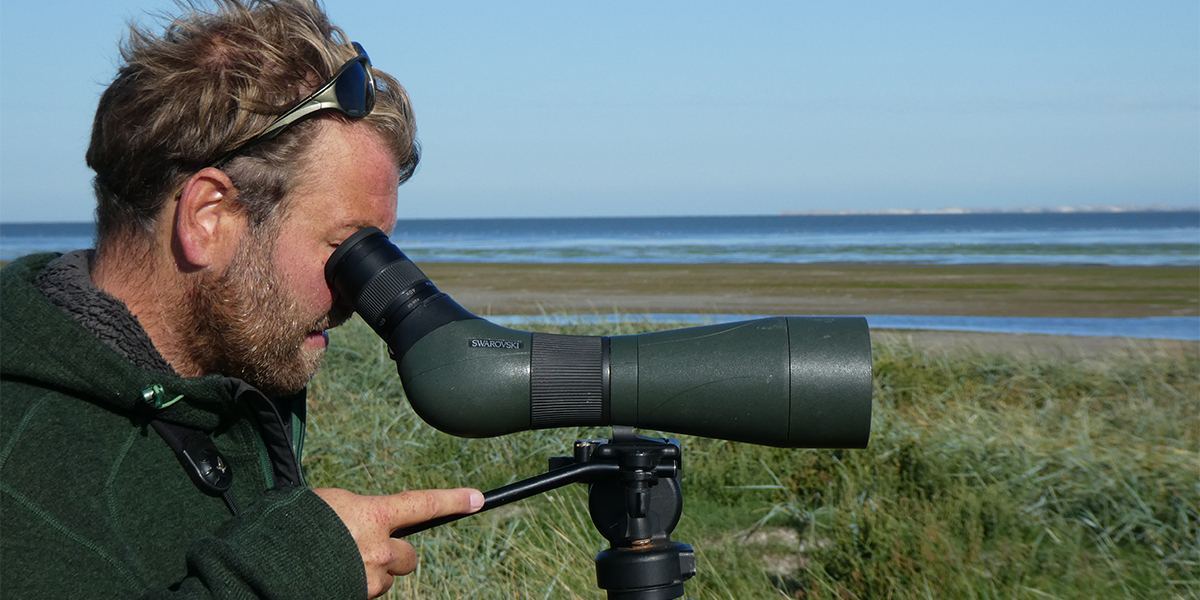
They counted 32 species around the island. The most abundant species this time were Dunlin (14,000 individuals), Oystercatcher (12,000), Red Knot (11,000), and Black-headed Gull (7,000). One of the highlights was seeing about 30,000 shorebirds packed together at a small sand spit. When a greater-blacked backed gull attacked (and consumed) its sleeping neighbour – an unsuspecting black-headed gull - all birds flew into the air and gave us a spectacular air show.
After lunch, it seemed a good time for colour-ring reading. From the height of the hut we saw plenty of Red Knots on the mudflats north of the island. After walking for almost two kilometres with our scopes, and stopping every now and then to observe small groups of birds, we found a large flock that was ideal for ring reading.
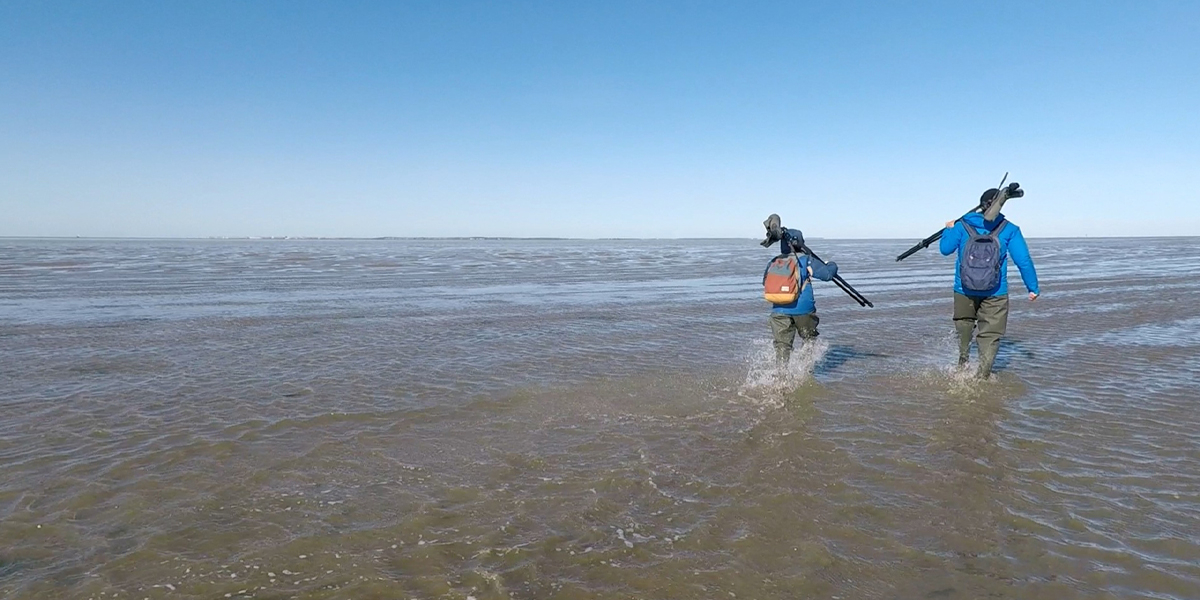
Reading the small colour-rings on their legs is not so easy with such strong winds. This time it was even more challenging because they were mainly sleeping and standing on one leg, and they were hiding their colour rings in pools of water that remained on the mudflat after low tide. Still, Selin, Aileen ad Allert were able to identify 16 knots. Job had also gone out for ring reading. He went further to the north east of the island and was able to identify about 40 knots, individuals that that he himself had caught and colour-ringed in previous years.
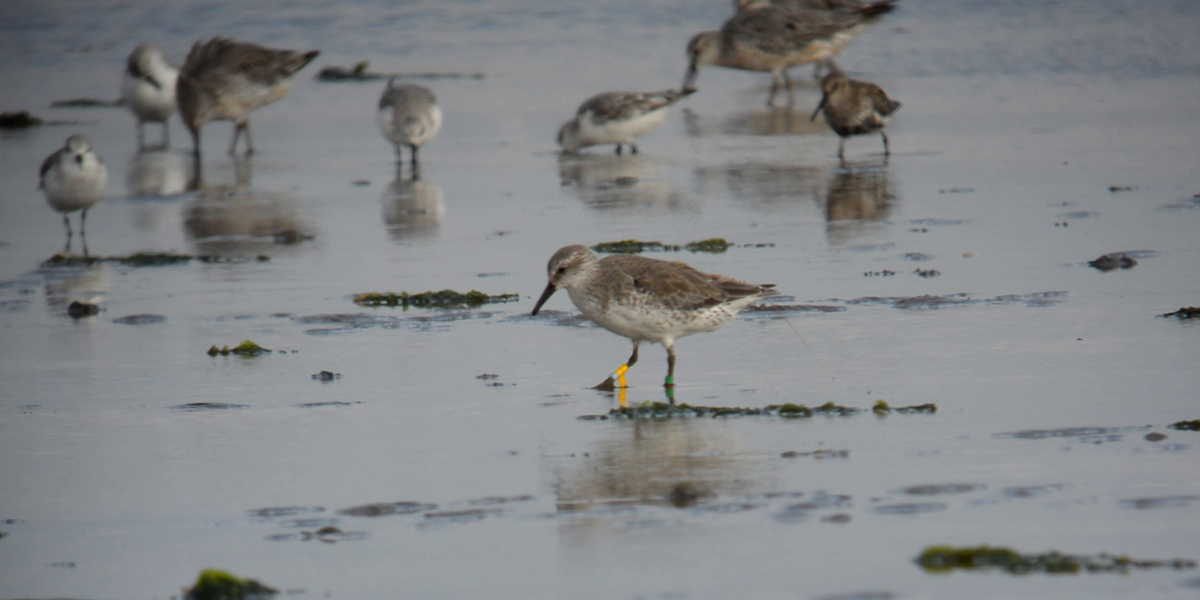
As soon as we got back to the hut, we had dinner as we discussed the possible catching attempt for the coming night. Different wind models gave different predictions, and we hoped for the most favourable outcome. However, the wind did not drop and towards midnight catching was cancelled. Tomorrow seems a little better, but unfortunately not good either. Fingers crossed!
Friday 18 September | Another windy day on Griend
Today we woke up to a sunny but still windy day on Griend. The morning has flown by between attending online meetings, lively discussions on understanding animal behaviour, writing scientific papers, and data analyses. In this extremely inspiring environment, it is great to work together and share ideas and knowledge about Red Knots' exploratory personalities and social foraging.
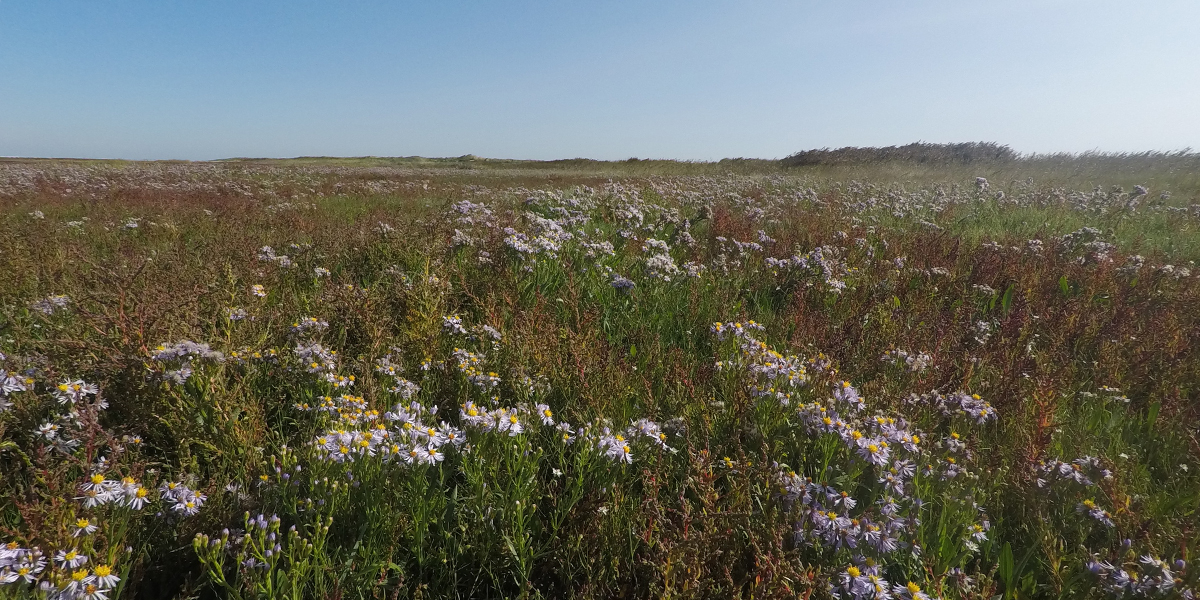
In the afternoon, we took advantage of the sunny weather and the low tide to walk on the mudflats for some colour-ring reading. We saw a lot of Red Knots and, excitingly, we spotted two tagged individuals that were also visible on the WATLAS live tracking!
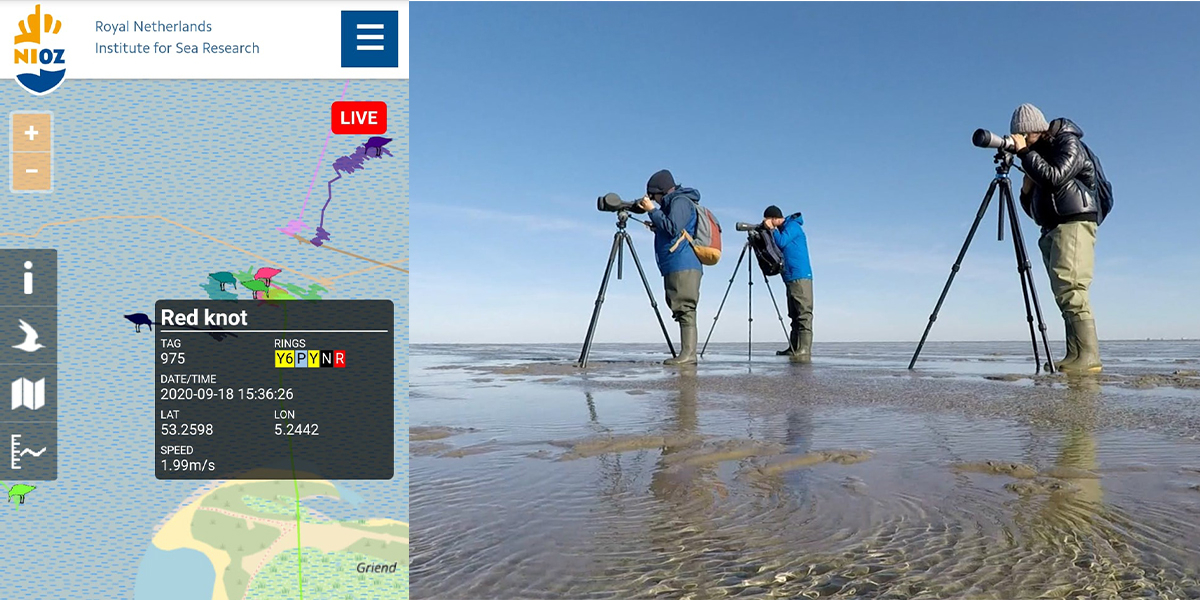
Interestingly, one of them was kept in captivity at NIOZ for behavioural observations during the past year and was released just about a month ago here on Griend. After working with these birds in captivity, it is truly a fantastic experience to observe them feeding and preening in their natural habitat. We noticed that most of the birds have a winter plumage by now, and only a few still need to moult the red plumage, which is typical of the summer breeding season.
On the way back to the hut, we stopped many times to inspect the mudflat, and we found plenty of cockles of various sizes, but also other benthic organisms like shore crabs, shrimps and mud snails. Small cockles are one of the preys of Knots, and they need about 6,000 cockles of 7 mm per day to meet their energy requirement! Very impressive, right?!
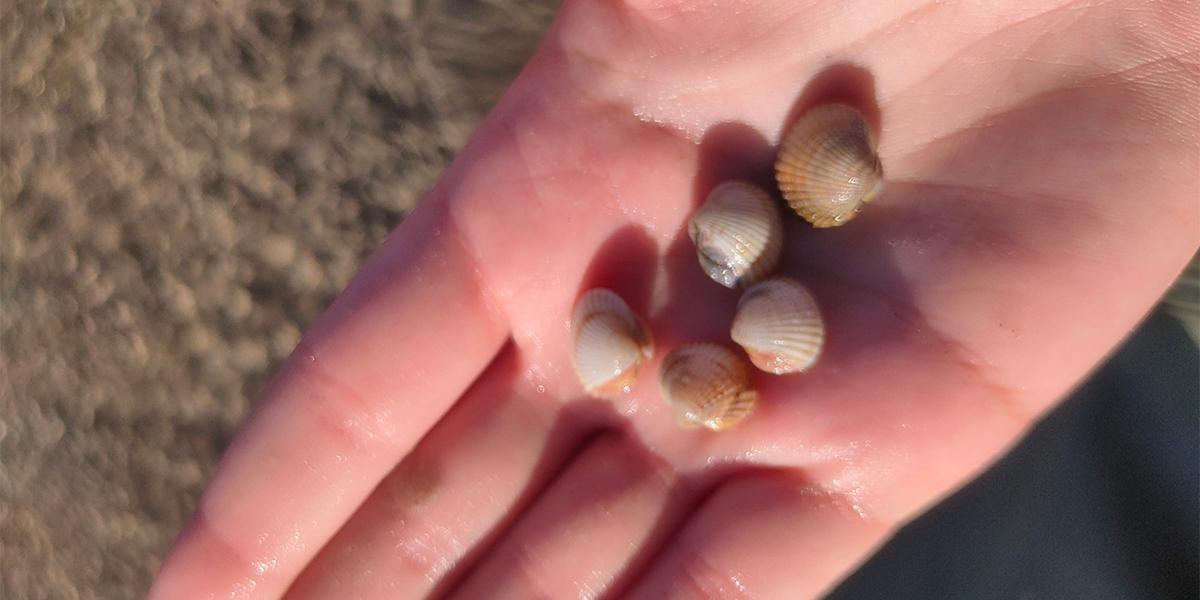
Once again, we need to postpone the night of catching due to the strong winds, and according to the weather forecast, the first suitable night seems to be Sunday - if we are lucky.
BLOG 17 september | Third catching attempt
By Aileen Roncoroni
It is finally time for our third (and hopefully successful) catching attempt of the year! Once again, we travelled in two separate groups, because of corona regulations: Job and Anne left Texel this morning at 7:00, and they reached Griend with the RV Stern, with all of our luggage and equipment. While Allert, Selin and Aileen travelled to Harlingen, got picked up there with the RV Stern and arrived on Griend at noon.
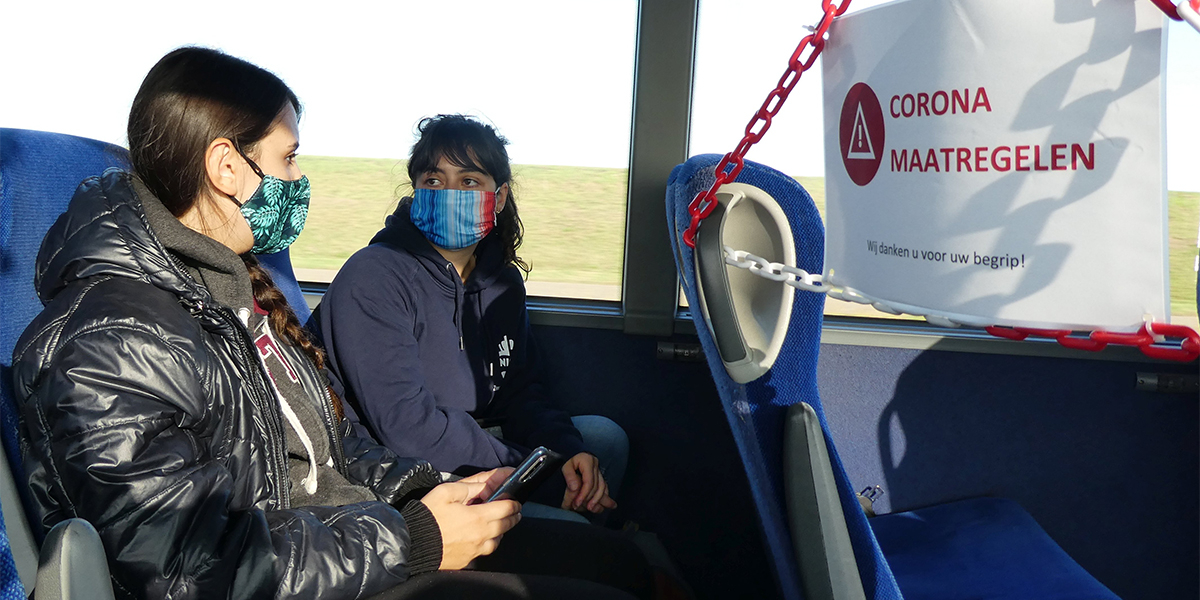
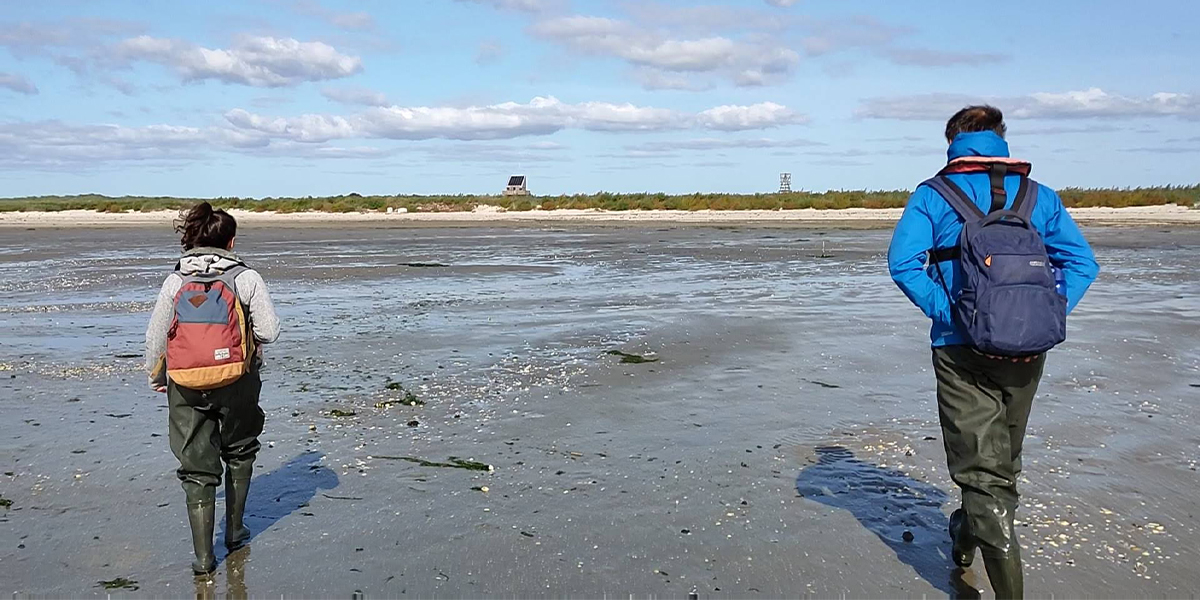
During lunch, we discussed the possible locations where to set up the nets later in the afternoon. To get an idea of where there are high chances of catching the Knots, we consult the WATLAS tracking data of the night before, and because we saw that many birds were flying over the south of the island, that is where we went!
After setting up the mist nets for catching birds in the evening, we went back to the hut and cooked dinner. Of course, the Italian of the team prepared a delicious pasta that we ate while enjoying a beautiful sunset.
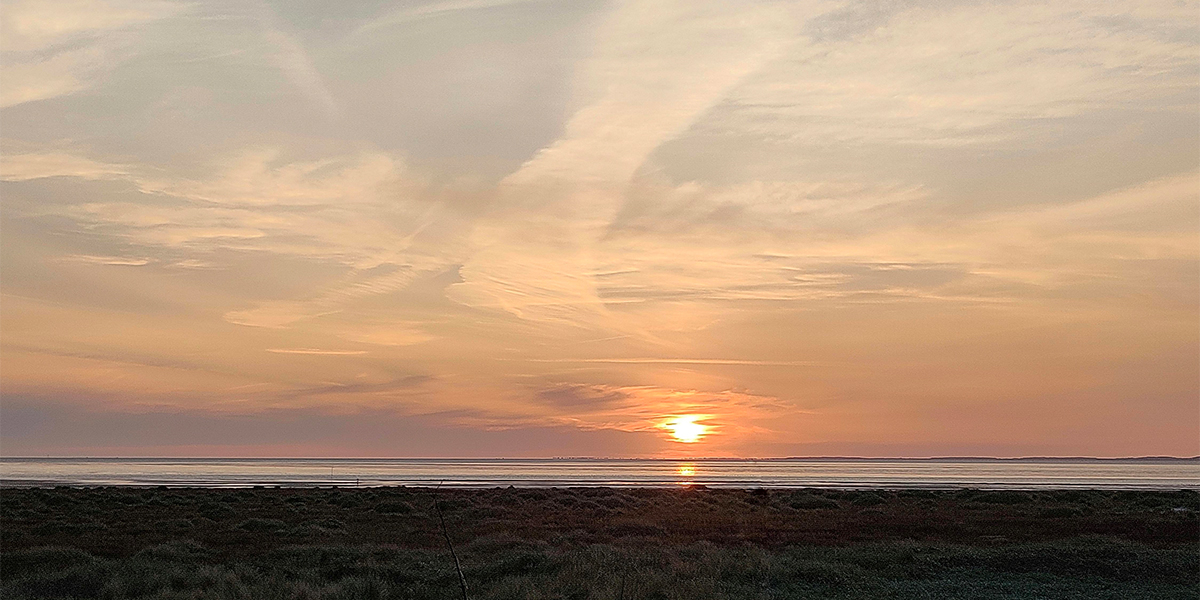
Unfortunately, the weather became particularly windy at the end of the evening, and it would be risky to catch birds in these conditions. Hopefully, we will have more luck tomorrow.
BLOG 26-28 August | Personality tests
Friday 28th
Today was our final day on Griend and the morning was very busy. The first bird was tested at 6.30 am so that we could finish testing the five remaining birds in the morning. While Robbi and Selin tested the birds, Evy and Christine took the aviary tent to the sea to wash it, ready for the next birds in September. As the testing came to an end, Emma received a call to say that the Natuurmonumenten beach clean-up crew were arriving on the island and that they would like to visit. Outside the hut, Emma explained to the group (in Dutch) what we were doing there and gave a bit of background information. They seemed interested in the work and how the researchers lived on the island and asked a few questions. After they had left to start the beach clean-up, we tagged and released the knots.
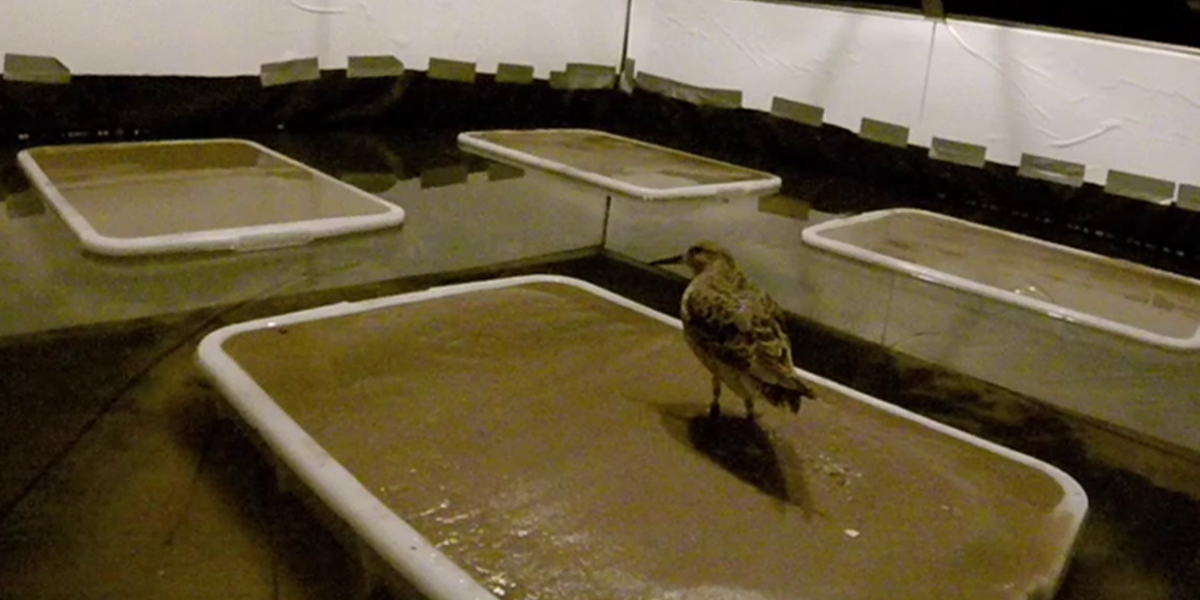
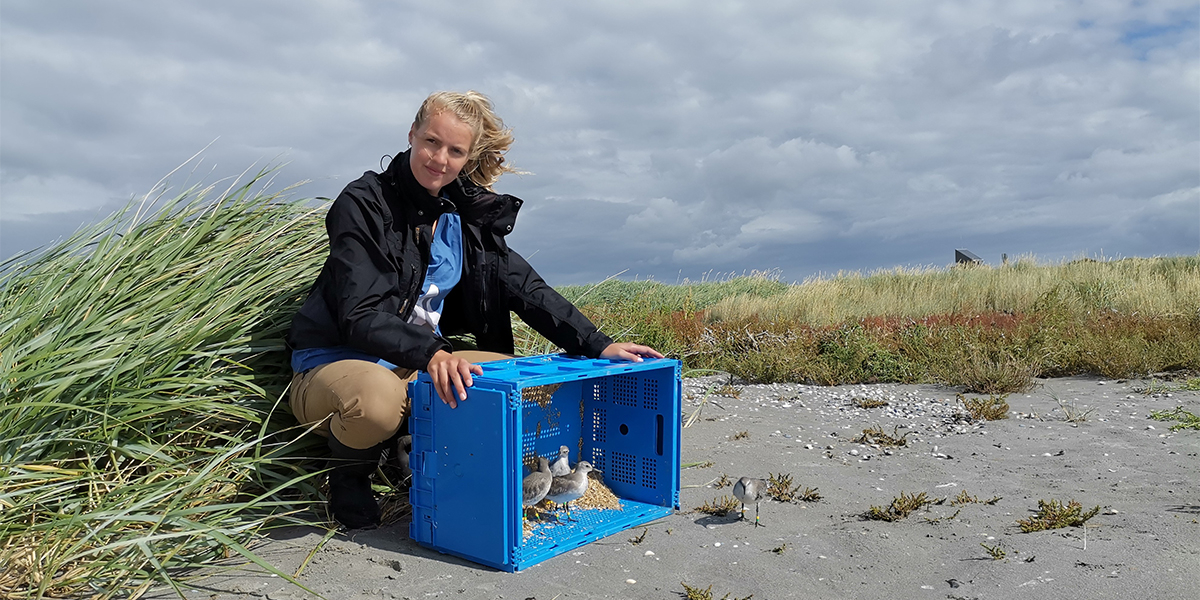
We started moving our belongings and the remaining food to the shoreline where Wim Jan was to pick us up with the Stern. The tide was low so there was a long walk to the Stern. Wim Jan had brought the remaining birds from captivity to be released, so we swapped our bags for the birds and went back to the beach to release them. All birds flew off well and so we began our journey back to Texel and arrived home at about 6 pm.
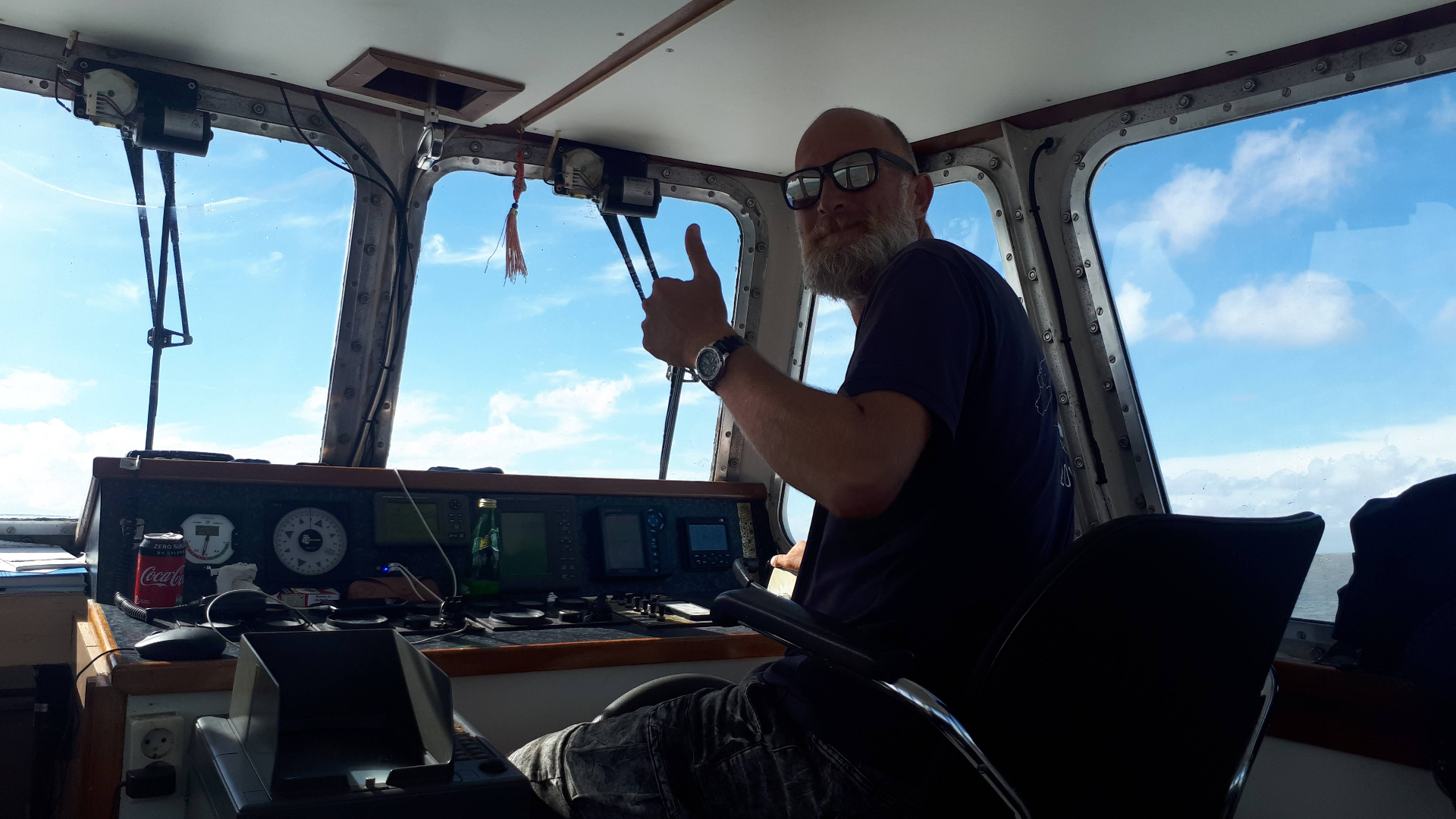
This catching expedition was not as successful as we hoped, but were able to catch and tag 14 red knots. Hopefully, our next expedition with half September will be more successful.
Thursday 27th
Everyone was up early this morning. For the behavioural assays, Selin must take one bird at a time out of their aviary and into a crate for two hours before testing. This is to acclimatise them to being alone (briefly) so that they are calm while in the testing arena. The birds were all fed some tasty mealworms at 6 am and then at 6.30 am the first bird was taken out so that testing could begin at 8.30 am. Considering the bad weather the day before, the birds were relatively calm and were eating well. In fact, the fourteen birds that we had caught had gone through almost 4 kg of mealworms in just two days! It seems that these individuals were taking their job of fattening up for the winter quite seriously.
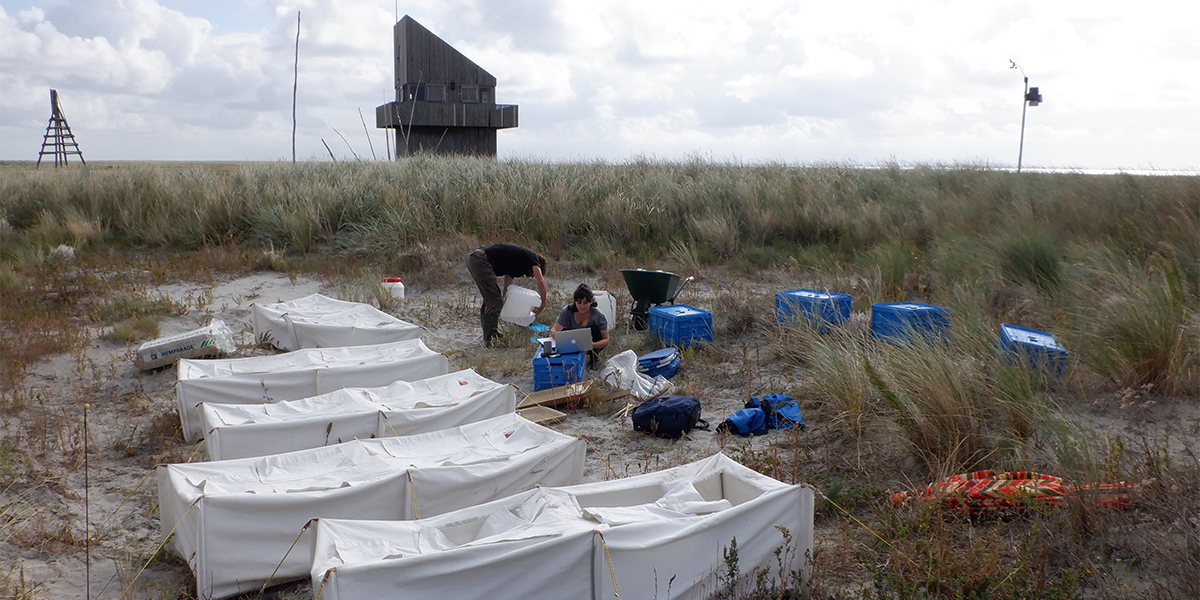
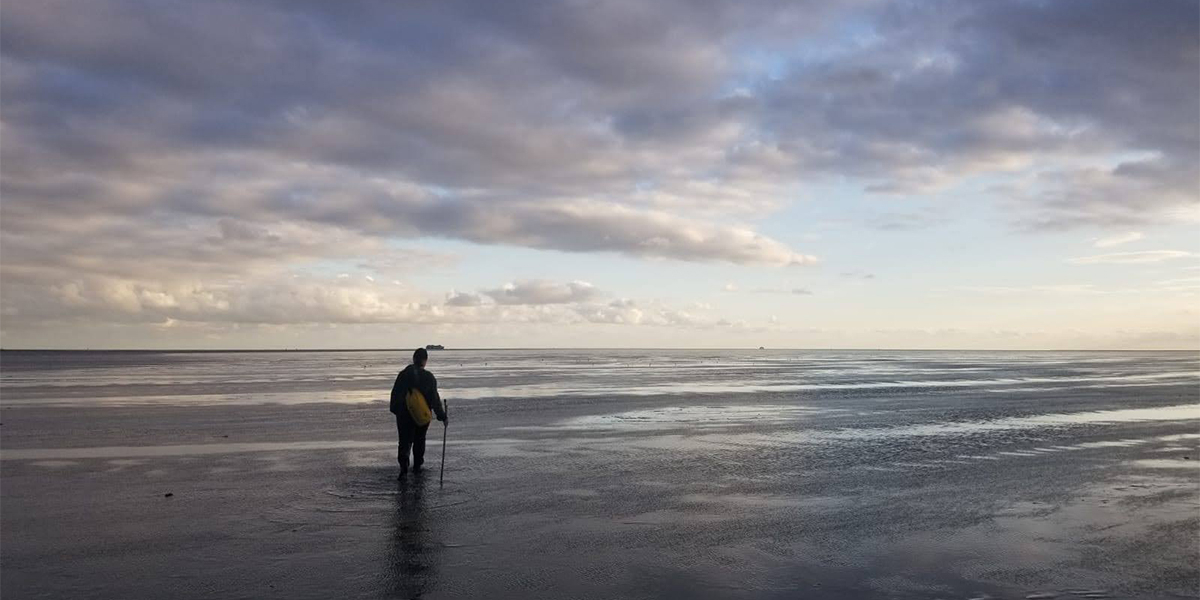
Just before low tide at 7.30 am, Evy and Christine headed out to collect the remaining WATLAS validation data from the mudflat to the East of the island. They walked 23 km in total and passed some of the receiver stations on the way. On their return, Selin and Robbi were testing the last few birds for the day. With the weather so calm, very few noises could be heard so the testing was going well and the birds were exploring the arena as we had hoped.
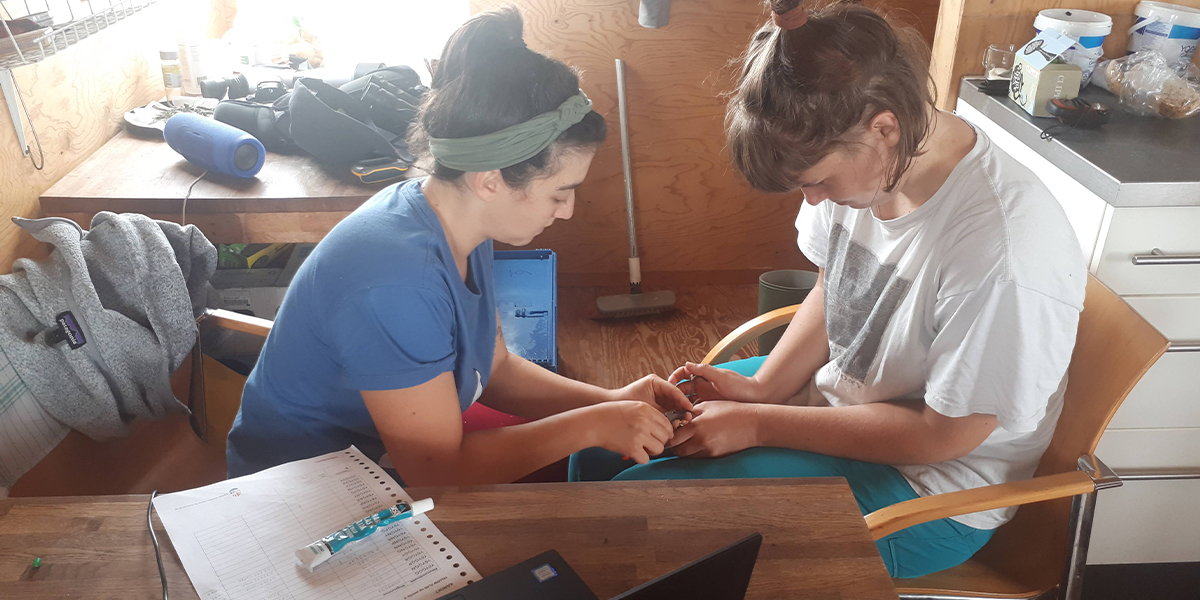
At the end of the day, the nine adult birds were colour-ringed and released with a WATLAS tag, but Selin wanted to retest the younger birds the following day. We had caught one juvenile (that had hatched on the Arctic tundra only a couple of months before) and four second calendar year birds (that were just over 1 year old). We can tell how old a bird is through its plumage. Juvenile birds have grey feathers with a lighter coloured fringe on their back. Second calendar-year birds also have a greyer plumage because they skip the breeding season and partially moult into their red breeding plumage. Also, they start moulting into their winter plumage well before the adults. A grey bird with a more advanced moult in august is therefore likely to be a second-year bird. While Selin and Allert have previously found the exploratory behaviour of adults to be highly repeatable, the younger birds seem to be more flexible in their behaviour. Retesting the young birds the next day on the same task will give us an indication to when juveniles lose their flexibility and understand the development of consistent behaviour (personality) in the wild.
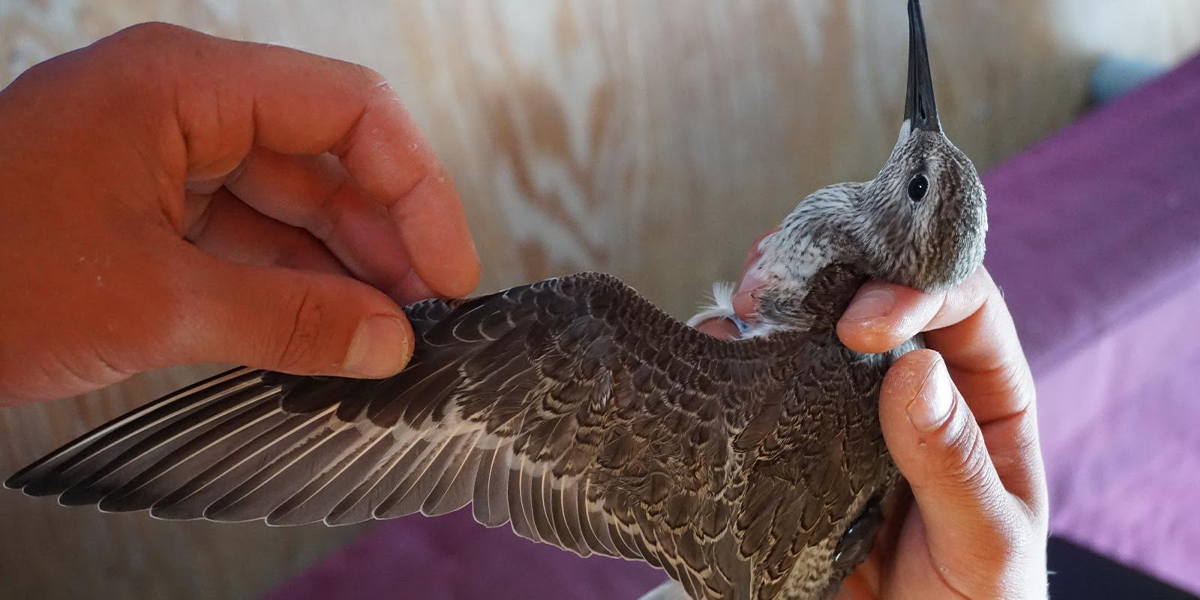
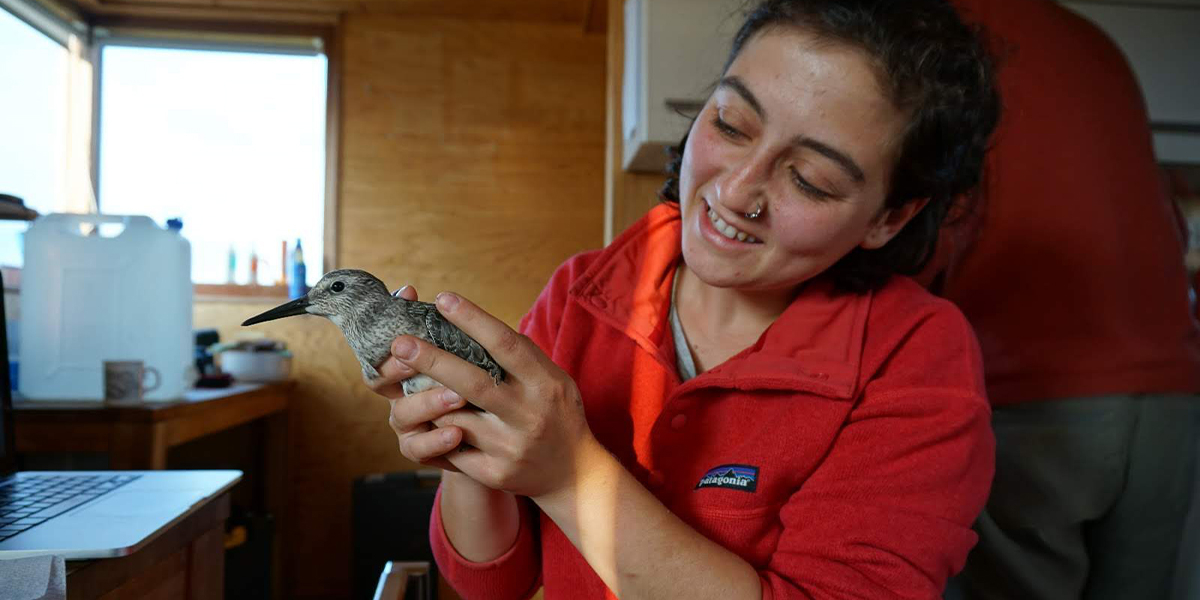
BLOG 21-25 August | Stormy weather
By Allert and Christine
Tuesday 25th
Today was the last day for the Navicula team at Griend. Having originally planned to leave on Wednesday, a large storm was on its way and since another night of catching looked impossible, it was better to get the Navicula safely back to the NIOZ harbour. After a couple of hours of sleep, the Navicula team first went to take down the nets before heading to the Griend hut to process the birds.
During processing, Job and Anne are in charge. Job takes various biometric measurements of the birds, such as bill length, wing length and body mass. After arrival in the Wadden Sea, red knots moult from their red breeding plumage into their grey winter plumage therefore Job also assesses their plumage and moult stage. Finally, Job takes a small blood sample. With this blood we can extract DNA for determining the bird’s sex, and carbon and nitrogen isotope ratios for determining their past diet.
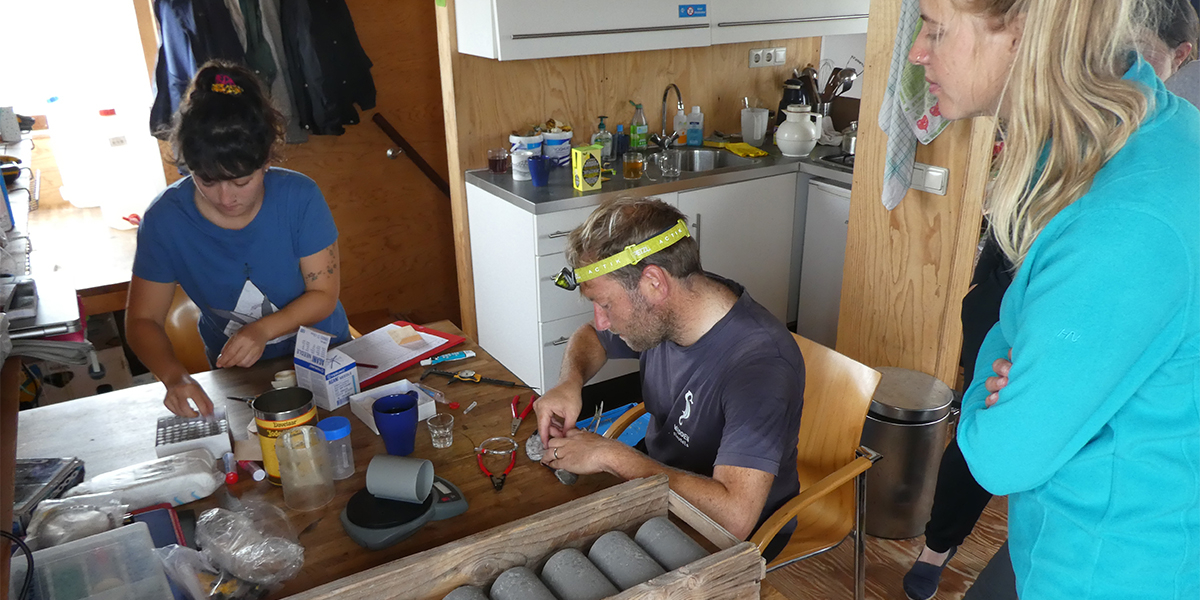
The birds are then given to Anne who uses an ultrasound machine to measure the size of the bird’s pectoral muscle and muscular stomach (the gizzard). Knots swallow their shellfish prey whole and crush them in their gizzard. We have previously found that the more shell the birds eat, the larger and stronger the gizzard becomes. This ultrasound technique has been pivotal to understanding how physiology and behaviour are linked in the ecology of shorebirds.
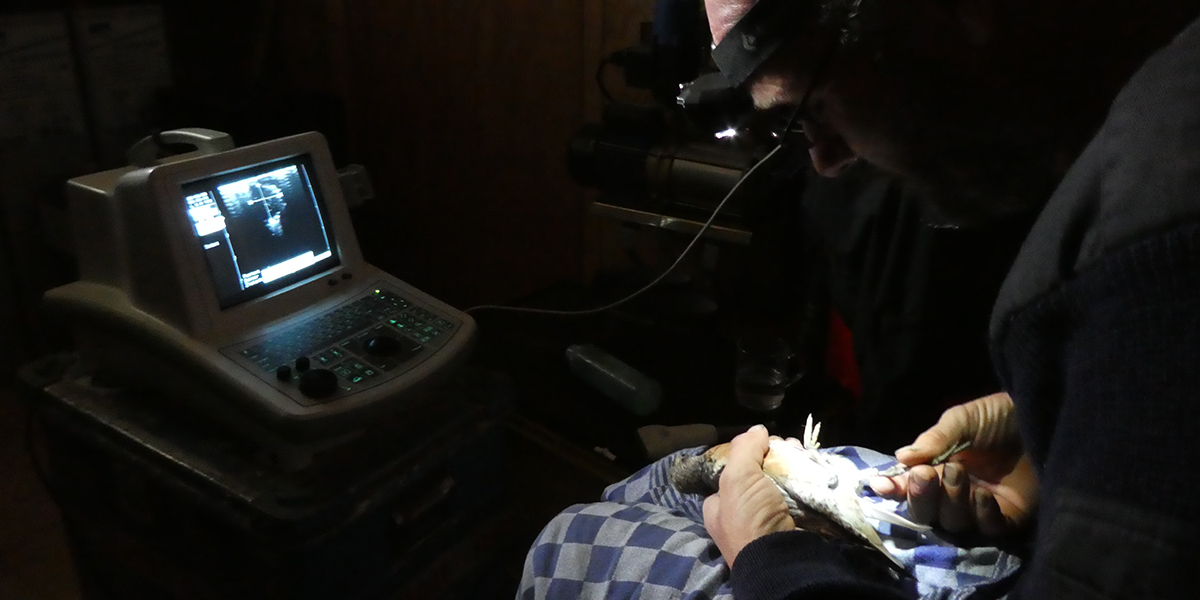
Anne and Allert then headed back to the Navicula to pick up remaining equipment. For example, the experimental set-up for testing the personality of the knots, and some more food and fresh water for those staying on Griend longer. After helping take some of the stuff to the field station, the Navicula team left and headed back to Texel. It was a bumpy ride with many of the passengers feeling rather seasick as waves crashes against the Navicula.
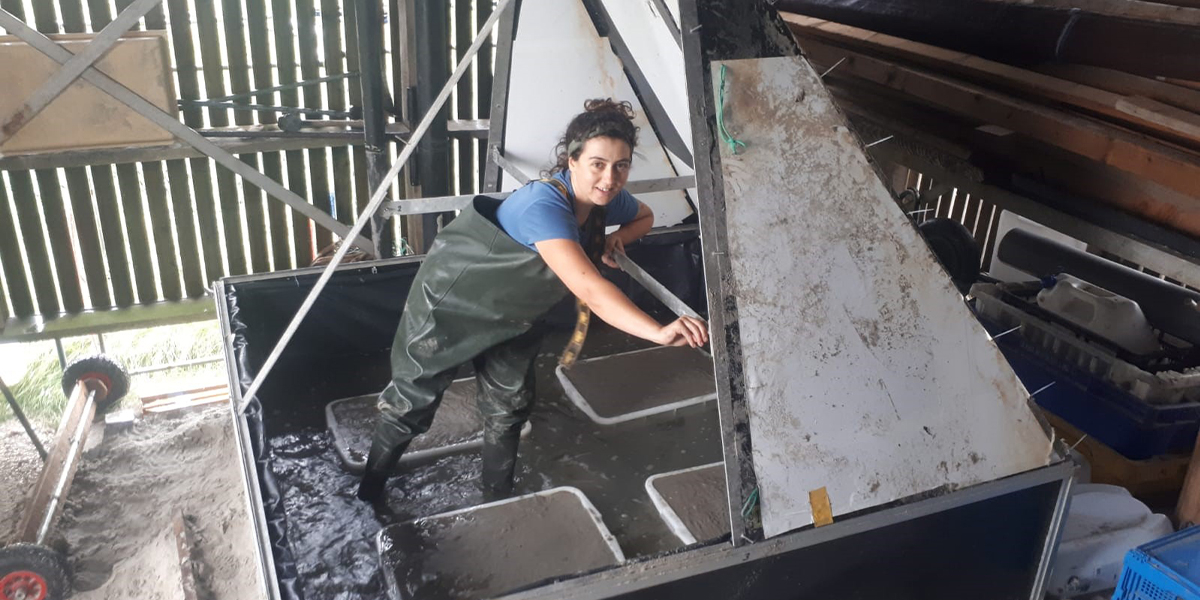
Meanwhile, on Griend, we (Selin, Christine, Emma, Evy and Robbi) continued to carry the rest of the equipment to the hut. We put up the aviary for the knots complete with hemp flooring and fresh water to bath in, before moving the knots into their temporary home. The next step was to build the experimental arena for the assaying the behaviour of knots (their personality). This unit was placed in the lowest level of the house, on the sand floor. First, much more sand needed to be added to be able to level the floor. Emma and Evy went back and forth to the beach with wheelbarrows, collecting 18 wheelbarrows worth of sand while Selin, Robbi and Christine compacted and levelled out the floor. We built the lower half of the arena, a 2m x 2m pool and then collected several containers of sea water from the gulley to the west of the island. It was almost low tide, so we used the Wadkar to transport the water over the longer distance. We did a couple more trips, and then it was time to tidy and secure the hut for the incoming storm.
Monday 24th
Since we have still not caught any birds, Evy and Job took the opportunity to go colour-ring reading on Griend. On the North side of the island they saw a flock of about 20,000 shorebirds including ringed plovers, bar tailed godwits, sanderlings and of course, red knots.
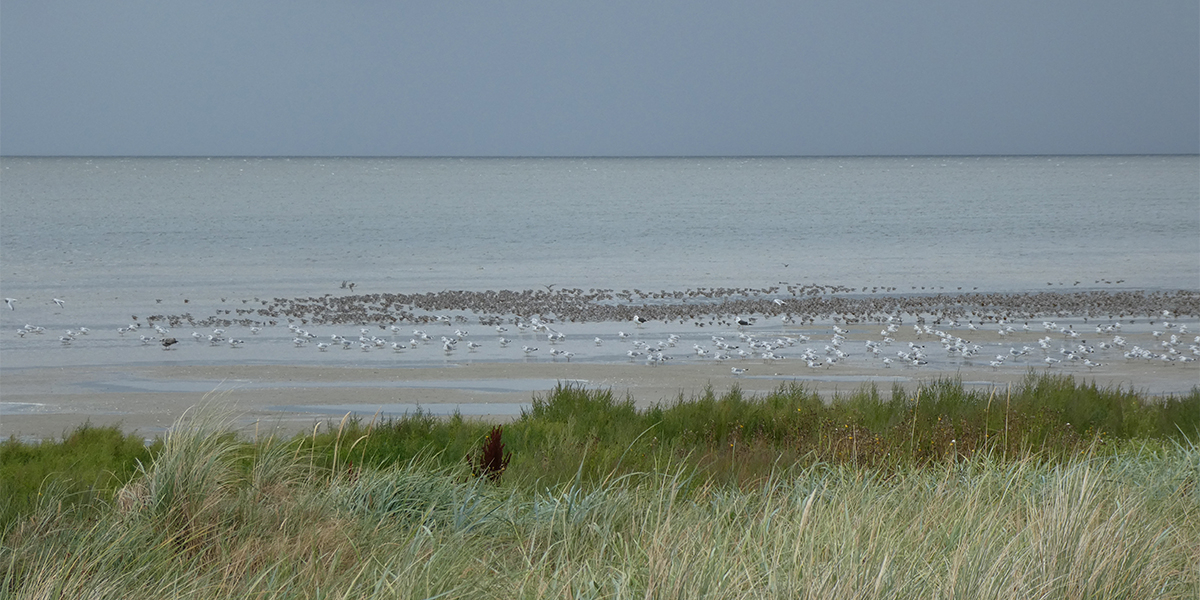
Christine and Allert used the rubber boat to test the accuracy of WATLAS localizations at some of the further points on the mudflat. Unfortunately, strong winds made it a very rough ride and Christine was feeling very seasick. After the most western points were completed, we decided to finish the Eastern side on foot later in the week. Allert headed back to the Navicula and the researchers attempted to get some rest before the (hopefully) long night of catching!
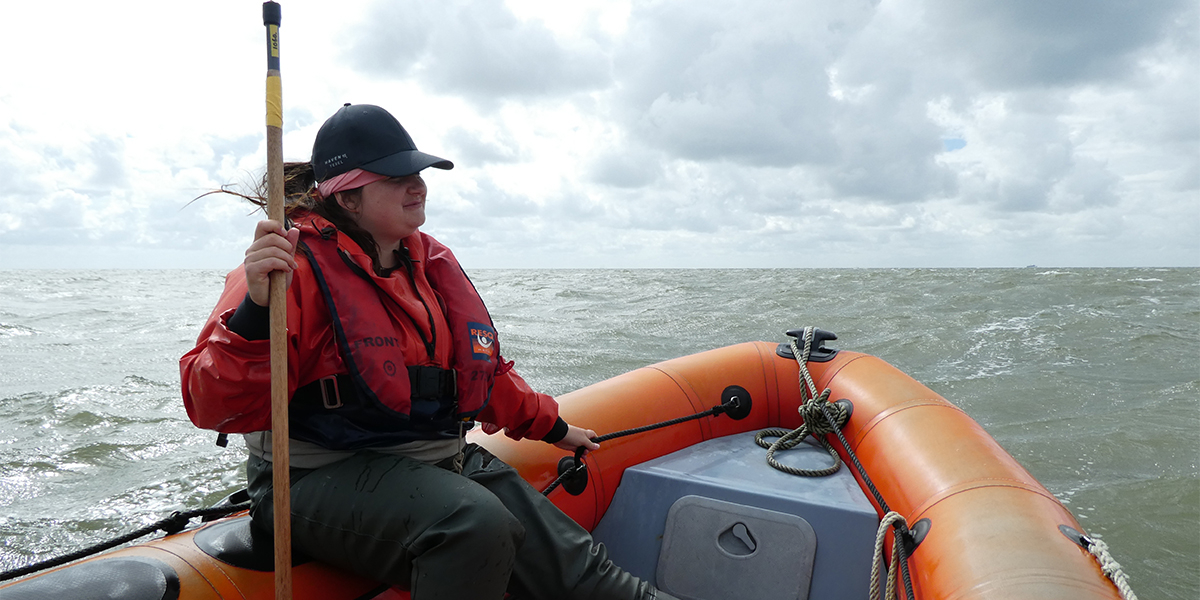
In the evening, the weather was still looking good and at 11pm the team headed out to open the nets. Considering the weather earlier in the day, the night was still with very little wind and thankfully no rain or thunder! We checked the nets after the first 45 minutes of waiting and found some oystercatchers, a bar tailed godwit and a sanderling, which we all immediately released. In the second round of checking the nets, we finally caught some knots! By the end of the night we had caught 14 red knots, which was fewer than what we had hoped for, but better than nothing. We closed the nets and headed back to the house. After ensuring the birds were settled in their holding crates, we went to bed around 4 am.
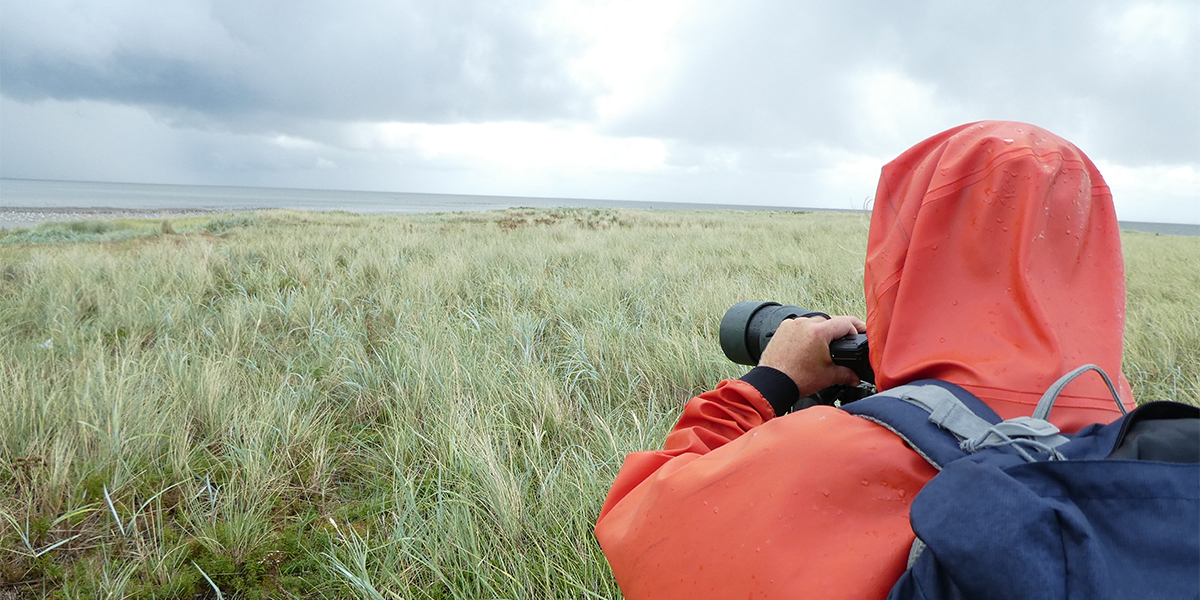
Sunday 23rd
Today was an early start for many. The SOVON high-tide roost count was planned this morning on both Richel and Griend. Job and Allert did the count on Griend. The weather was not pleasant and heavy showers and wind made the work challenging. Because of the very high tide, many shorebirds birds had left Griend and roosted on Richel. Still Job and Allert counted 36,000 individual birds. The five most abundant species were 9500 Oystercatchers, 5000 Sanderling, 5000 black headed gulls, and 4500 shell duck, and 3300 eider ducks. While this count was being done, Evy made her way to the Griend field station to discuss plans for her Master’s project with Christine and Selin. Evy will be using WATLAS data to monitor when birds leave the Wadden sea, and more specifically which birds decide to fly in the direction of England and when they decide to do this.
While most others were on Griend, Anne and Hein sailed to Richel again to fix one of the solar panels on a receiver station. With the high wind speeds, one of the solar panels had blown upside down and was no longer able to produce any power.
The weather was looking good for the nights catch, but unfortunately during the early evening the forecast changed. After consulting all available weather forecasts, we decided that the risk of lightning would make it too dangerous and, once again, catching was cancelled. The Navicula had to pick up Evy in the dark since she had been waiting in the hut to go out catching. Klaas could see them on the radar walking across the mudflat and Job and Allert then went out in the rubber boat to bring Evy safely back to the Navicula.
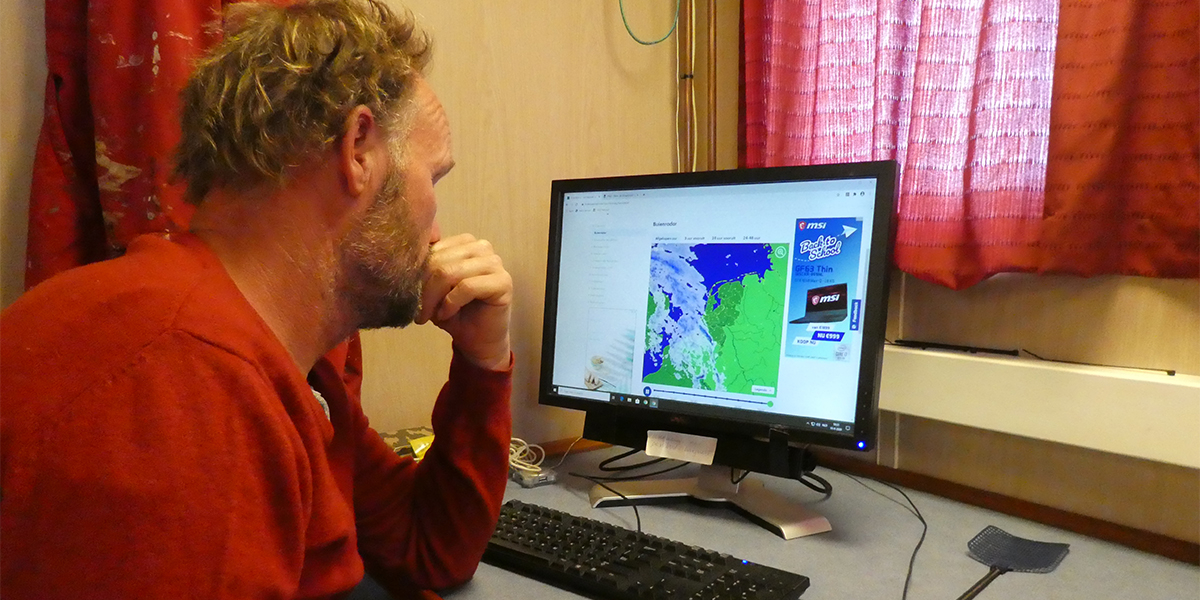
Saturday 22nd
Saturday was a rare quiet day on both Griend and on the Navicula. With no birds to test, many of the researchers did computer work. On the Navicula, a visitor that is involved in building the new NIOZ flat-bottomed ship (to replace the Navicula) came onboard to talk with Bram about the requirements of the ship. Bram gave him a tour before both of them left the Navicula. Klaas arrived to replace Bram as skipper for the rest of the trip.
On Griend, Selin, Robbi and Christine went ring reading before going to check that the nets were safely still closed after the storm. Shortly after returning to the hut, a new ship arrived at Griend. The Ambulant is carrying researchers - from the University of Groningen and NIOZ - who finished a four-year experiment and were extracting their equipment from the island. Two of the researchers needed to stay on Griend (again, because of Corona) so they pitched their tents in a sheltered location near the hut. Emma Penning, a NIOZ PhD student working on sanderlings was one of these researchers so it was great to see her. She will be staying for one week.
Again, the weather stopped us from catching birds. Anne, Job and Allert often inspect the weather, and Sunday & Monday night look very promising for catching. Fingers Crossed!
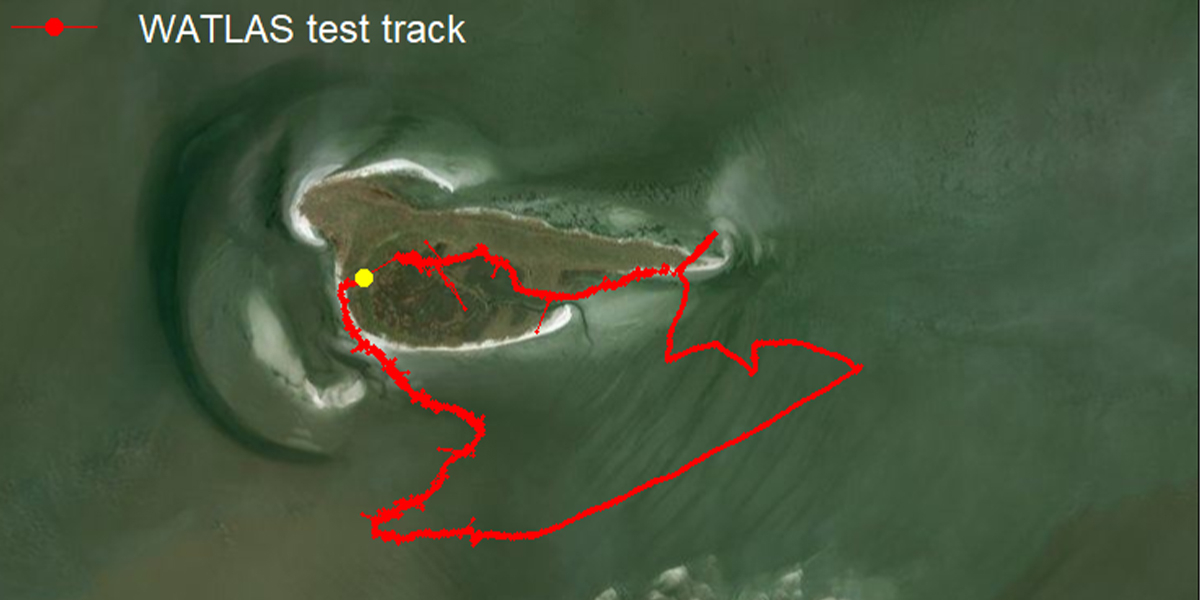
Friday 21st
In the low tide, Robbi and Christine went out on the mudflat together to start a validation experiment for the WATLAS system. We want to know how accurate the system can be across the Griend mudflat, which we can assess by taking a WATLAS tag and a GPS unit to specific locations and compare their location estimates. On our way to each point, we can also compare the similarity of a WATLAS track to a GPS track
At the same time, the Navicula team went to Richel. In very strong winds, Allert and Anne replaced a beacon. Beacons are tags at known locations, which help the WATLAS system to estimate tag locations. While Allert and Anne were busy with the beacon, Job, Bram and Evy explored the Richel mudflat. They saw many different species of bird, including red knots. Many of these knots will also forage around Griend. We often see that if the tide is particularly high (limiting the available space for roosting) or if the birds are disturbed, then they will fly to Richel.
In the evening, unfortunately another storm hit Griend, which stopped us from being able to catch so the Navicula sailed to Harlingen for shelter. There, we could also change skipper so that Bram could take a well-earned break!
Wednesday 19 and Thursday 20 August | Second catching attempt
Our second attempt at catching and tagging the red knots began this week. Again, corona has changed how we would normally coordinate the trip. On Griend, the small island in the Waddensea, Natuurmonumenten has a small house where all our researchers would normally stay. With corona regulations in place, we have decided to station four of the researchers on RV Navicula and three on Griend throughout the week-long catching period. To get to Griend, Robbi and Christine travelled on the smaller, faster boat: the RV Stern. While the RV Navicula sailed to Griend with the others at full capacity.
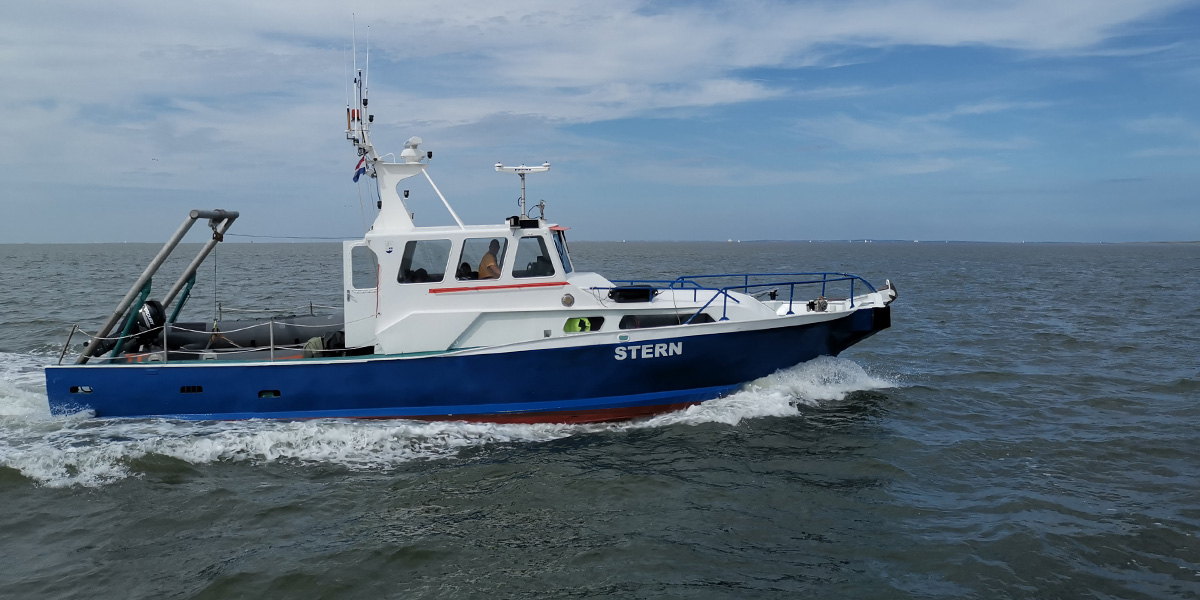
When we arrived at Griend, we unloaded the equipment and personal luggage onto a rubber boat to take to shore. Unfortunately, it was almost low-tide therefore there was a 2km walk to the island. For transporting heavy goods over the mudflats to and from the island we use the ‘Wadkar’, a handy aluminium framed kart with wheels specifically designed to ‘glide’ over the mudflats. On arrival at the house on Griend, we set up our living quarters and discussed the next steps. The weather forecast predicted rain that night which would mean it would be dangerous to handle birds in those conditions therefore we decided not to put the nets up until the next day.
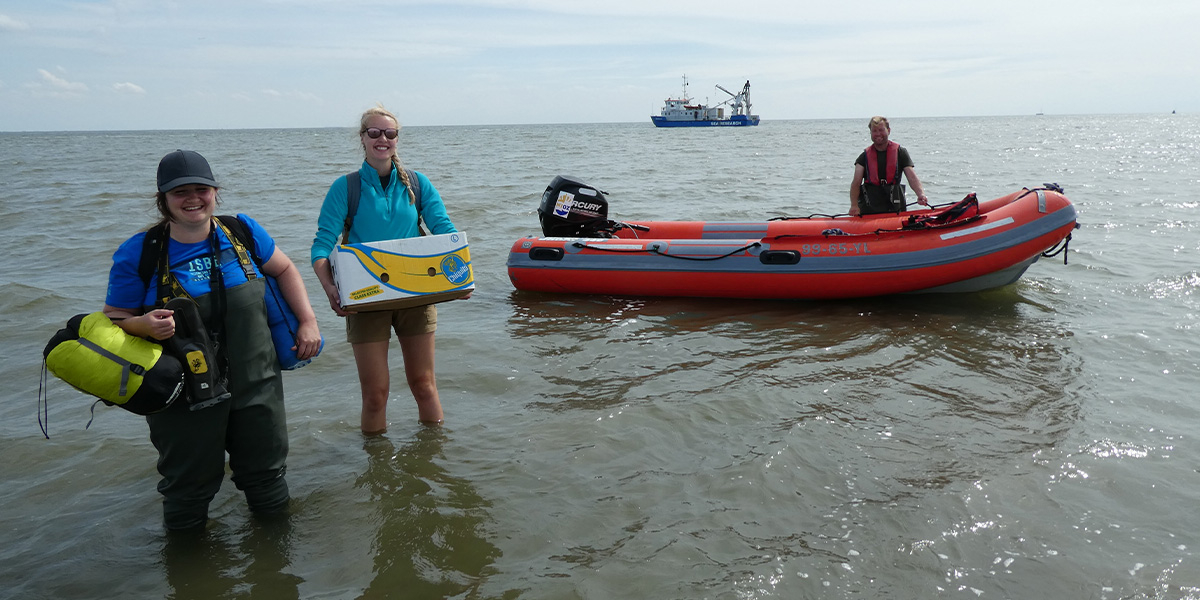
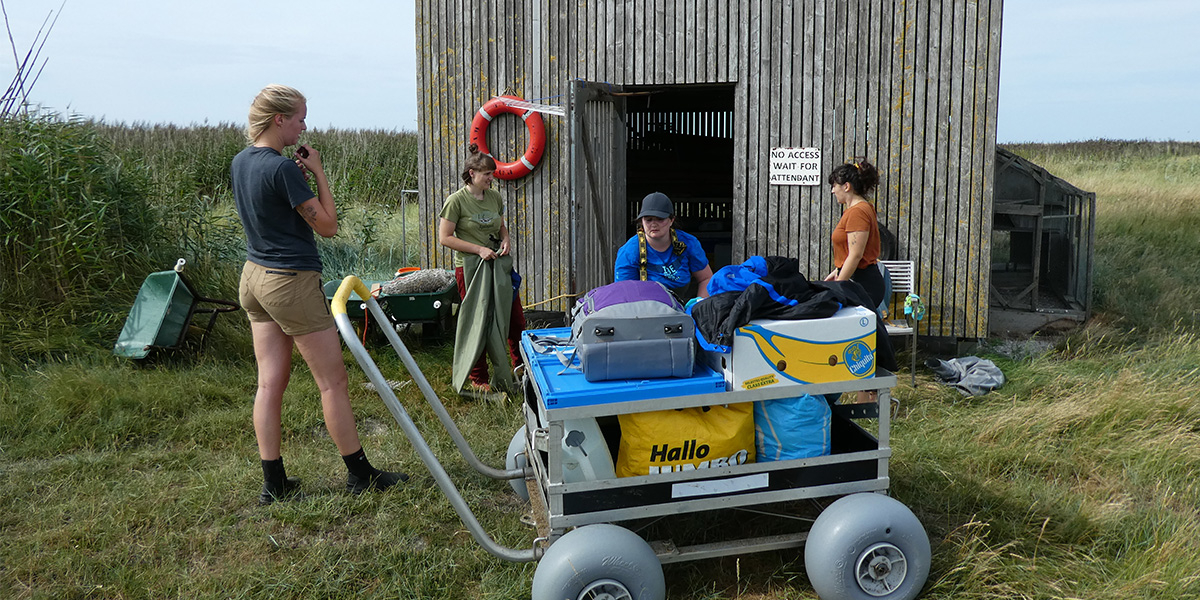
At high-tide, in the morning, Allert and Evy, a Masters’ intern, arrived on Griend with the rest of the equipment and food for the team that are staying on Griend. We (Allert, Selin, Christine, Robbie and Evy) then went out onto the mudflats with scopes to try to find some red knots. There was flock of about thousand red knots foraging on small cockles southeast of Griend. In this flock, we found a couple of knots that we had previously coloured ringed. Because of the unique combination of colours and positions of the rings, we can identify each bird individually. More information on this colour-ringing program can be found here (https://www.nioz.nl/en/expertise/wadden-delta-research-centre/data-tools/monitoring/shorebirds-colour-ringing/research-on-red-knots). Back at the Navicula, Job entered the combinations into the database and had a wonderful discovery. Red Knot (Y4NYPR) was caught by us in 2018 on Griend and released with a WATLAS tag! Selin had also measured its personality and established it was a non-exploratory bird. Indeed, we saw this bird a couple of hundred meters from where we caught it two years ago.
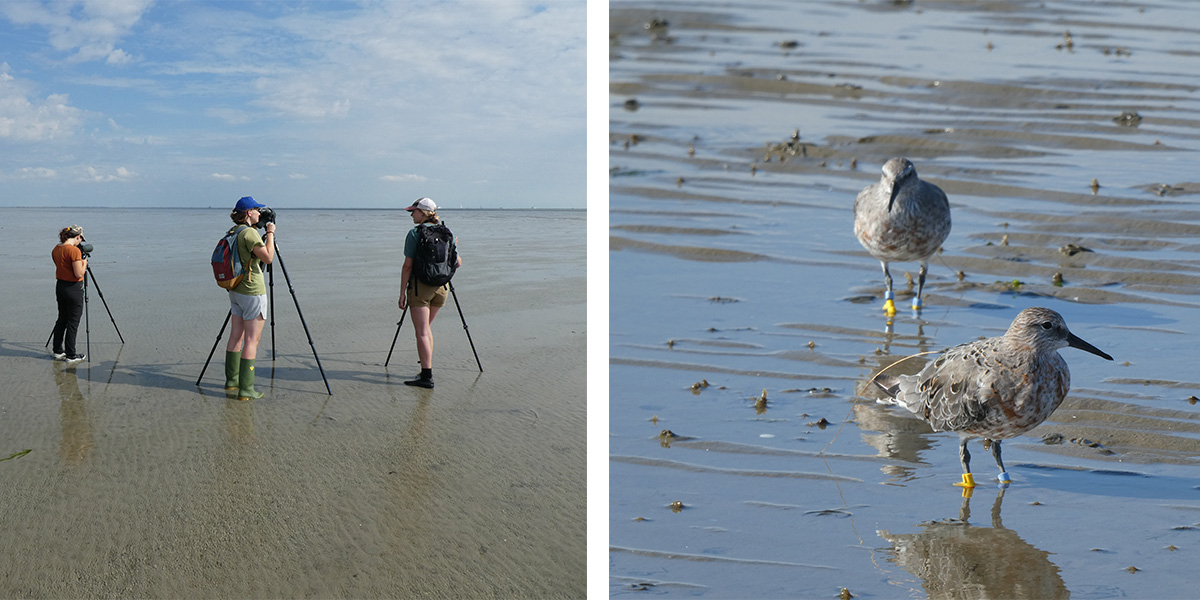
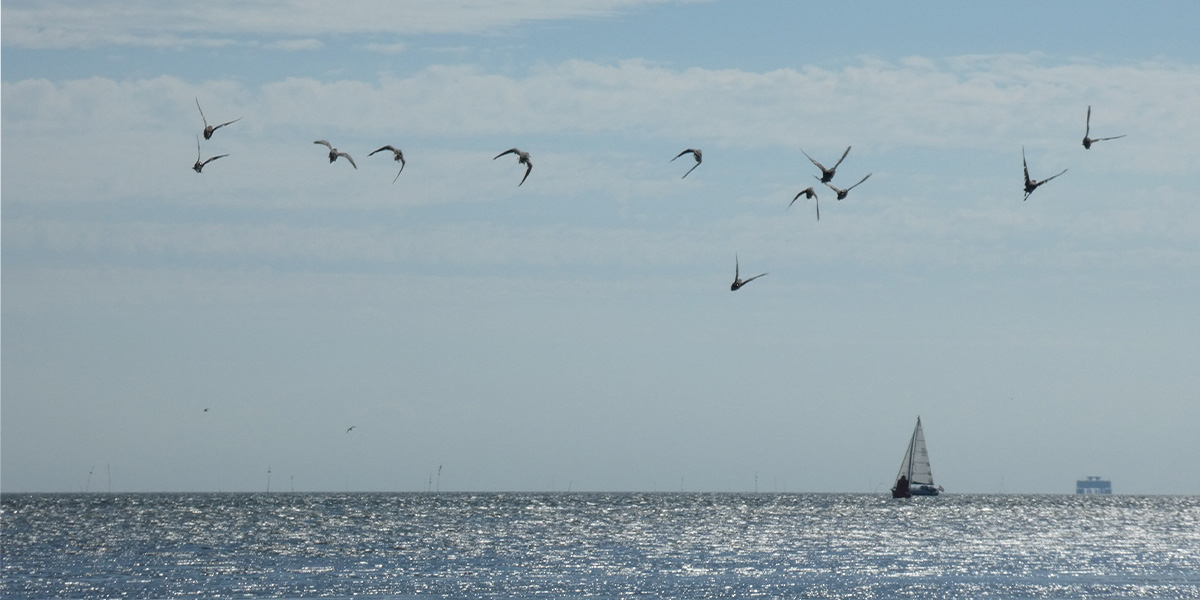
After the ring reading, we split up into two groups. Allert and Christine went to meet Job and Anne at the shoreline to collect nineteen birds that were to be released. These birds had been housed at NIOZ for almost a year where we experimentally investigated how they use each other to find food. After their release, some of the birds stayed really close waiting for their friends to be released before flying off together. We can now monitor these birds throughout the western Wadden Sea at www.nioz.nl\watlas. While Allert and Christine were releasing birds, Selin, Robbi and Evy met with Anne and Job at the North side of the island to set up the mist nets for catching birds that evening. The net consists of several 4m-long poles between which a net can be extended. However, the net should only be opened when it is being actively managed and checked so the nets are ‘closed’ until nightfall
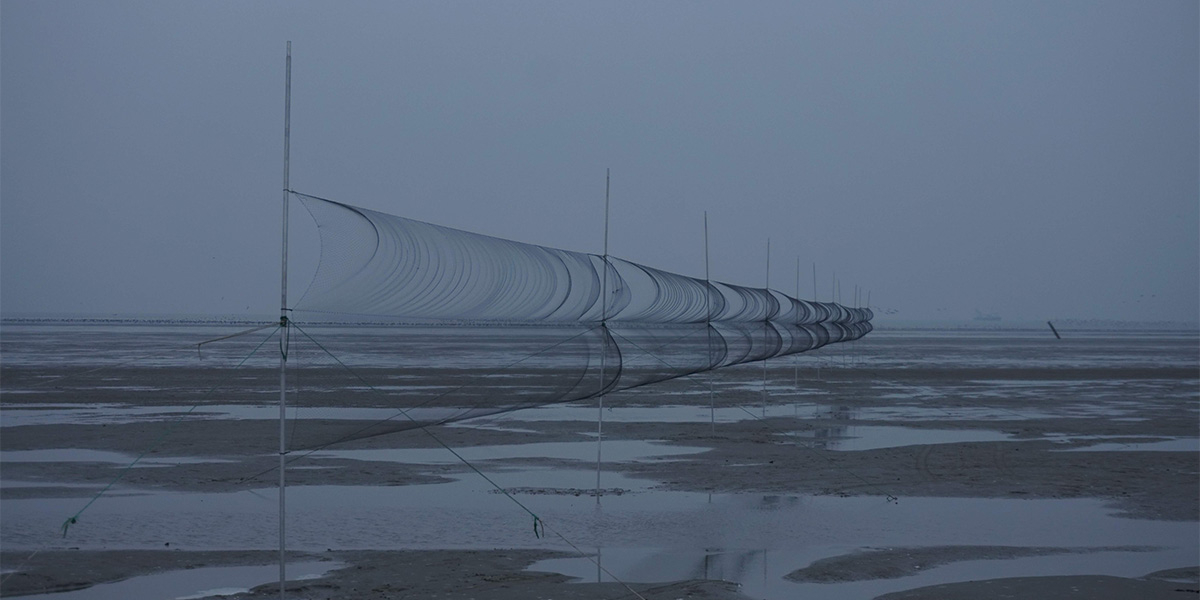
Unfortunately, the evening did not go as planned. After dinner and a few hours of waiting for sunset, the two teams arrived back at the location of the net. In almost pitch black, Allert, Job and Anne went to open the nets but it wasn’t long before the rest of the team saw lightning in the distance and shortly after heard the slightly concerned voice of Bram, the Navicula skipper, over the radio. After confirming a storm was indeed heading our way, and would arrive at precisely the time we would be catching the birds, we swiftly closed the nets. We all rushed back to the house to shelter as it was too late for an evacuation by the Navicula. After a spectacular display of lightning, the rain and wind arrived, and we waited the storm out until around 2 am before half of the team could go back to the Navicula to get some sleep.
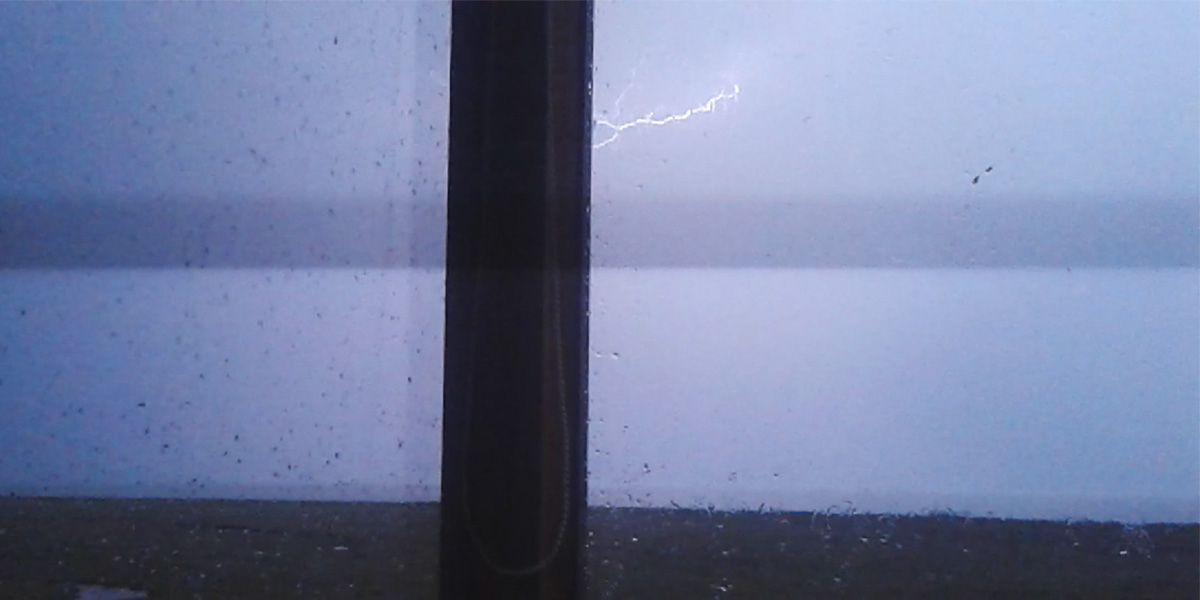
Monday 27 July | You can't always get what you want to
Due to the tide times, Sunday night would be our last chance for catching. The weather that night left us waiting until the very last moment to decide that we would not do a catching attempt. There was a strong wind, which complicates catching by causing the nets to make whistling sounds, and causing birds to fly faster and potentially getting injured when flying into the nets.
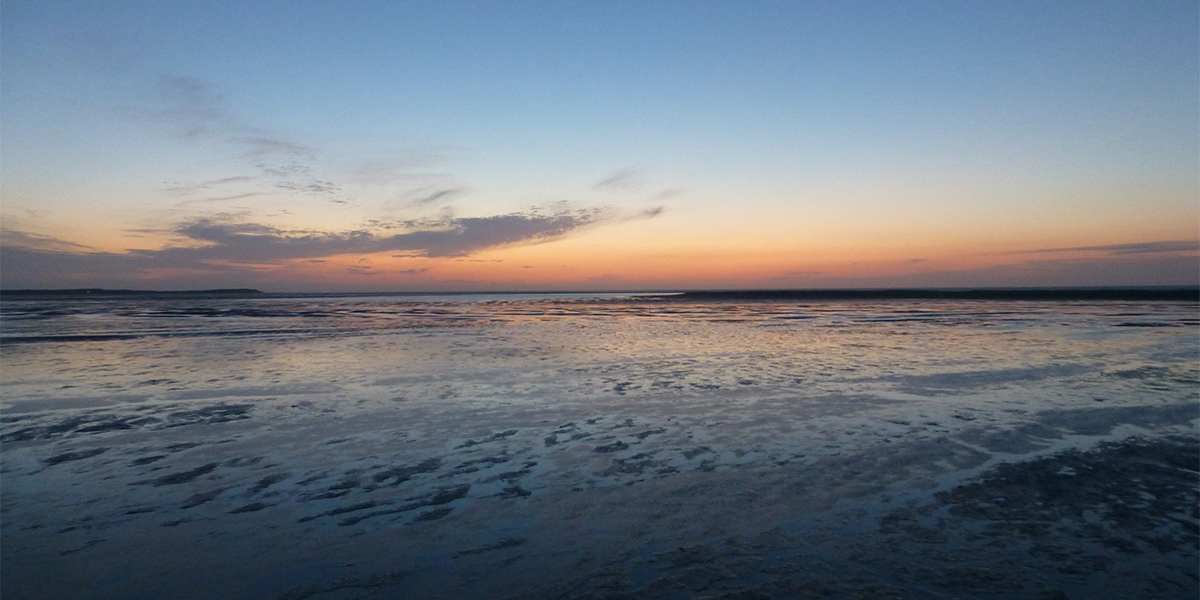
This meant that our field trip yielded only four birds, but of course you never know this beforehand. If the changes are big enough that birds will be caught, attempting a catching trip is worthwhile! It also meant that all four of us would be leaving Richel with the boat that would come to pick us up on Monday morning; if we would miss that boat, we’d have to stay until Friday for the next boat… So we packed most of our stuff around midnight, and the next morning got up at 6:00 to finish packing, cleaning and, most importantly, disassembling the mist nets. Luckily, this all went fine and, as agreed, Klaas-Jan came to pick us up with the repaired Stern. We were back at NIOZ around 15:00; time to rest but almost time to start preparing the next catching trip too, which will be halfway August!
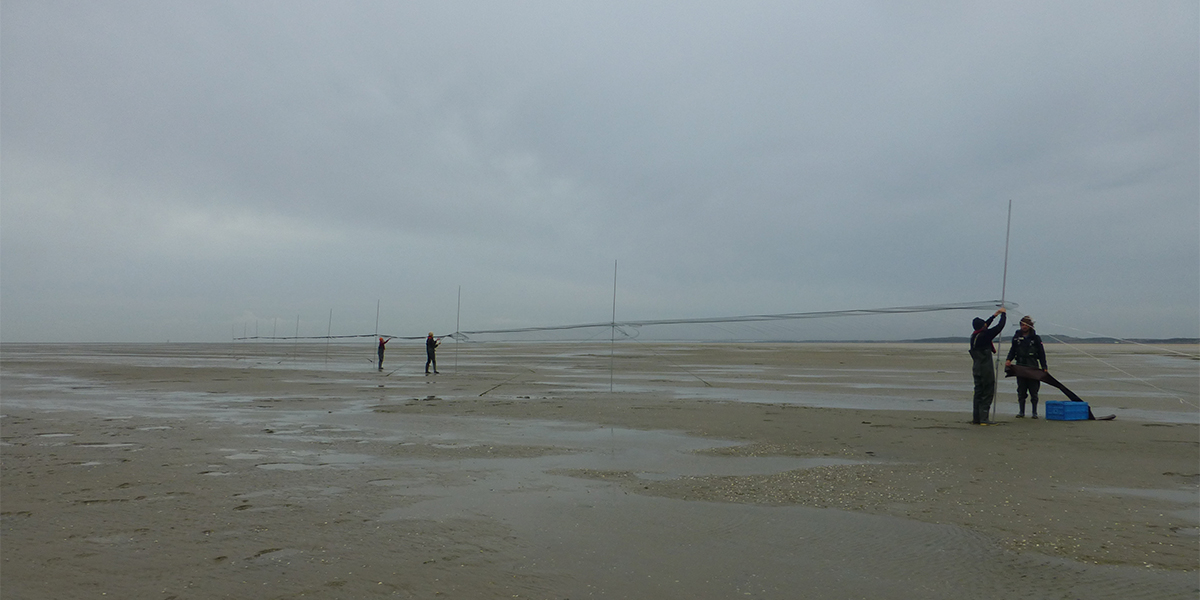
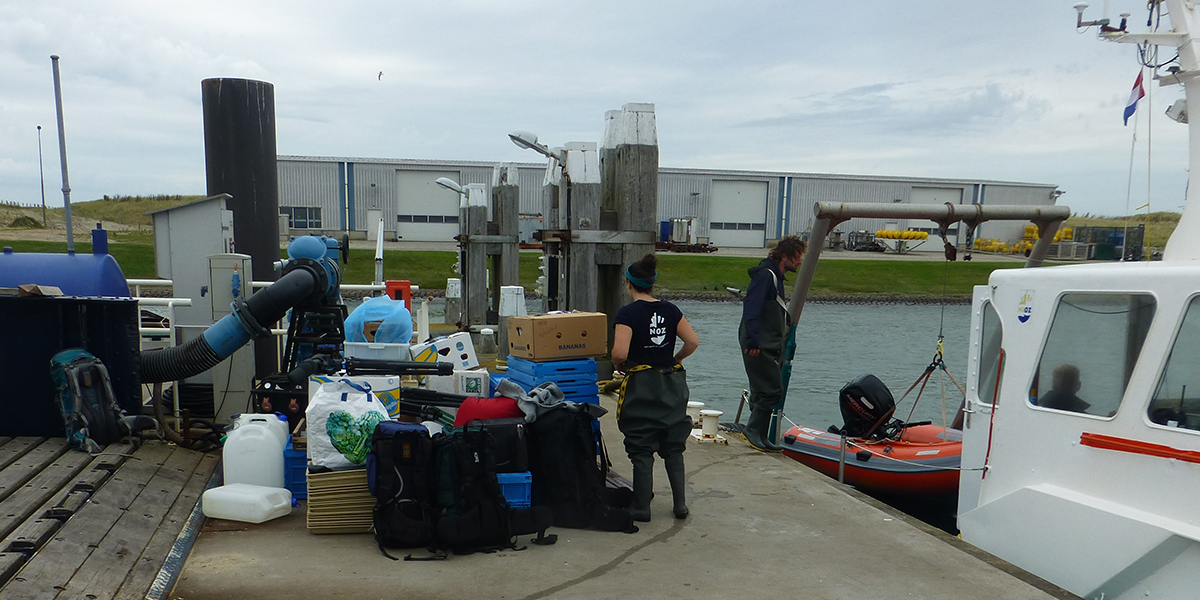
Sunday 26 July | Measuring the bird movements
By Hans Linssen
On the next morning, we set up the tent unit on the Wadtoren to test the exploration behaviour of the knots we caught. In this unit, which closely resembles the exploration experiments at the NIOZ, a red knot is let into a pyramid shaped mobile room that has four trays of sand standing in a shallow layer of sea-water, resembling foraging patches emerging just above the water level. The exploration measurements last 20 minutes per bird that we film with a camera attached to the ceiling of the unit. From the video footage, we measure the movements of the bird on and between the sand patches; we ask whether the focal bird stands still in one of the trays, or does it go around, does it probe in all trays, what is it’s speed? This is the measure of exploration, as a personality trait. Before being released again, the knots are equipped with WATLAS tags, enabling us to follow them out there in the Wadden Sea and link their personality with foraging movements in the field.
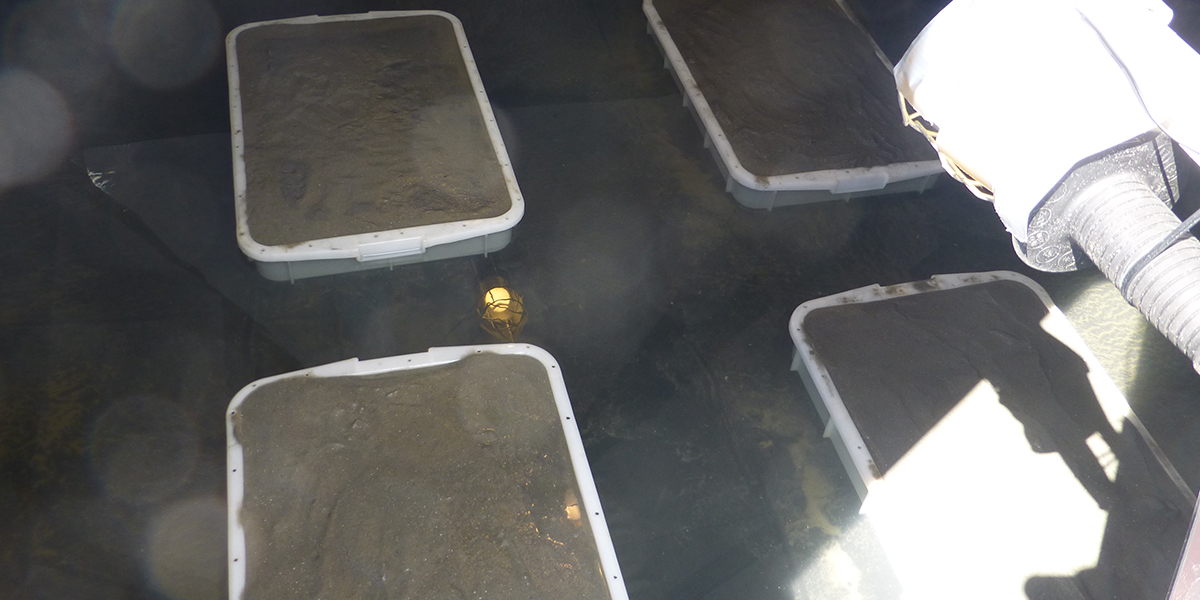
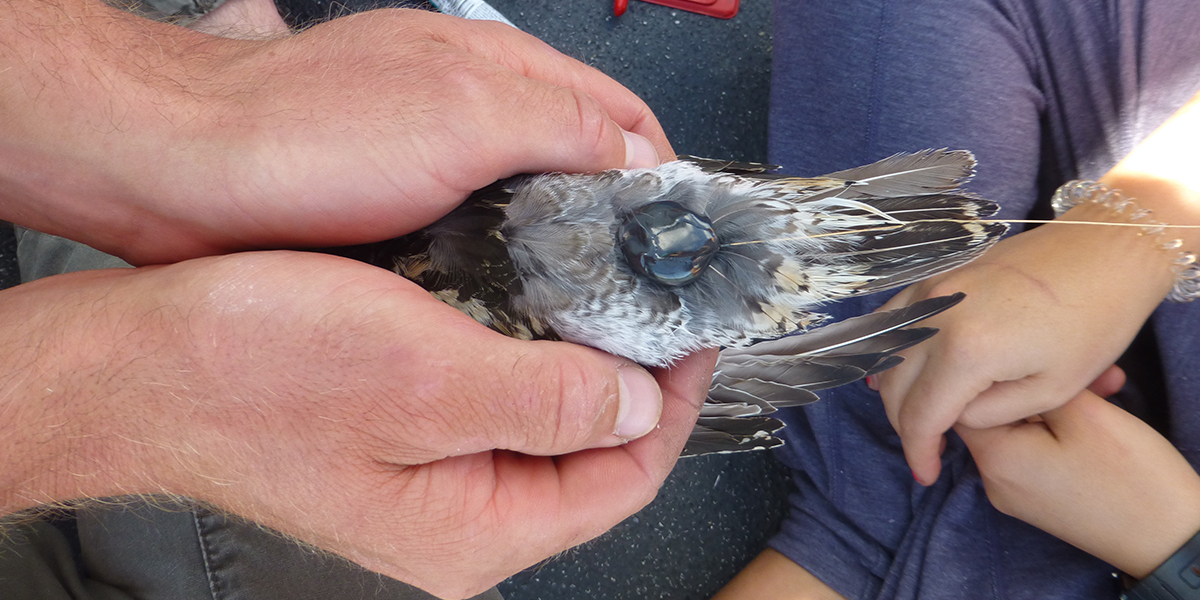
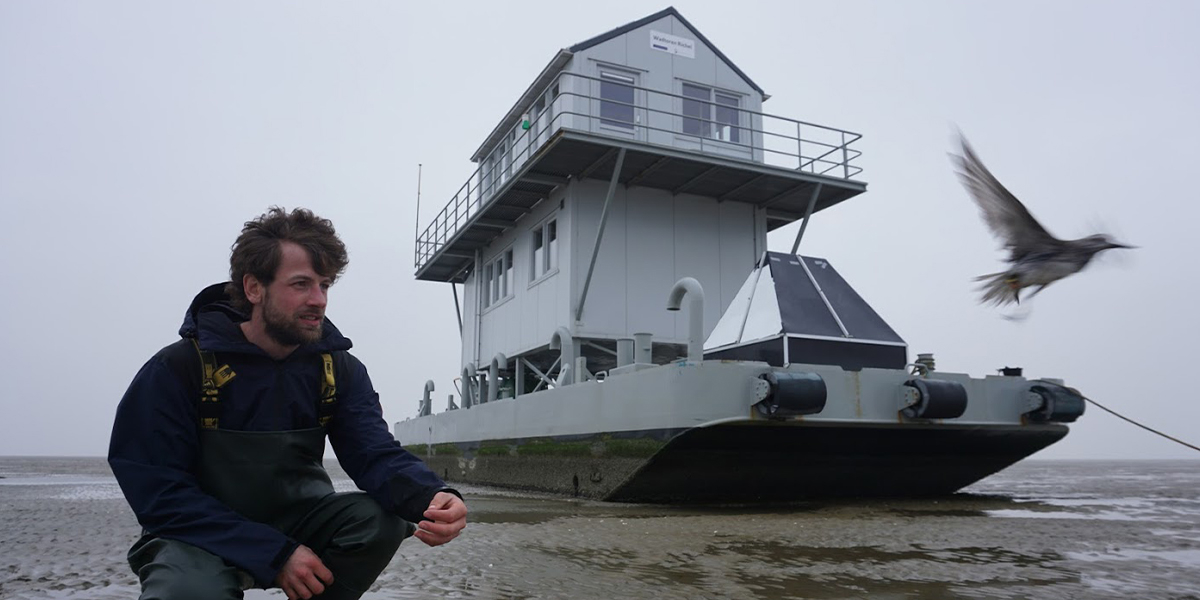
Friday 24 July | First catching expedition of this season
The field work for constructing the receiver stations has been completed, and we have moved to the next phase. This weekend, Selin Ersoy (PhD), Luc de Monte (catching expert), Anne Dekinga (catching expert), Hans Linssen (guest researcher) and Nino Maag (guest researcher) were at Richel to catch birds. Hans Linssen, Selin Ersoy, and Nino Maag have written a blog of their first day.
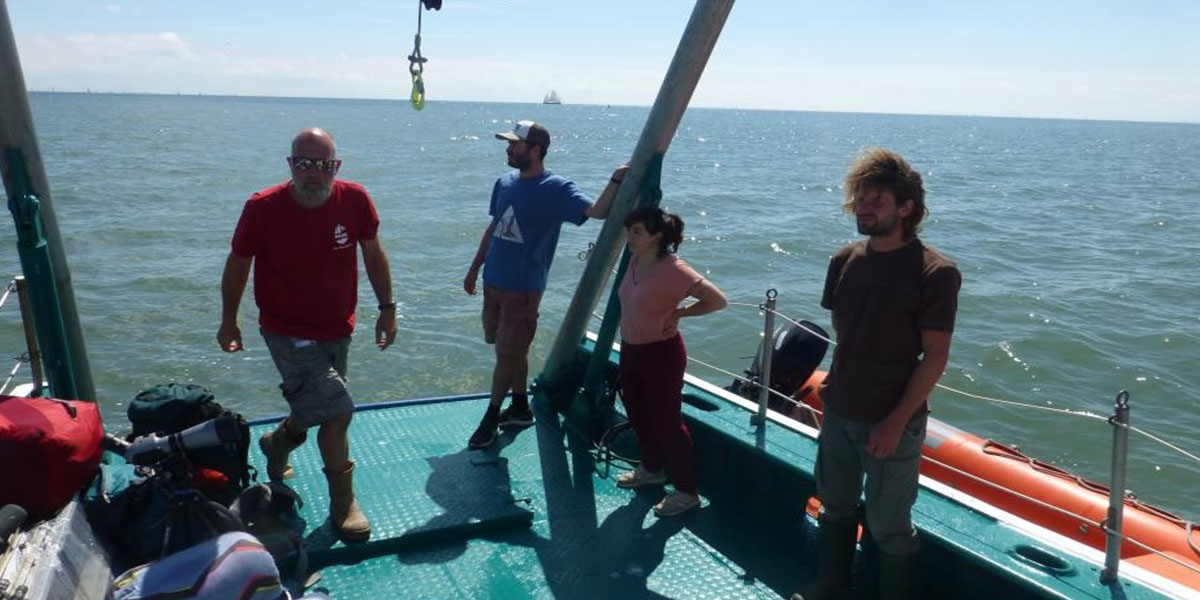
At 10:00 on Friday, we had the Stern all packed and we were off towards Richel with Stern captain Wim Jan! The goal of this trip was twofold: catching and ringing red knots, and also equipping a number of knots with WATLAS radio transmitters and testing their exploration behaviour in a provisional experimental set up. With the sun shining in a bright blue sky, spirits were high but none of us were prepared for what was about to happen. A couple kilometres from Richel, one of the Stern’s engines suddenly broke down and we were left floating on the open water for a while. Luckily, team Canutus came to the rescue and picked us up with their ship (which is also their home), to drop us off at Richel’s wadtoren around 14:00. At the same time, Wim Jan sailed the Stern back to Texel using only the one remaining engine. After setting up camp at the wadtoren, the mist nets were put up and between 01:00 and 02:30 in the night, we did two rounds of catches which yielded four knots and 14 sanderlings. Not the numbers we hoped for, but still valuable! During our rounds, we were accompanied by huge amounts of sea sparkle (Noctiluca scintillans, dinoflagellates that exhibit bioluminescence when disturbed), providing our night with a glowing edge.
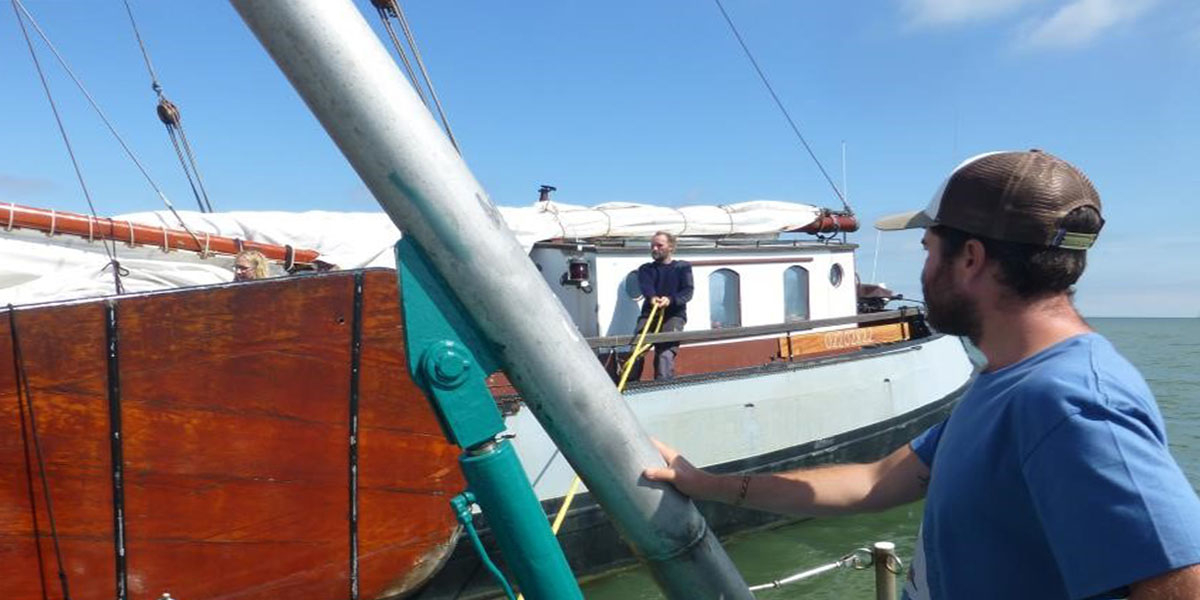
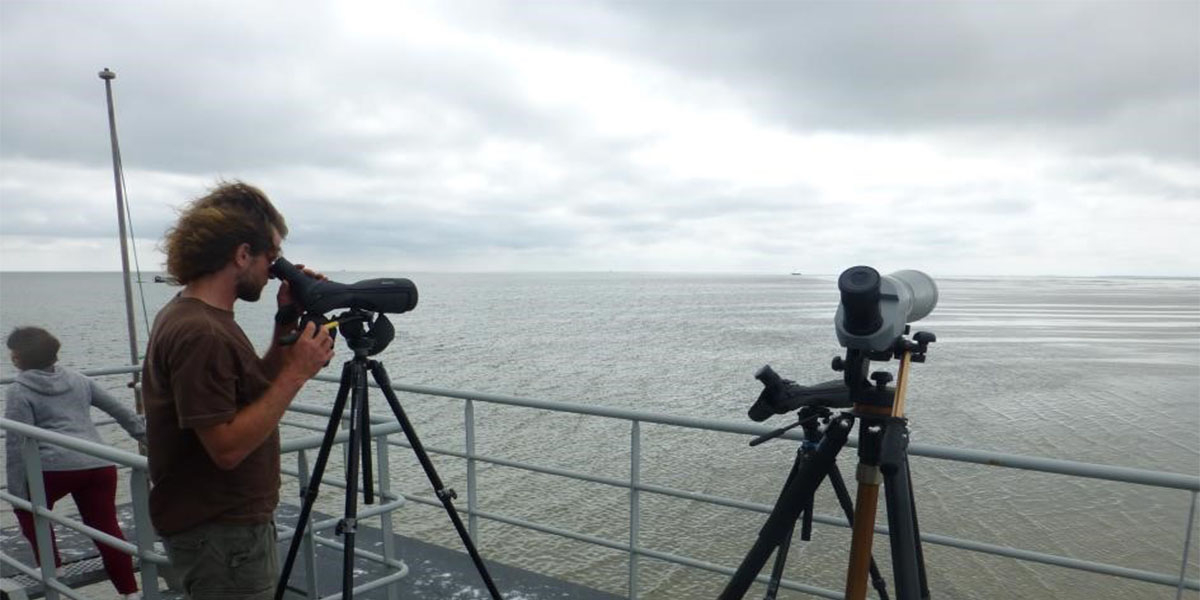
Tuesday 21 July I Day 9
By Allert Bijleveld and Christine Beardsworth
After breakfast, we set sail towards the NIOZ harbour, located in the South of Texel. We sailed past our southernmost temporary receiver and into the deeper waters of the Wadden Sea. Again, it was nice weather which meant smooth sailing for us. With a flat hull and draught of only 1.10 m, the Navicula is designed to navigate the shallow inter tidal zone of the Wadden Sea and bad weather can make for quite a rocky ride. We have been very lucky with the weather for the entire week and it has meant that we have finished our fieldwork three days early.
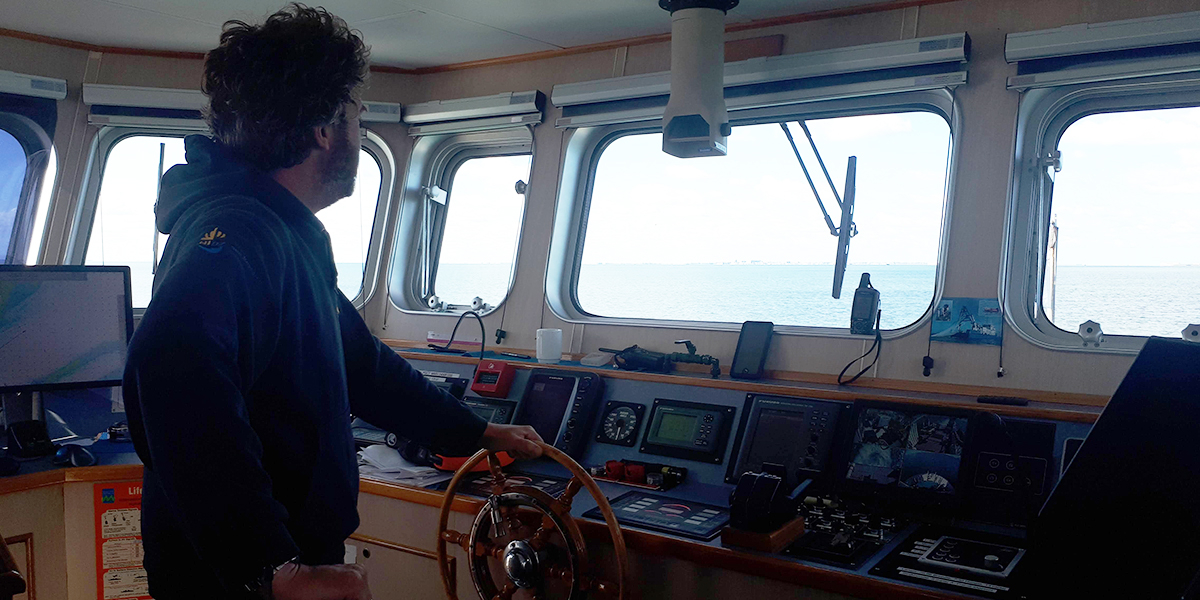
When we arrived at the harbour, we unloaded our equipment from the ship, and into a NIOZ van, which we took to the institute before most of the team went home for the day. Only the crew remained to offload the heavy equipment and service the ship.
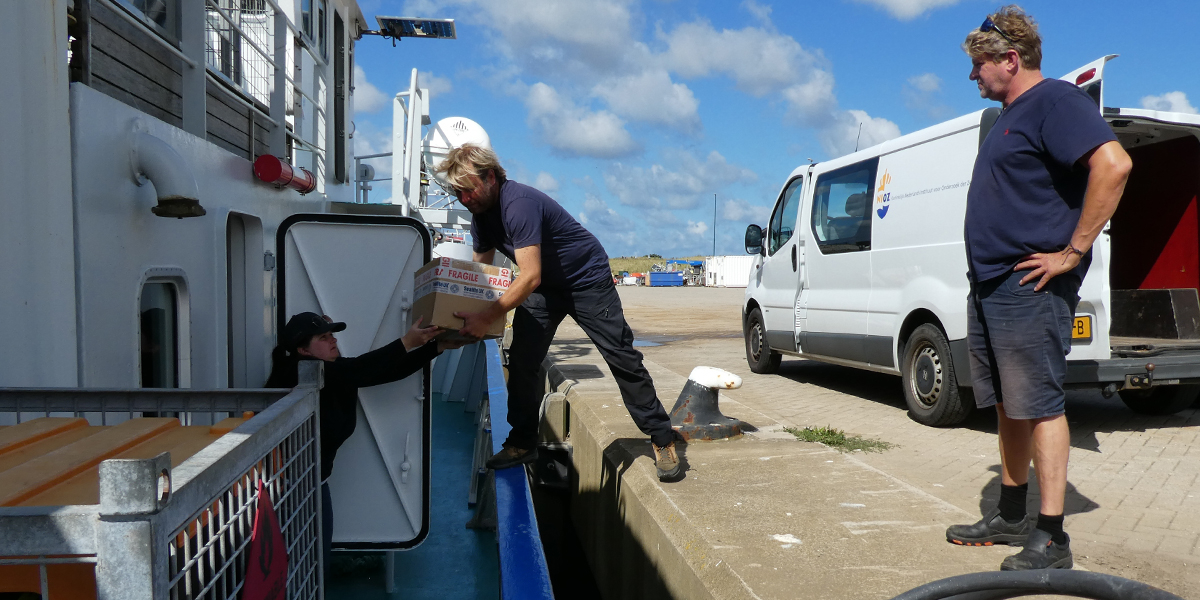
To be continued...
At the end of this week, the WATLAS fieldwork will move onto the next phase for this season, when Selin, Hans, Nino, Luc and Anne will go into the field to catch red knots, measure their biometrics and physiology, assay their exploratory behaviour, and attach a small WATLAS tag to their backs. Combined with the work that we did the past eight days, we will then be able to track these birds and find out where they go in the western Wadden Sea.
Monday 20 July I Day 8
By Allert Bijleveld and Christine Beardsworth
We went out again early this morning to set up our final receiver station. Allert went to pick up a journalist, Anna van Kessel, from the Texel shoreline and brought her to the build site. She will write about the WATLAS project and about our fieldwork this week. We showed her how we build receivers, but unfortunately, we were unable to finish the receiver completely as the WATLAS unit was being fixed by Frank at the NIOZ workshop. After the rest of the build was completed, we all went back to the Navicula for a coffee and showed Anna around the ship.
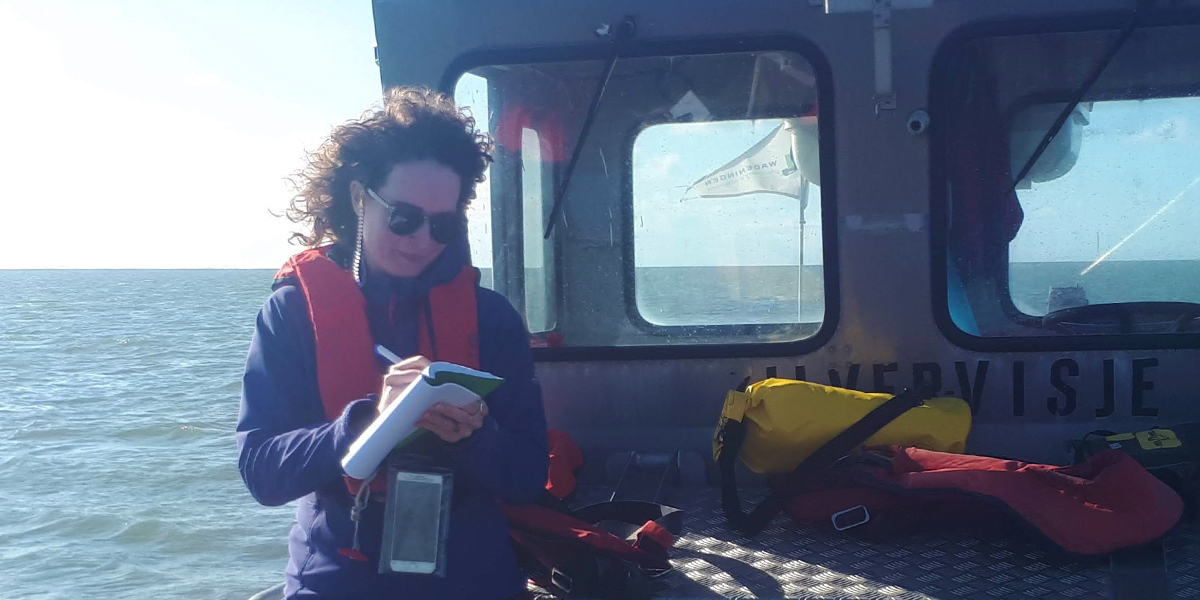
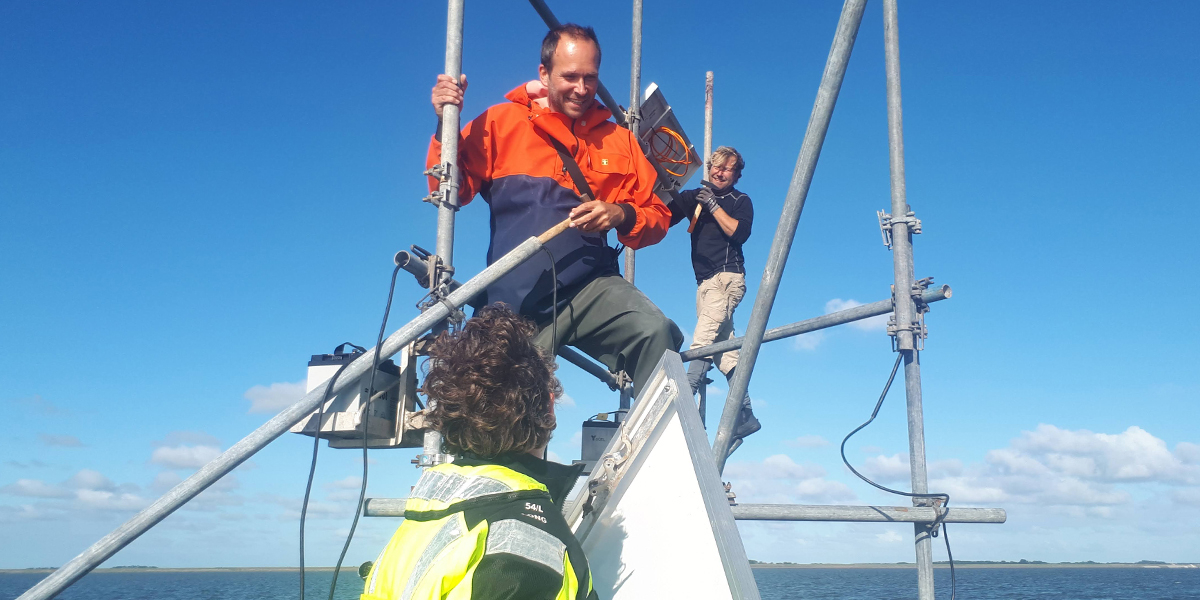
That's efficiency
We got a call from Frank to say that the unit was ready at about 10 am (that’s efficiency!) and Luc, a technician for NIOZ, brought it to the North of Texel where Allert, Anne van Kessel and Christine met him on a beach, filled with sunbathing tourists, to collect the unit. Although we attempted to complete the station, the water was now too shallow to get the rubber boat to the station. Therefore, we sailed back to the Navicula for lunch, after which Allert dropped Anna off on Texel.
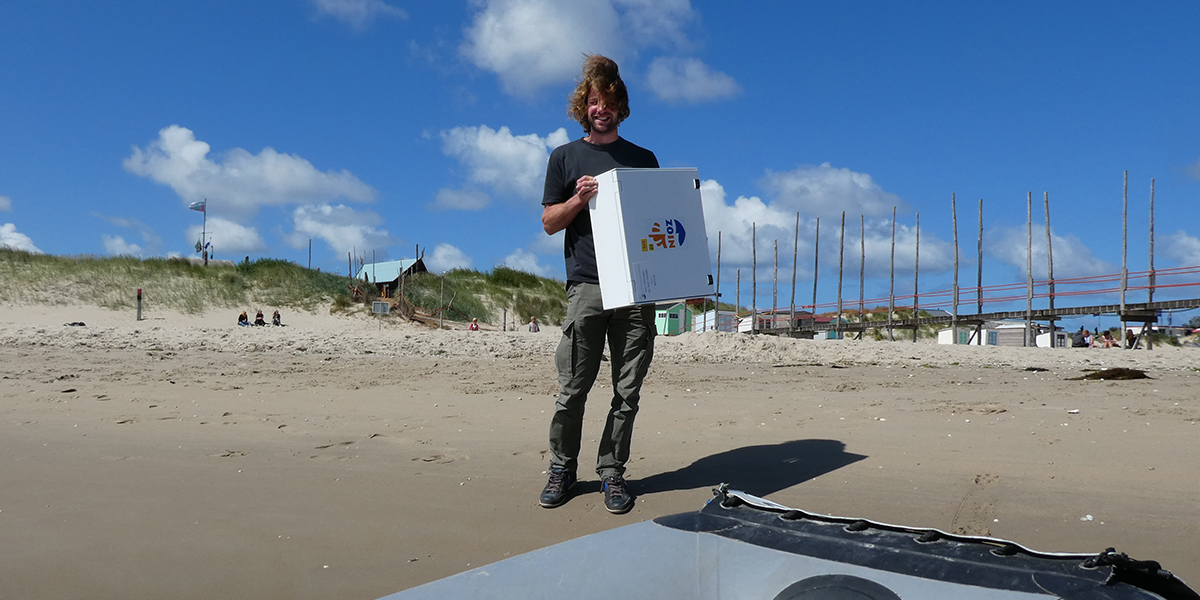
Ship office
At times when we are unable to work in the field, we can do office work on the boat because there is a sporadic internet connection. This week the researchers, Allert and Christine, were able to attend their group coffee meeting over Microsoft Teams, and had a productive chat with the students that study movement ecology with Allert.
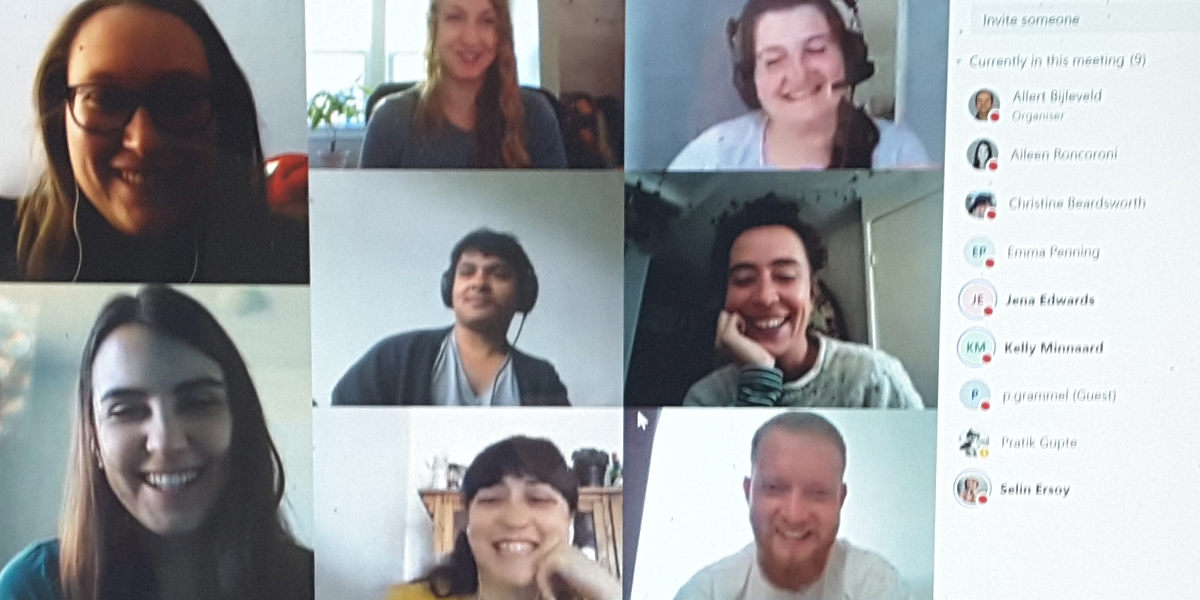
Ready to detect
In the evening, we were able to reach our final receiver station! Christine and Allert set off and had no problems setting up the stations. We checked the app to see that the receiver was working and set off back to the Navicula. We were done! Every receiver is now up and working, ready to detect red knot locations. The only thing left is to tag the birds with the lightweight WATLAS tags, which we will begin next week. For now, we will celebrate a successful week before heading home. Because of the ‘wantij’ (the divide between tidal basins), we must wait for tomorrow’s tide - that is slightly higher - to set sail.
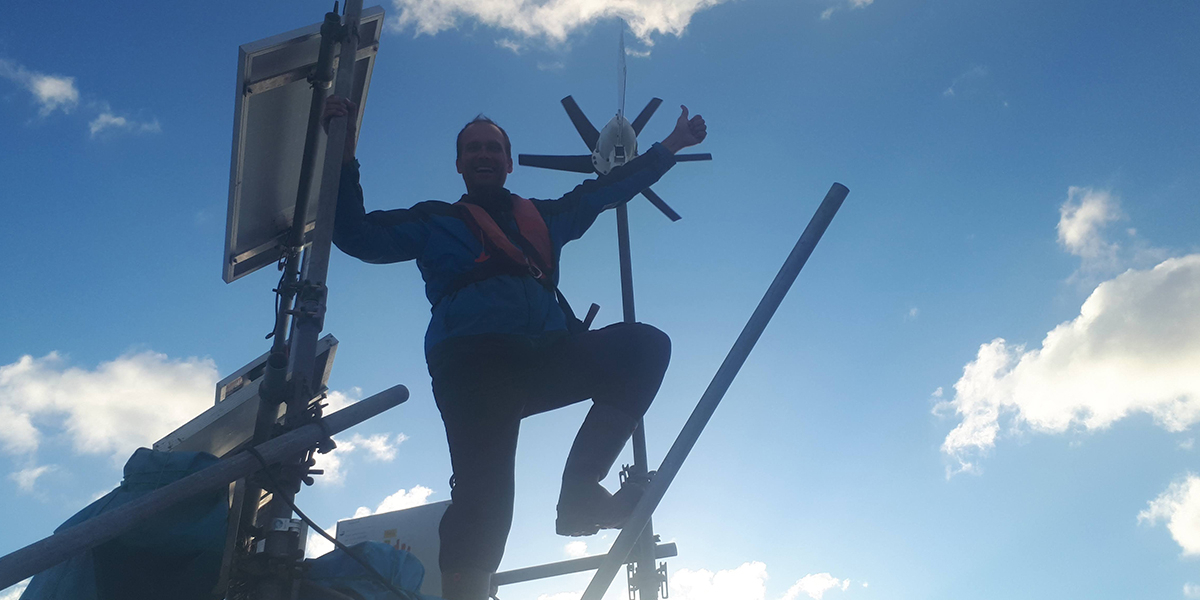
Sunday 19 July I Day 7
By Allert Bijleveld and Christine Beardsworth
Another early start this morning to erect our penultimate receiver station. The whole team went to the location, just off the northern coast of Texel and Team Canutus started fixing the scaffold to the seabed. Nearby, there is a protected area from which interested seals came out to investigate our activities. Both grey seals and harbour seals watched us build the receiver between their foraging bouts in the gully. The receiver was built quickly, and we headed back to the Navicula.
Fingers crossed
Shortly after our return to the Navicula, it was high tide and we set off to sail closer to Texel. Hein was leaving the ship and he had offered to take our broken WATLAS back to Den Burg. From Den Burg, our colleague Luc could bring it to NIOZ the next morning so that Frank could fix it. We hope to get the unit back tomorrow afternoon so that we will be able to successfully deploy our final receiver station. Fingers crossed!
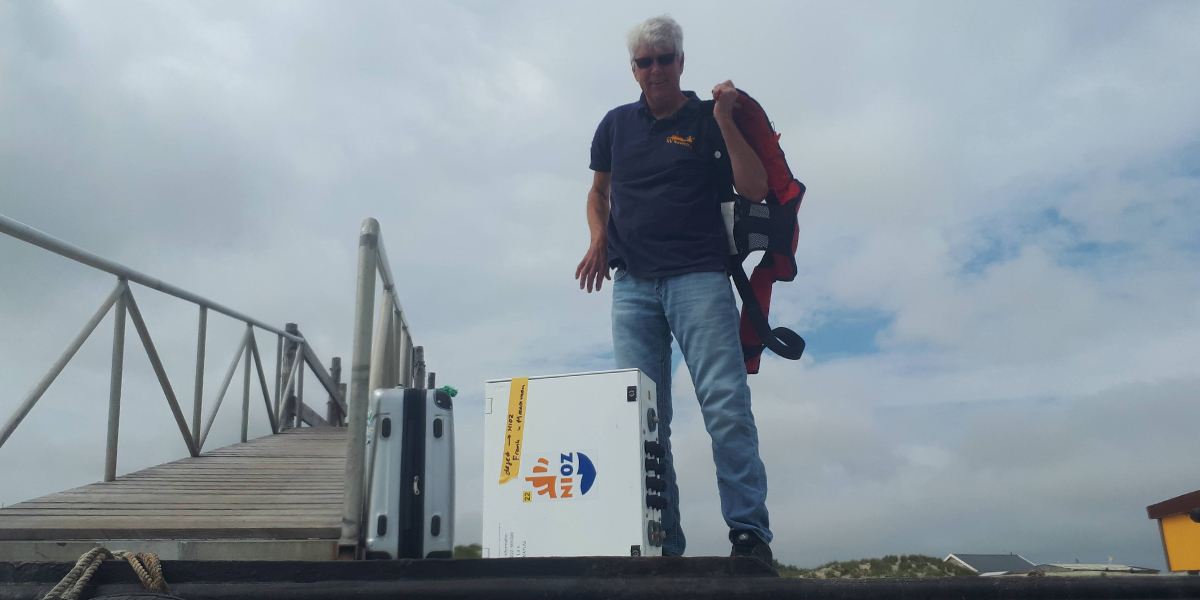
Trial and error
Our final task of the day was to test a new method of building stations so that we can track birds throughout the year. Normally, we deconstruct the temporary receiver stations in November before they are destroyed by winter storms and sea ice. For stations to stay out year-round, we must use more robust mounting method than the scaffolds we currently use. We found a 7 m steel pole with a diameter of 32 cm diameter at the NIOZ shipyard, which should withstand the forces of nature year-round. But first, we needed to test whether the onboard crane could safely lift and manoeuvre this heavy equipment in place on the mudflat. After a bit of trial and error, we concluded that this new method should be possible to use in coming years. Now, we need to think of ways to get funding for buying these heavy-duty poles.
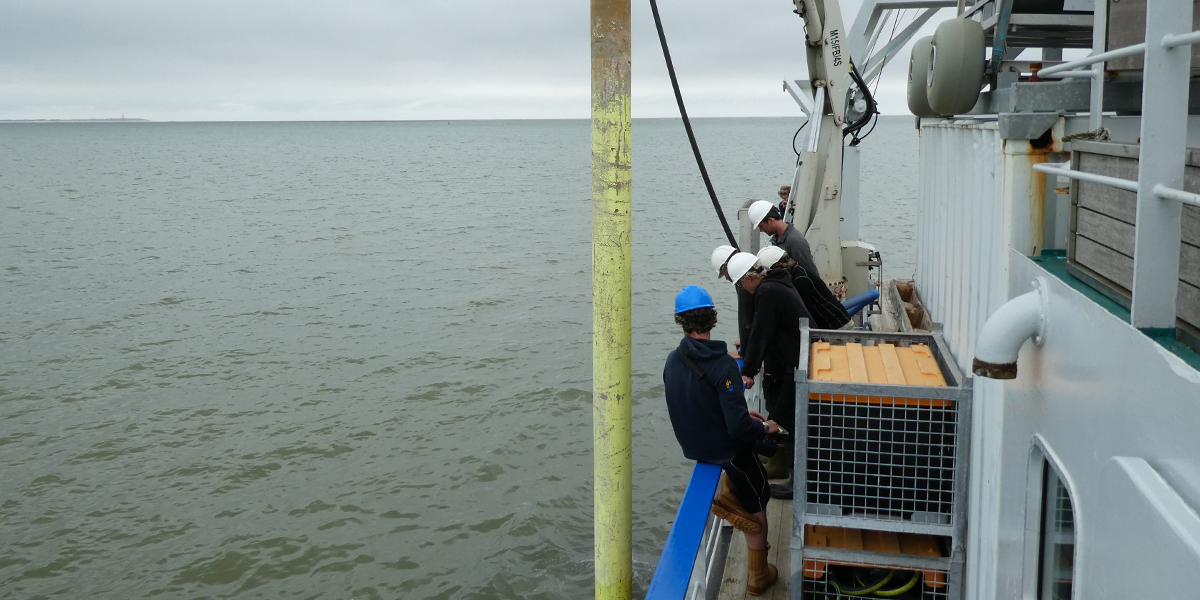
Heading home
With incoming tide, the ship lifted from the seabed and we sailed towards Texel where, tomorrow morning, we meet a journalist who plans to write an article on our work. As the sun was setting, we had some spectacular skies against the backdrop of Texel with its beautiful lighthouse.
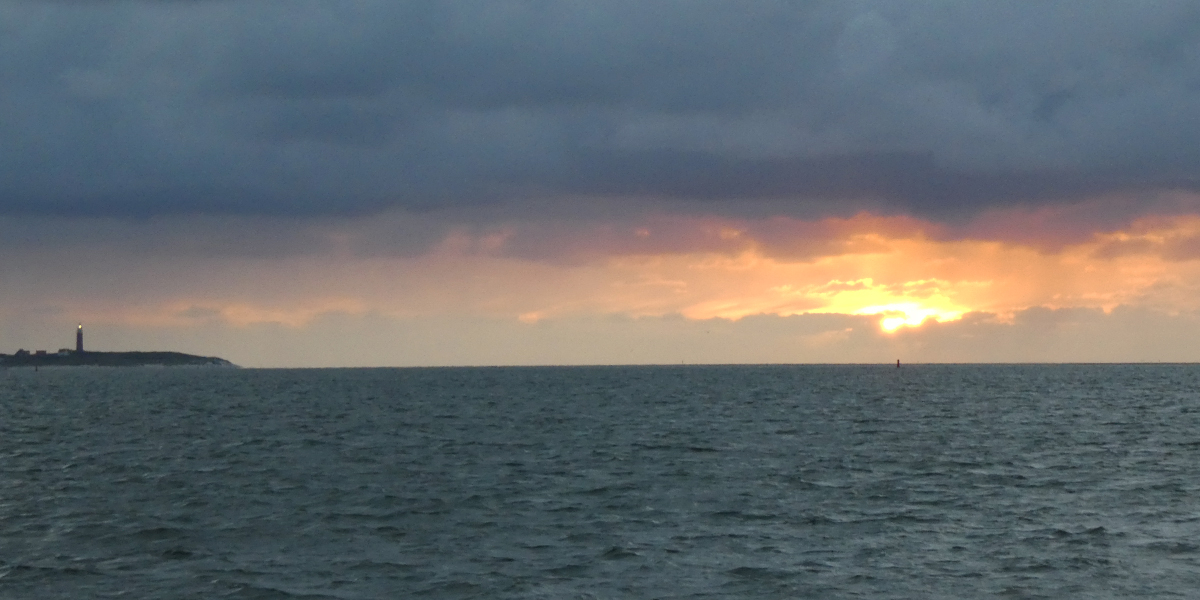
Saturday 18 July I Day 6
By Allert Bijleveld and Christine Beardsworth
We left early this morning in another attempt to fix the receiver south-east of Griend (see blog for 17 July - Day 5). Since it was hightide, they were able to take the boat all the way to the station and Allert replaced one of the components. Unfortunately, this did not fix the receiver, which meant we needed to come back later and swap the broken WATLAS unit for repairs at NIOZ.
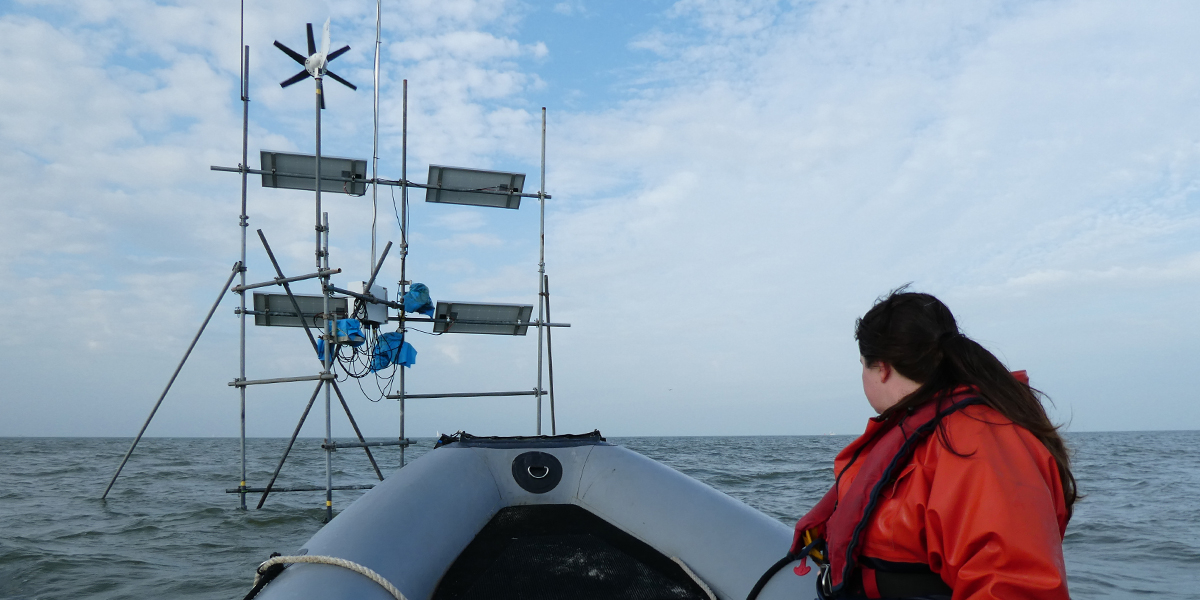
The 'Wadtoren'
While we were trying to fix the receiver, the Navicula and Canutus had set off crossing the ‘Blauwe Slenk’ heading towards Richel, westward of Griend. After a very bumpy ride crossing the wide gully in a rubber boat, Allert and Christine met with the rest of the team at Richel. In preparation of the catching expedition next week and building a receiver station later that day, they had just dropped off equipment at the ‘Wadtoren’. This is a hut on a pontoon that can be placed anywhere on the mudflat and serves as a base for our expeditions, citizen scientist bird watchers, as well as Natuurmonumenten’s Wadwachters. After the drop-off, everyone headed out to build another receiver nearby before the tide went be out.
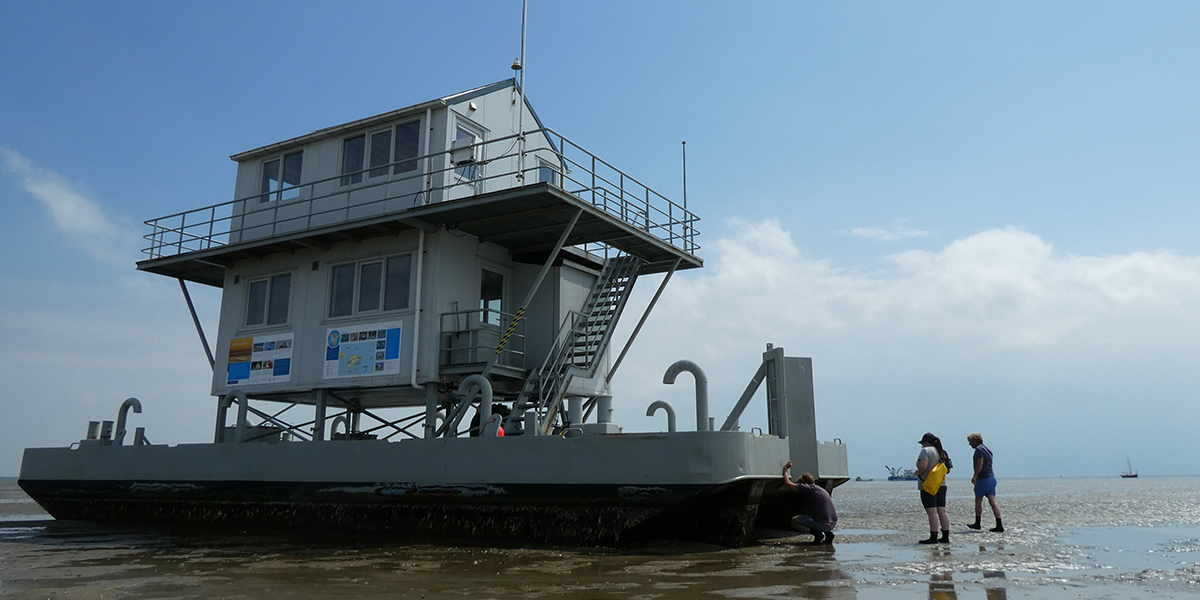
Twohundred cockles
Richel is a popular place for tourists, and many had sailed there in the morning waiting for the tide to go out. After building the receiver station, we headed out to the Wadtoren to mount the electronics. At low tide, many tourists were wandering around the exposed mudflat. Several curious tourists even climbed the Wadtoren to ask what we were doing. All of them were very interested in hearing about our research and amazed by the long distances these small shorebirds travel during their migrations. On the way back, Allert pointed out how rich the mudflat was with cockles, an important food source for many shorebirds. We immediately made use of this opportunity and sampled 200 cockles for an experiment at NIOZ.
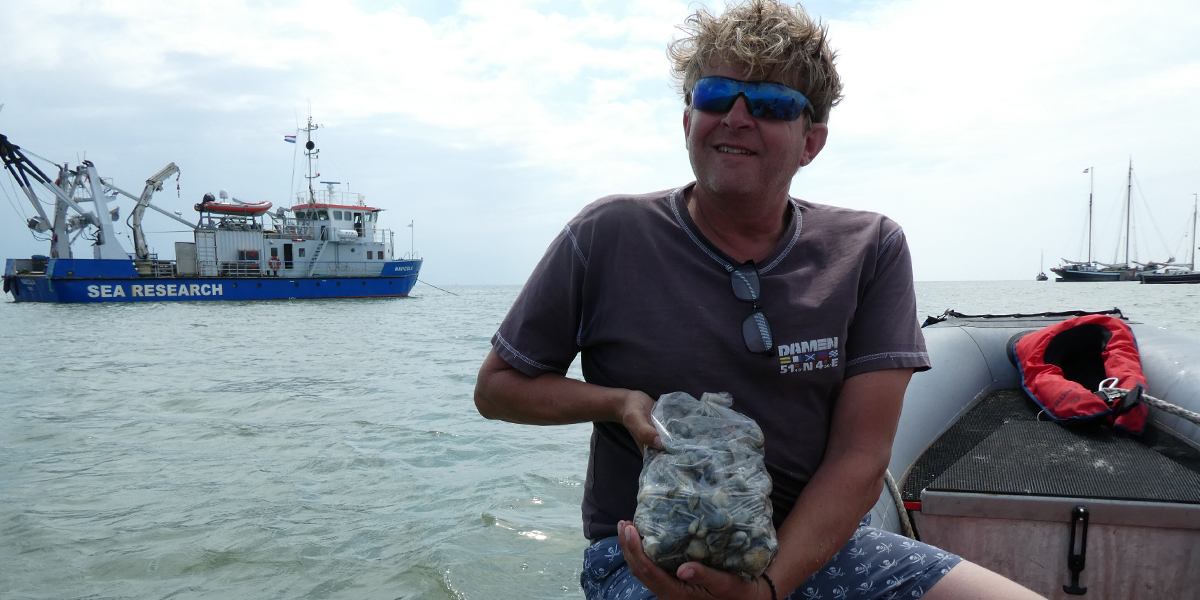
Armed with a new unit
On return to the Navicula, we crossed the gully and sailed towards Griend, back to the malfunctioning receiver station. Armed with a new unit, we were dropped off by Hein, in a rubber boat, as close to the receiver station as possible before they had to walk the rest of the way. The receiver was successfully replaced, but there were new problems with the internet connection. The tide was coming in rapidly, and Hein hurried back to the Navicula for a replacement antenna. Allert quickly mounted this before the tide pushed them back to the Navicula. As we docked the rubber boat, the Navicula headed towards het ‘Eierlandsche Gat’ where we would spend the night.
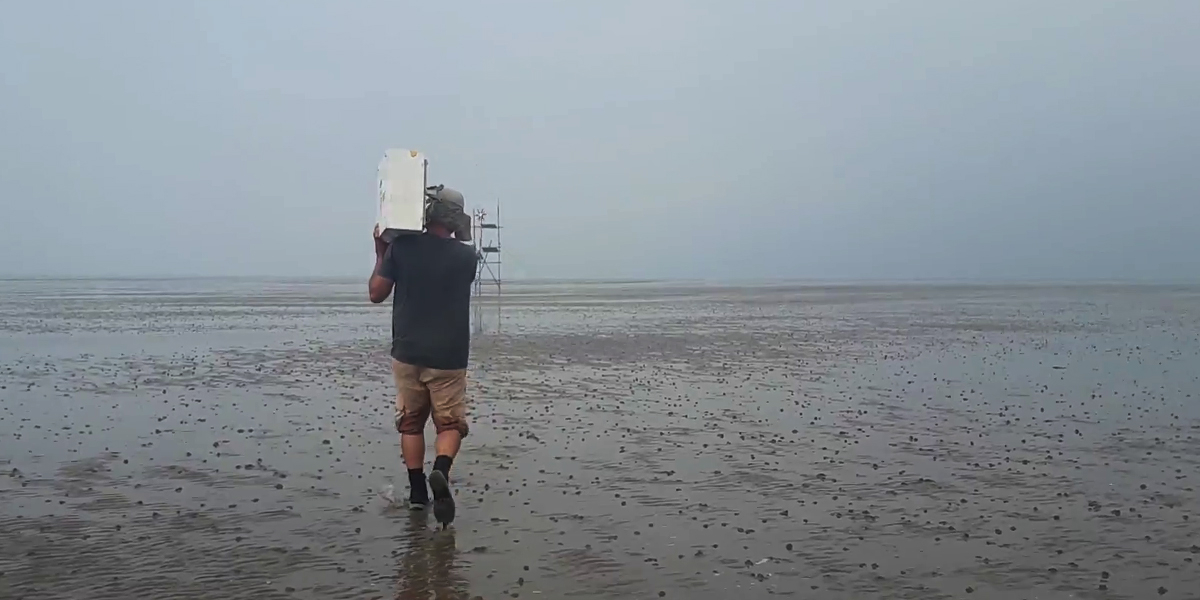
Friday 17 July I Day 5
By Allert Bijleveld and Chrisine Beardsworth
Today we completed the 50 extra SIBES sampling points, which will give us valuable information on prey availability for shorebirds, as well as contributing to the long-term monitoring project of invertebrates in the Wadden sea.
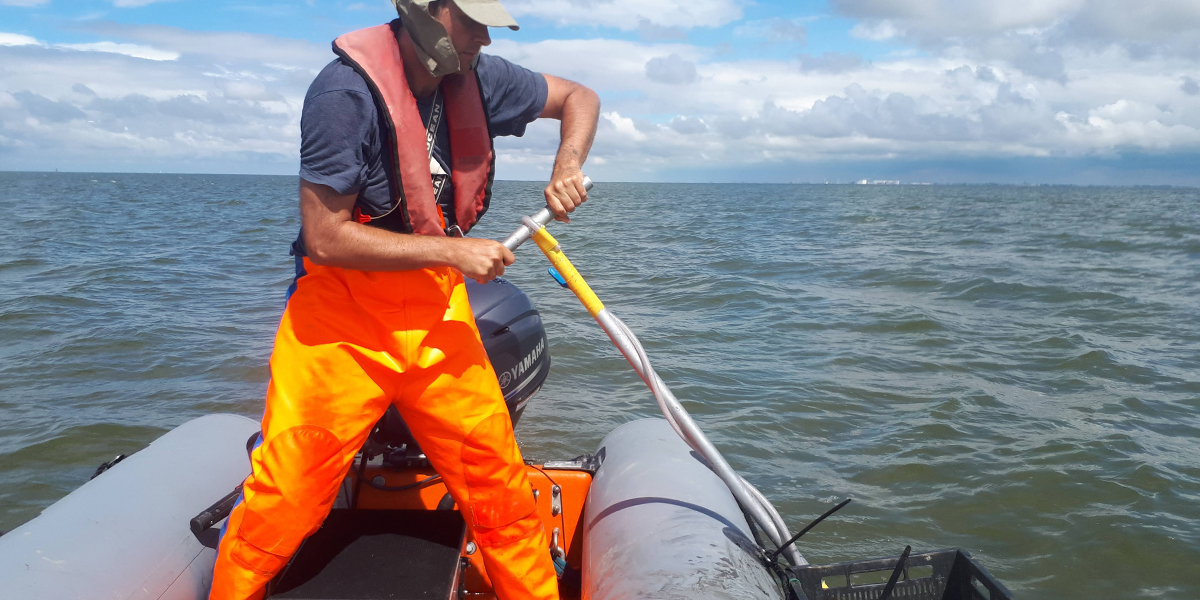
Short-lived fix
Another task for the day was to fix one of the receiver stations that we had set up only the previous day. We had noticed, using the incredibly useful monitoring app designed by NIOZ software engineer Bas Denissen, that one of our receivers wasn't detecting our 'test tag'. At low tide, we walked across the mudflat towards the station. After fixing the amplifier, the station was detecting tags again and we headed back to the Navicula. Unfortunately, it seems that the fix was short-lived and we will have to return another day to collect the unit and inspect it in more detail.
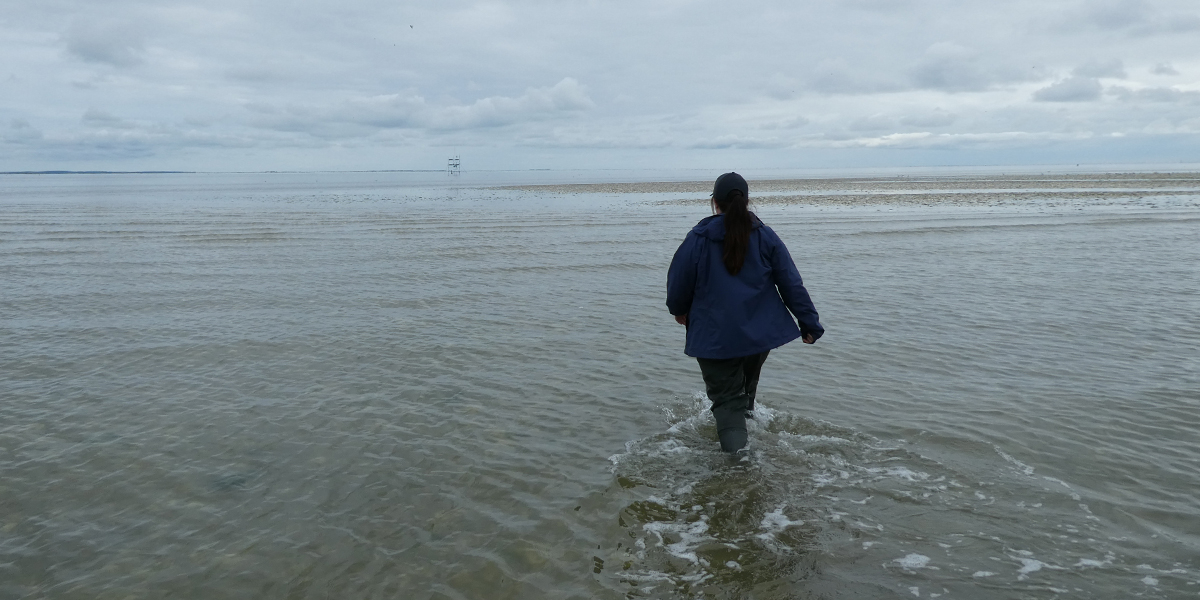
Dinner on deck
In the afternoon, we travelled to the two scaffolds that team Canutus had erected two days prior and fitted the electronics. While we could see showers in the distance, the weather was perfect, and we completed the stations with no issues. As it's Friday and we were smashing it, on our return to the Navicula we decided to eat dinner outside and celebrate with a beer.
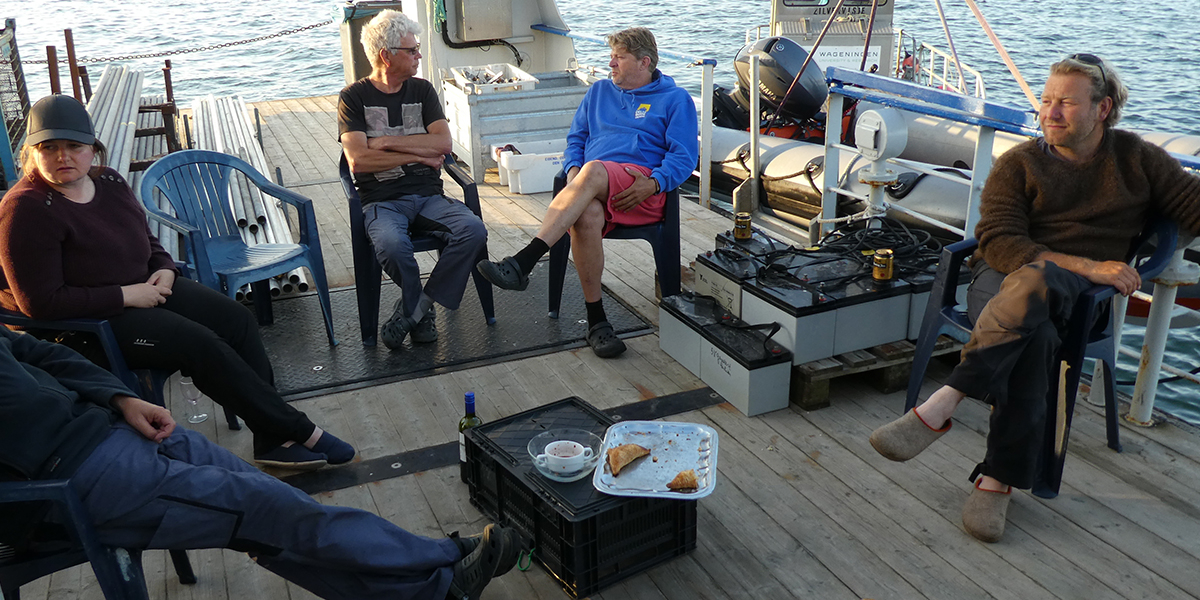
Thursday 16 July I Day 4
By Allert Bijleveld and Christine Beardsworth
Day 4 – On the morning of our fourth day of fieldwork we decided to sample more locations to add to our SIBES dataset for 2020 (see SIBES blog). We have recently noticed that, in 2019, foraging knots were moving slightly further North West and South of Griend than they did a few years ago (see encircled areas on the map). This could be because the mudflat itself has moved. The dynamic Wadden Sea ecosystem keeps us on our toes.
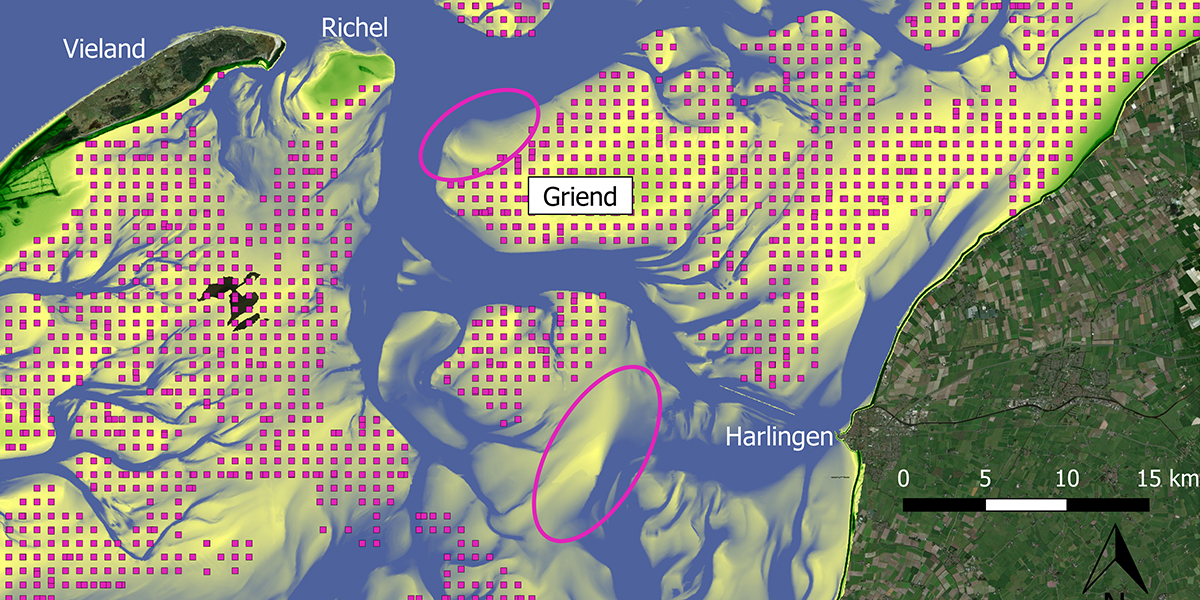
Sifting through mud
Allert took Christine on her first SIBES sampling expedition and explained everything from how to throw an anchor to sifting through mud to find cockles, worms and Baltic tellins. Their sampling was cut short however as Bram, the skipper, called on the radio to say that there was only a little time left before the depth at the potential locations for stations 5 and 6 was ideal for building.
Well oiled-machine
Team Canutus and Team Navicula went out together to build receiver 5. Because the planned location was just inside a mussel farm, the station needed to be relocated slightly. Team Canutus circled the area while sampling the water depth with their yard sticks. After some time, a shallow ridge was found with a water level of +70 cm, which was not ideal, but good enough. Team Canutus donned their waders and jumped in the water to begin building the scaffold like a well-oiled machine. In no-time, although slightly wetter than expected since some waves had entered their waders, they had built the scaffold and Team Navicula began decorating it with electronics.
Bram and Anne to the rescue
Finally, it was time to go to our last station of the day. On the way there we saw 7 grey seals foraging near the deeper regions of the Wadden sea. When we reached our destination, Team Canutus had just finished building the scaffold and we set to work adding the electronics. Unfortunately, our problem-free field season was about to come to an end. While moving one of the large batteries onto the scaffold with a pully, the handle came off and the battery plunged into the sea. Luckily, the depth was only ~1m so Bram, armed with his dry suit, dove in to retrieve it. (See the photo for his heroic efforts). However, this was not the only thing to go wrong today. In our rush to get to the next station before the tide began to recede, we had forgotten to pick up the WATLAS unit itself! Luckily, Anne came to the rescue (again) and interrupted his dinner to bring the unit to us in time to finish the station and get back to the Navicula.
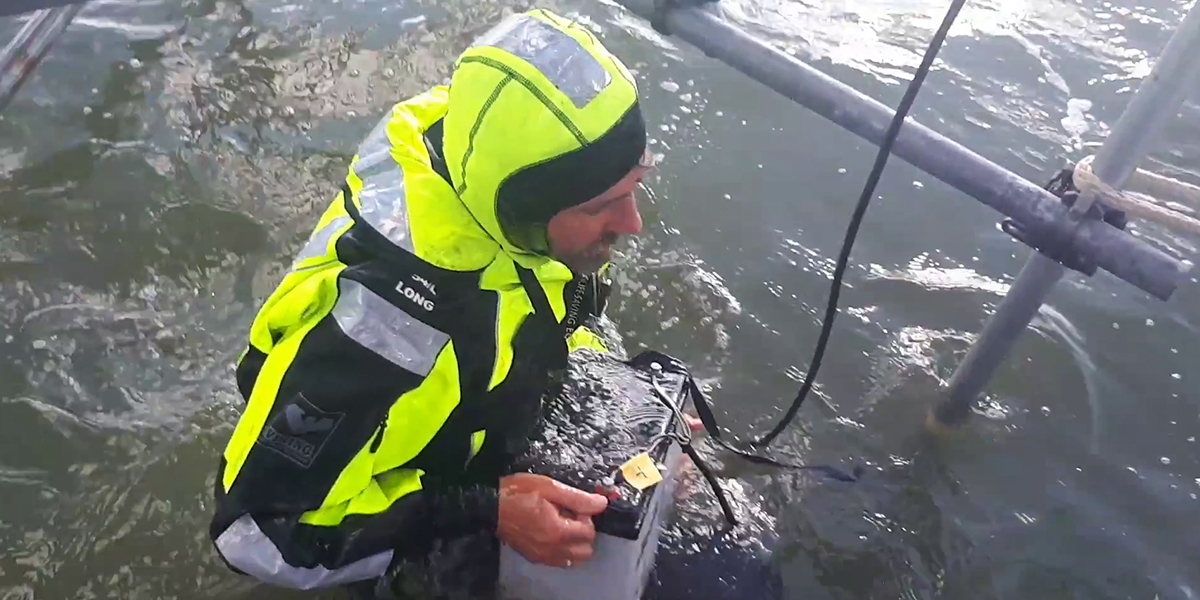
Shipping notice
By Bram Fey
Intensive period for the RV Navicula and crew
For this trip, we have three crew members: The skipper, a mechanic and a cook. In addition, we have room for three passengers, which would be eight in non-corona times. Because we have limited space, the crew helps with the project as much as possible including building the receiver stations. The ship is fully stocked with roughly 10 tonnes of building materials: Solar panels, windmills, antennas, large quantities of scaffolding pipes with associated couplings, 3 rubber boats and the borrowed aluminum boat “Zilvervisje” from Wageningen Marine Research. This is a flat barge with an outboard motor and steering hut. It can sail over 20 cm of water and take a lot of material with it. Crew members Hein and Bram take it to the location where the receiver stations are to be built. Cook Hendrik-Jan ensures that everyone on the ship is well fed. Over the last few days, the weather has been good with little wind. There has been the occasional shower, but this doesn’t hinder the work.
End of shipping notice ;-)
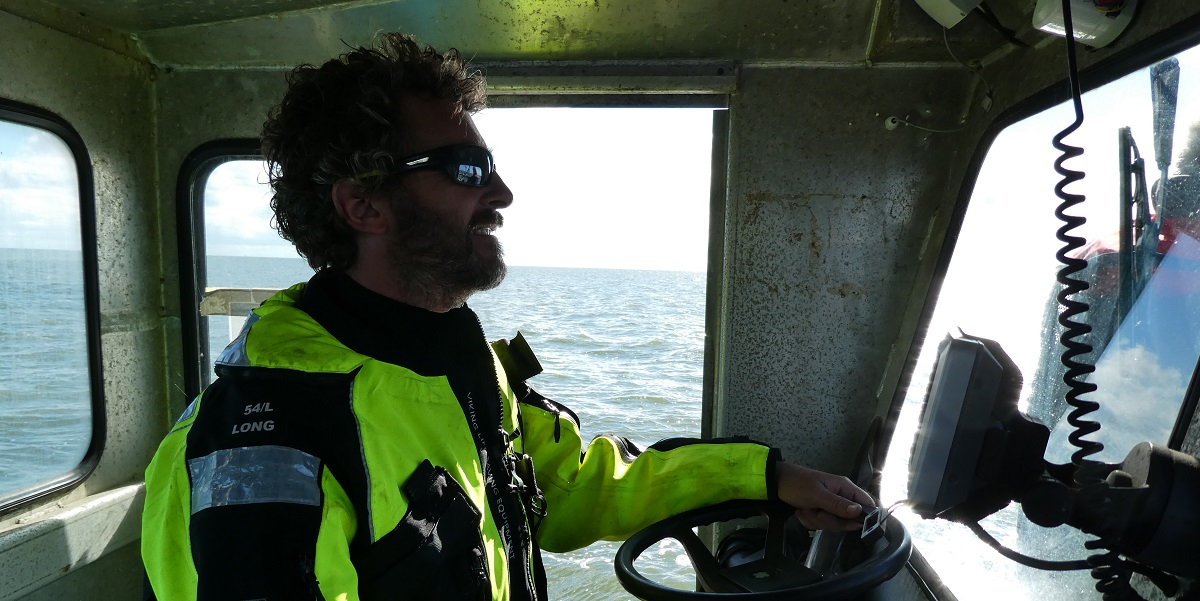
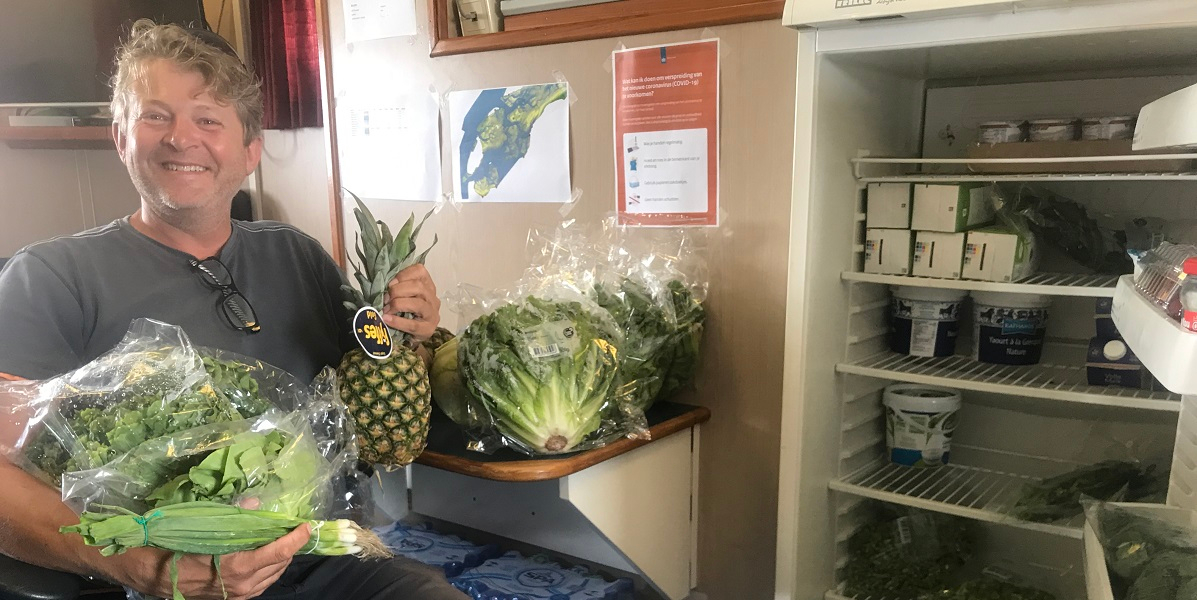
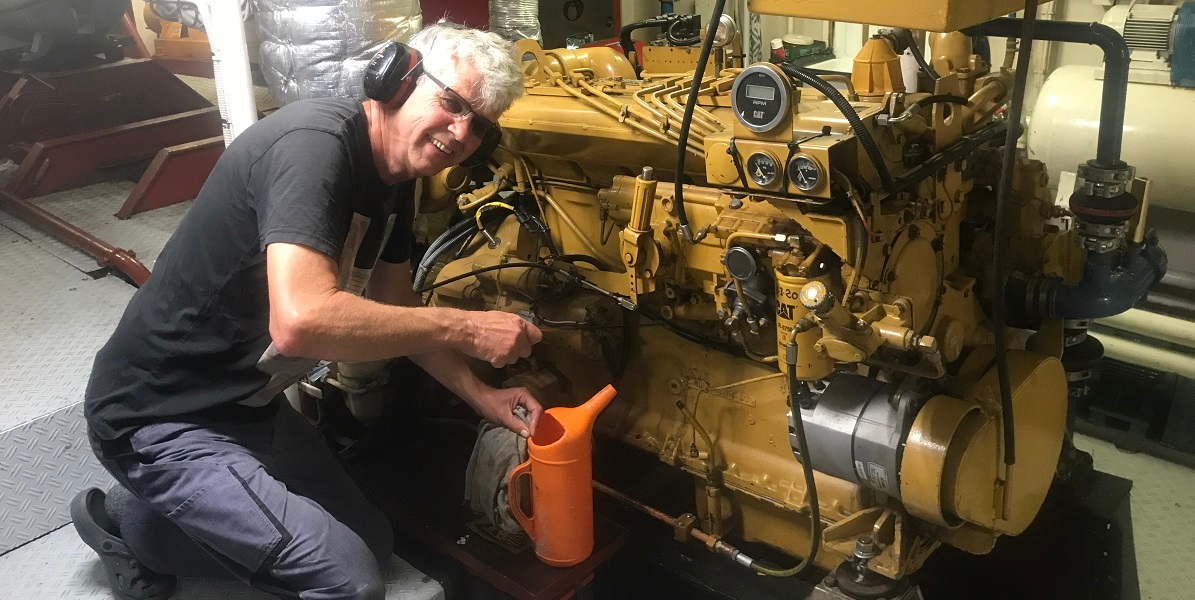
Wednesday 15 July I Day 3
By Allert Bijleveld and Christine Beardsworth
Our morning started with a visit from Wim Jan on the Stern, the smallest member of the NIOZ fleet, to pick up the equipment that we had previously collected from Griend. To the surprise of most of the team, Wim Jan also brought a mystery box with him. We got T-shirts! After PhD student, Misha, had designed a wonderful WATLAS logo, Allert ordered a batch of WATLAS t-shirts to celebrate the occasion. After a brief photoshoot, it was time for the fieldwork.
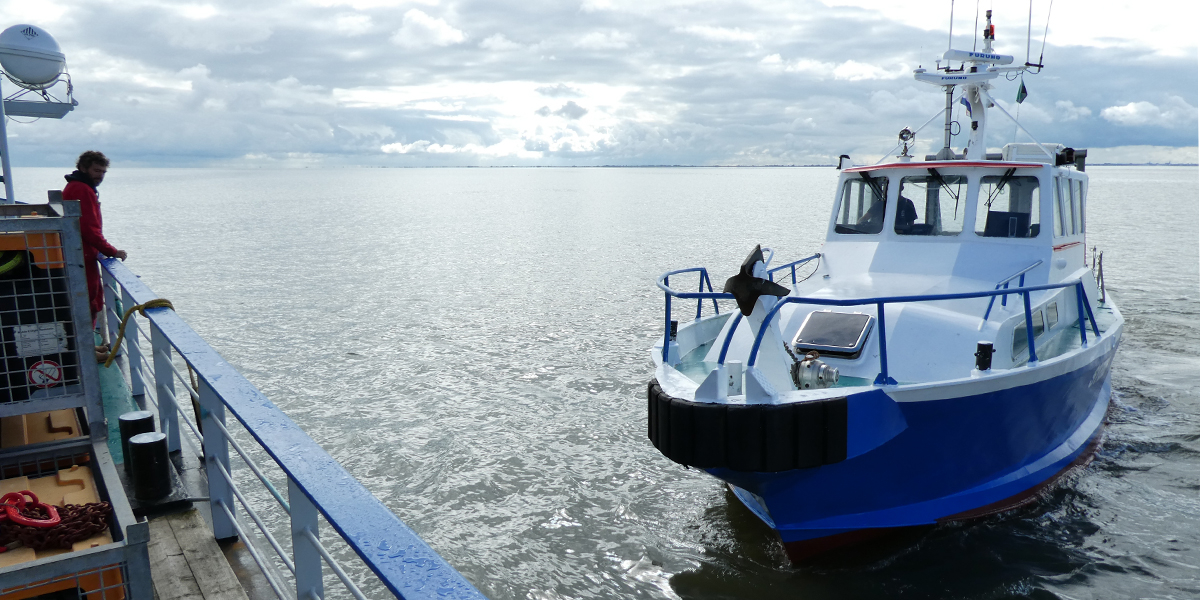
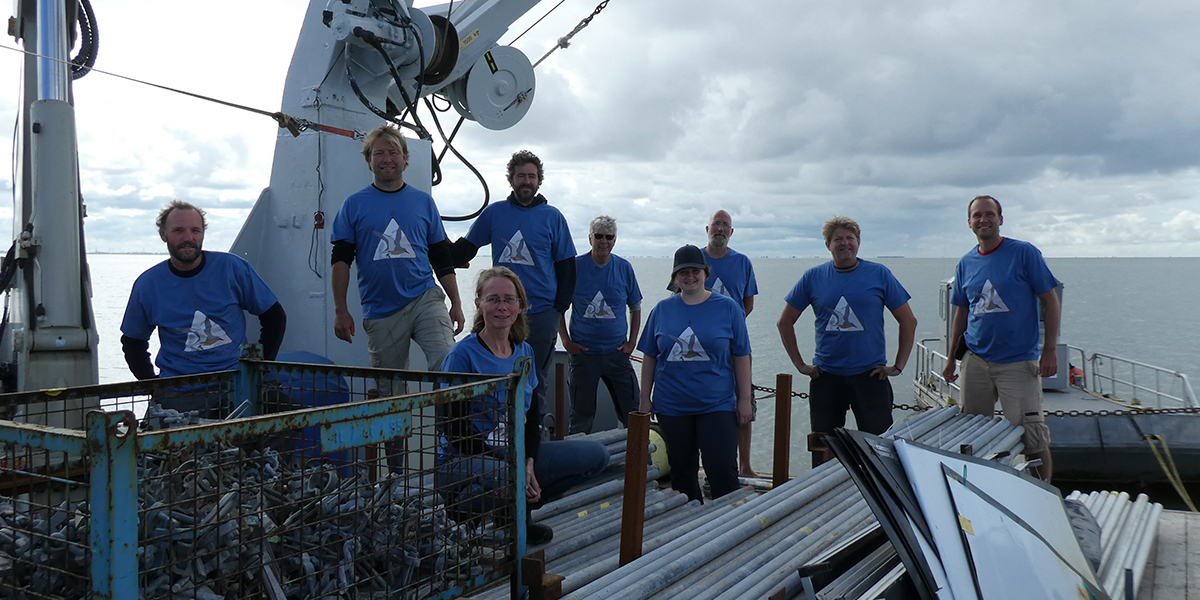
More receivers
The previous day, team Canutus had been extra efficient and built the majority of the scaffold for receiver number 2, before the tide pushed them back to their ship for the night. Now, team Canutus headed off to build the scaffold for receiver numbers 3 and 4. Team Navicula sailed towards receiver 2 to finish the scaffold and attach the electronics. In the sun, the work was pleasant, and we soon finished receiver 2 and went back to the Navicula to stock up on electronics for receiver 3.
Interesting visitor
While we were finishing the receiver station, we had two interesting visitors. Two harbour seals were foraging near the boat and had a quick look at the researchers before going back to their own business. It was a nice end to another day in the field.
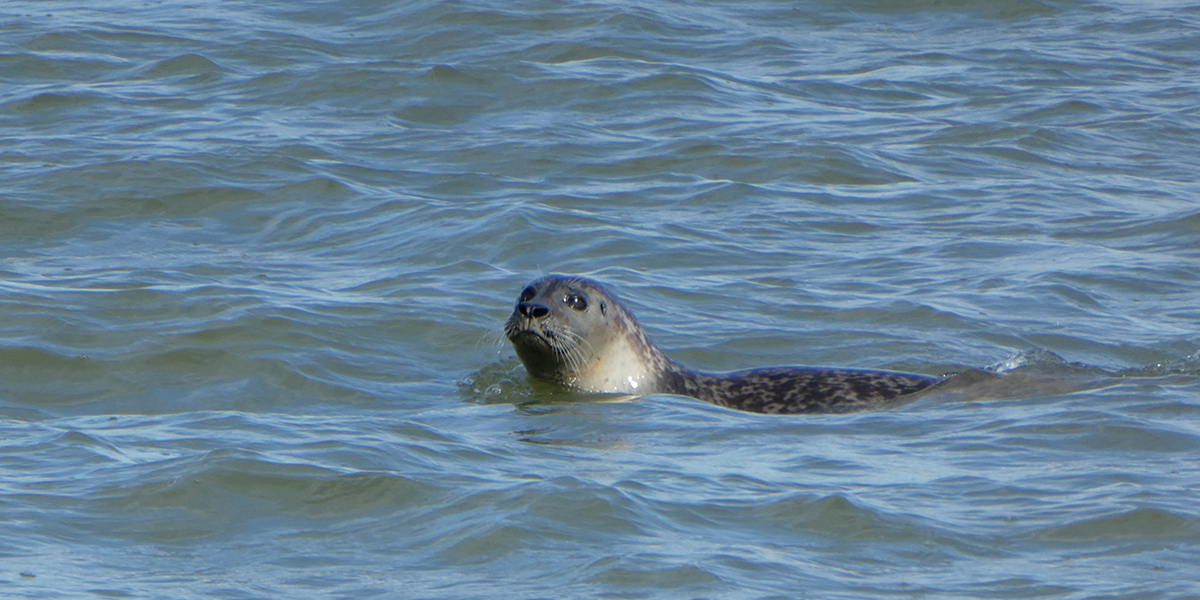
Tuesday 14 July I Day 2
By Allert Bijleveld and Christine Beardsworth
In the morning, we headed towards the uninhabited island of Griend and anchored the Navicula a couple of kilometres southeast of the island. Griend provides an important high-tide roosting site for a wealth of birds such as migratory shorebirds and is the focal location for our tracking project. Later in the year we will catch and tag red knots on the island, but today we went only to collect some equipment. The shallow waters around the island at high tide mean that we must wade through the water for the final stretch.
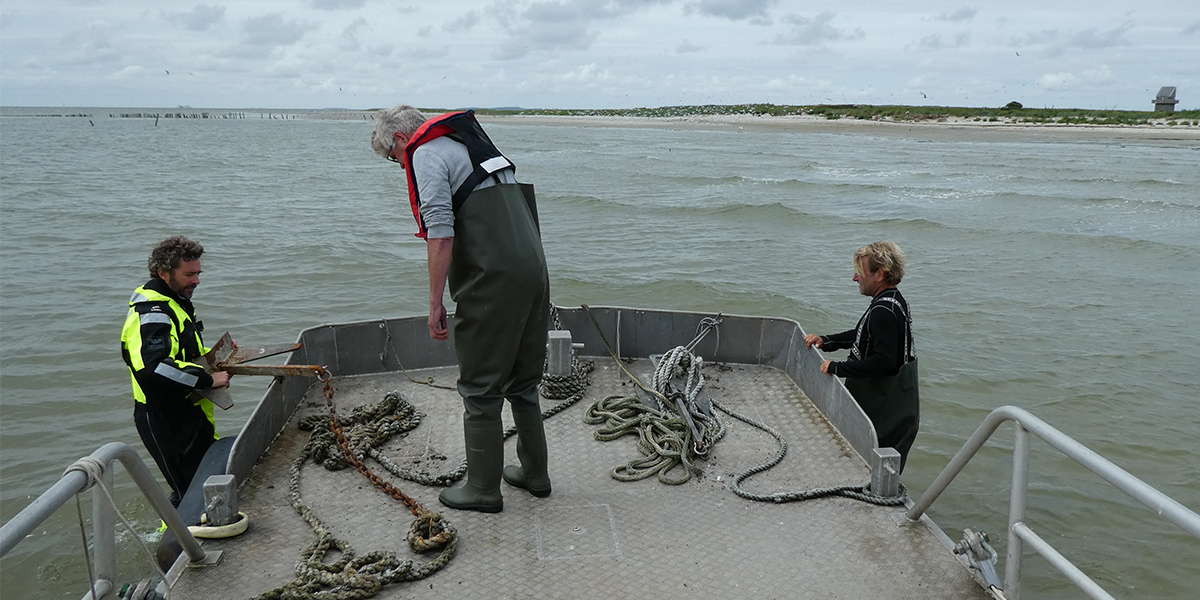
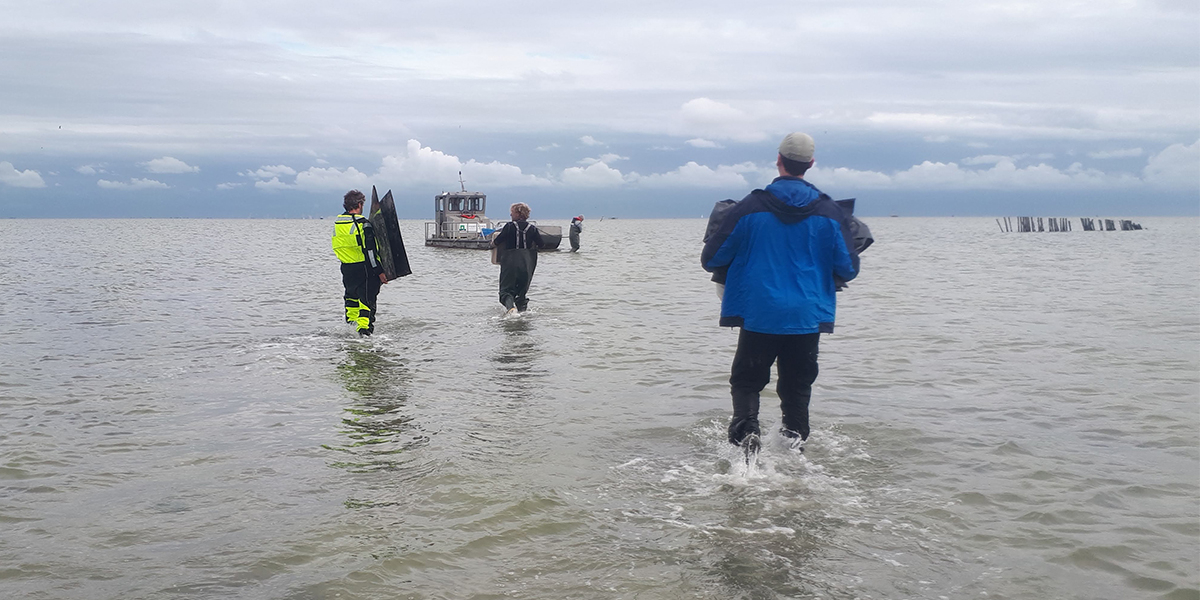
The wardens of Griend
There is a small house on Griend owned by Natuurmonumenten who manages and protects this nature reserve. From here, researchers can study the spectacular nature on and around the island. At the house, we were greeted by Date and Giny who are the wardens of Griend during the breeding season. After a nice chat, they helped us to wheelbarrow our equipment back to the shoreline so that we could load our boat.
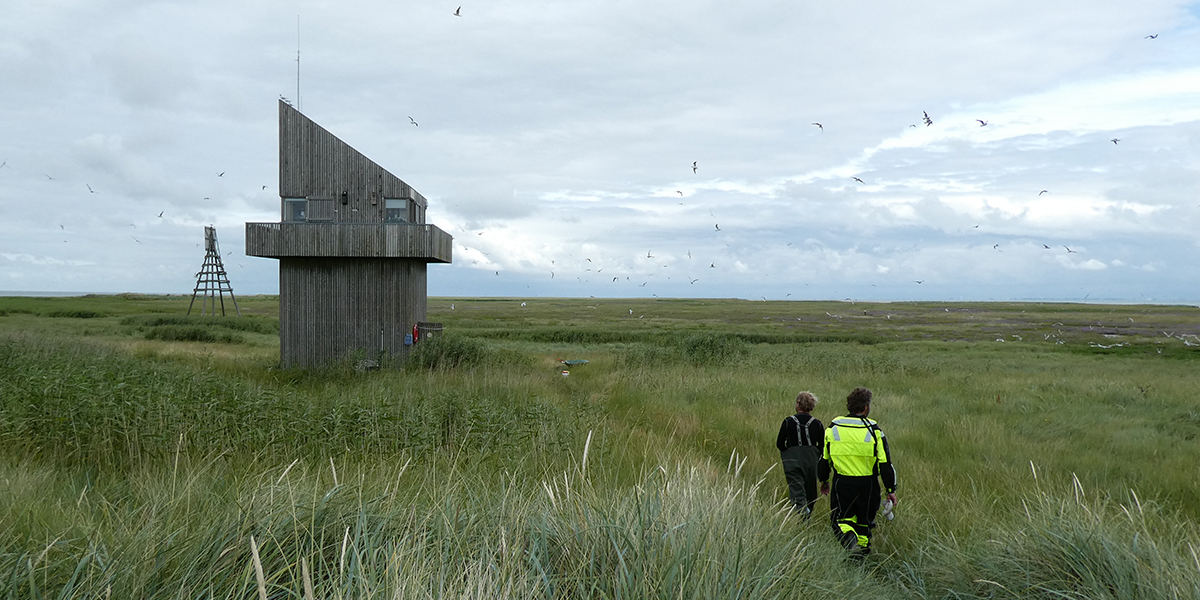
Team Navicula and Team Canutus
The next goal for the day was building a temporary receiver station. Due to corona, the Navicula is working at minimal capacity to ensure social distancing can be maintained. However, some tasks require people to be close together, such as inserting the six-meter scaffolding poles into the dense sand. Thankfully, NIOZ staff Anne and Anita, along with their family Cornelis and Hinke, have come to the rescue with their own ship: Canutus. While we, team Navicula, had been collecting equipment on Griend, team Canutus had been building the scaffold for our first temporary receiver station of the year.
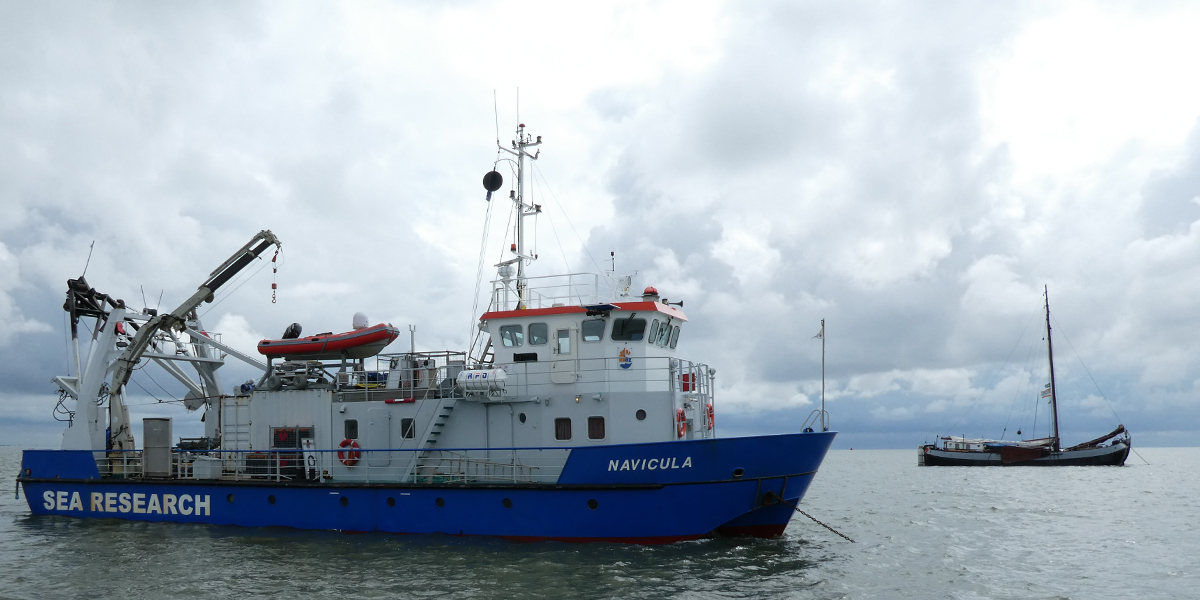
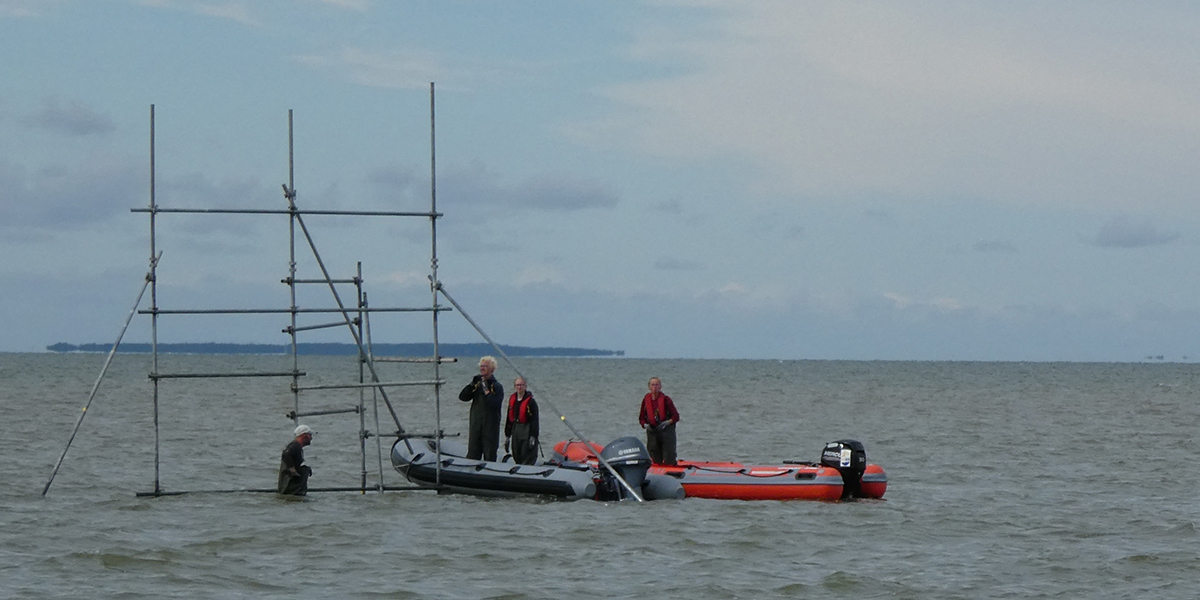
Temporary Receiver Station
After our return from Griend, we fitted the electronics to the completed scaffold: one wind turbine, four solar panels, three batteries, a light, the WATLAS antenna and finally, the WATLAS unit itself. Since the tide had started to go out, we needed to get back to the Navicula where Hendrik-Jan, the Navicula cook, had dinner ready.
Monday 13 July I Day 1
By Allert Bijleveld and Christine Beardsworth
After spending the morning loading the ship in the NIOZ harbour with scaffolding, solar panels and wind turbines, we set off.
Our first port of call was Vlieland, to replace one of our permanent receiver stations. This particular receiver is placed in the roof of the Posthuys hotel, giving the antenna a high probability of detecting tagged red knots in the vicinity. After anchoring the Navicula offshore, crew member Hein sailed us to Vlieland and we got a taxi to Posthuys. With help from the friendly staff we were able to replace the unit in the attic.
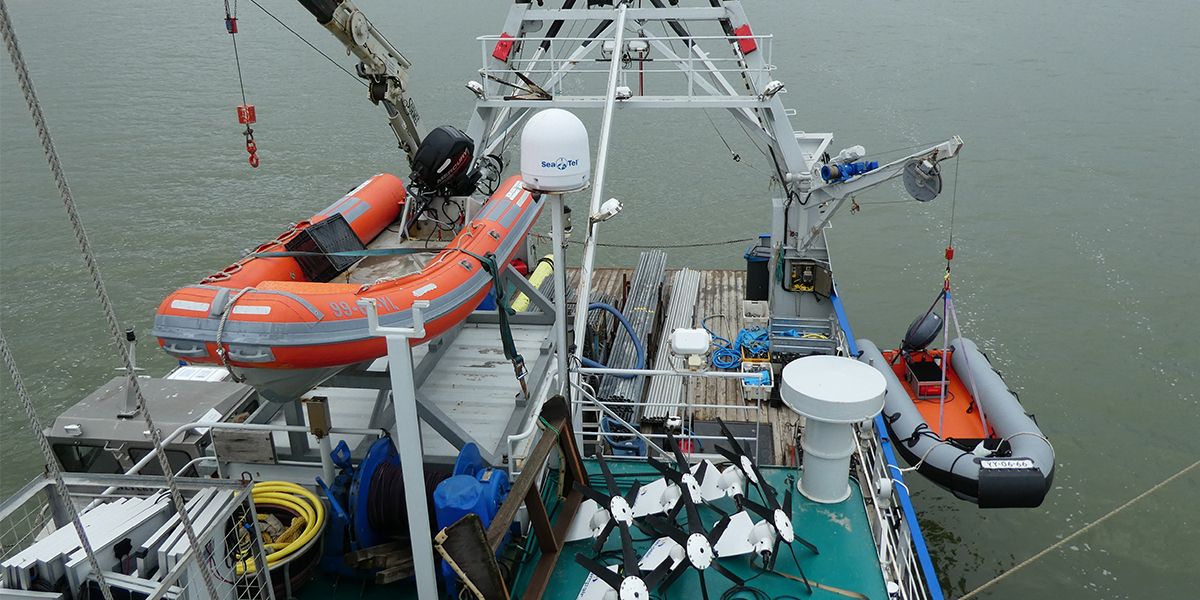
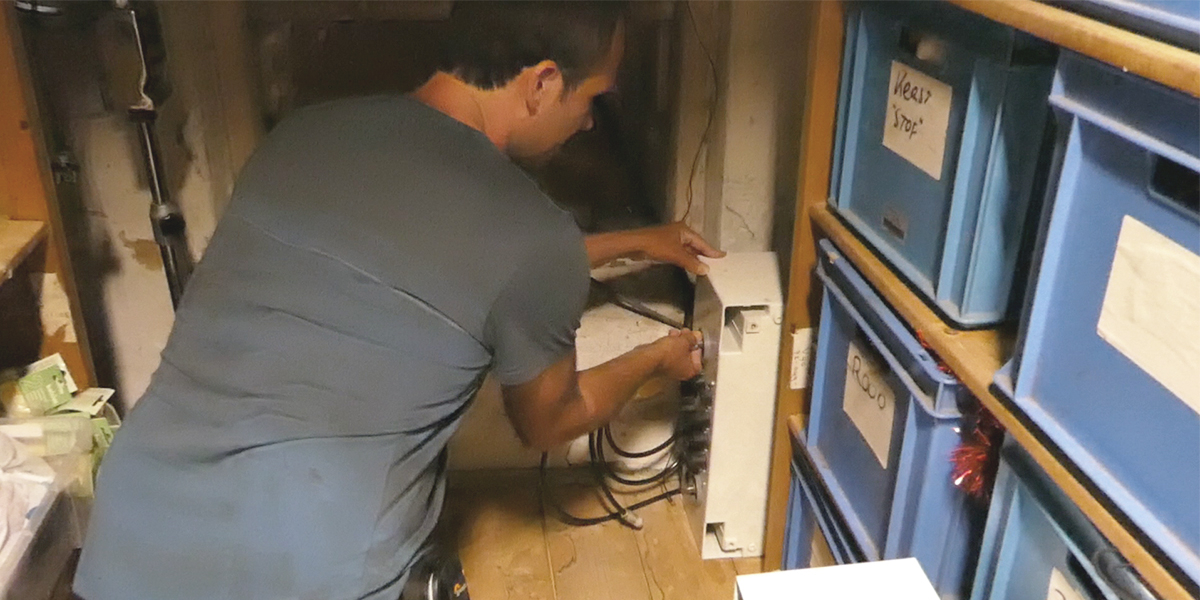
After some successful tests (and some support from the 24/7 WATLAS Helpline – Frank) we headed back to the Navicula for the night.
